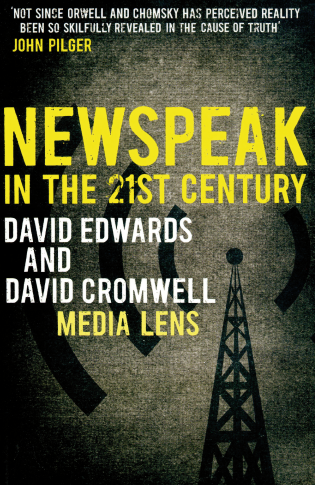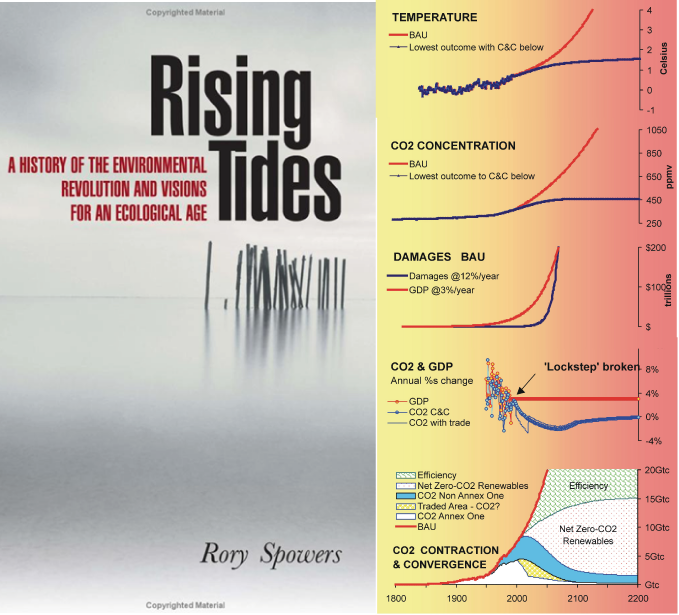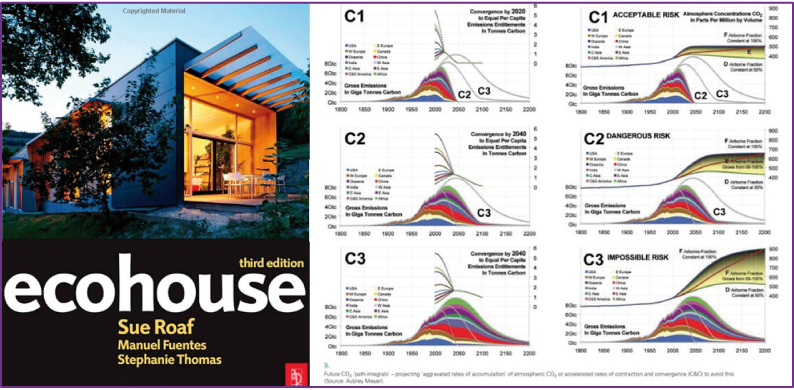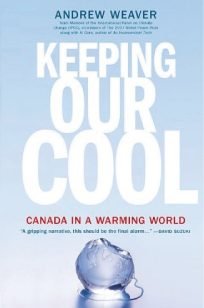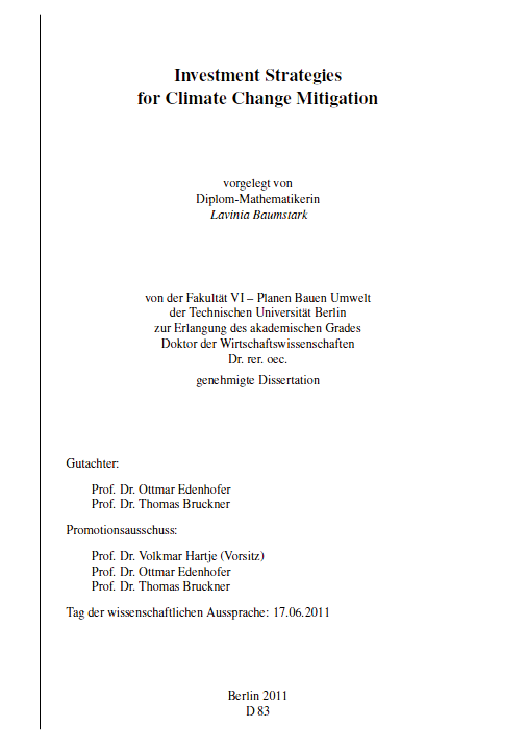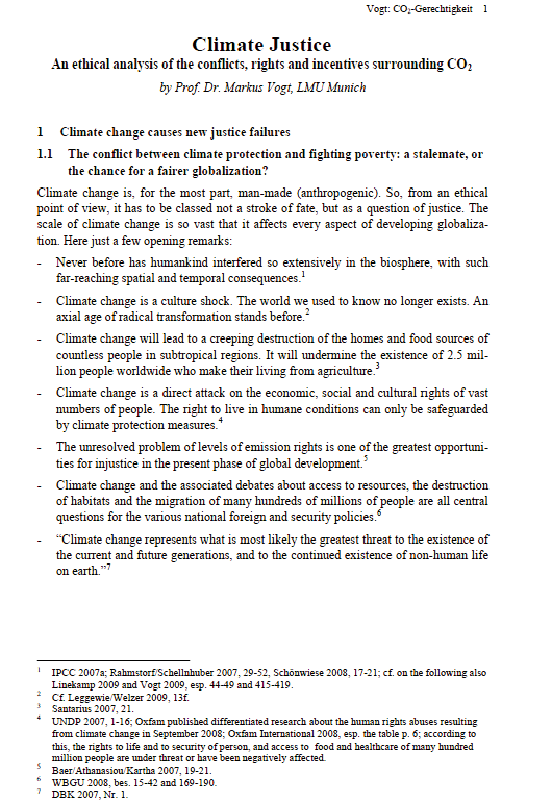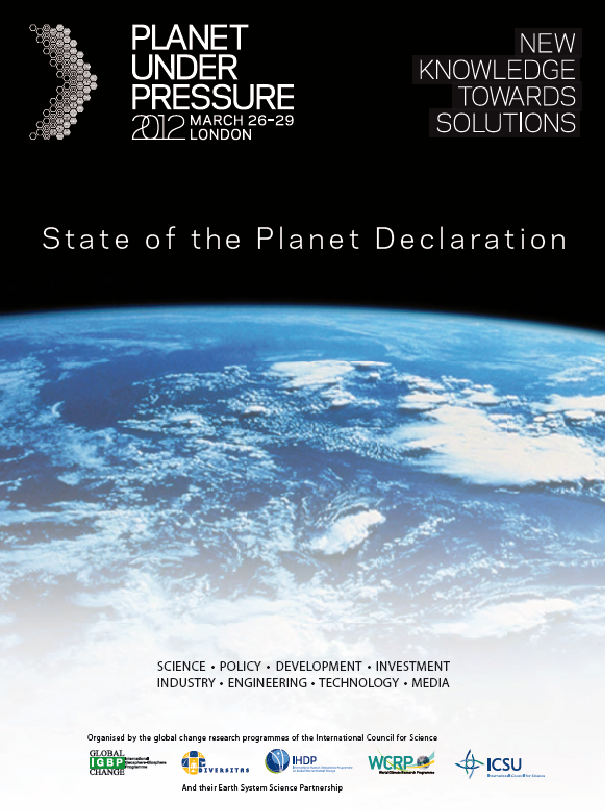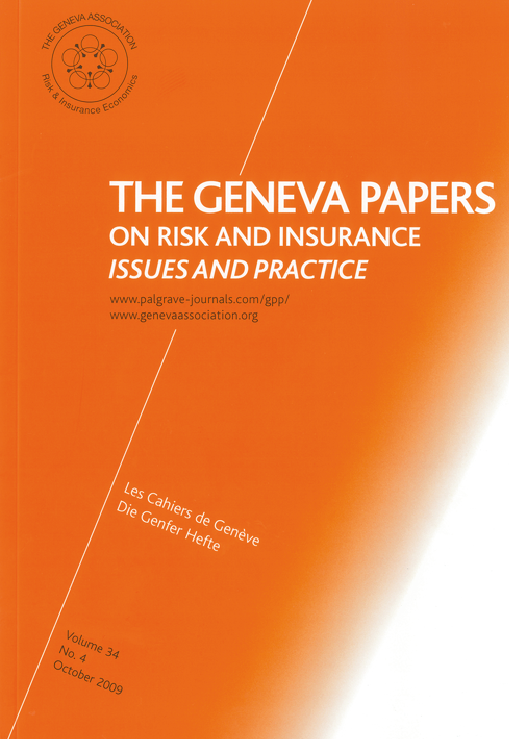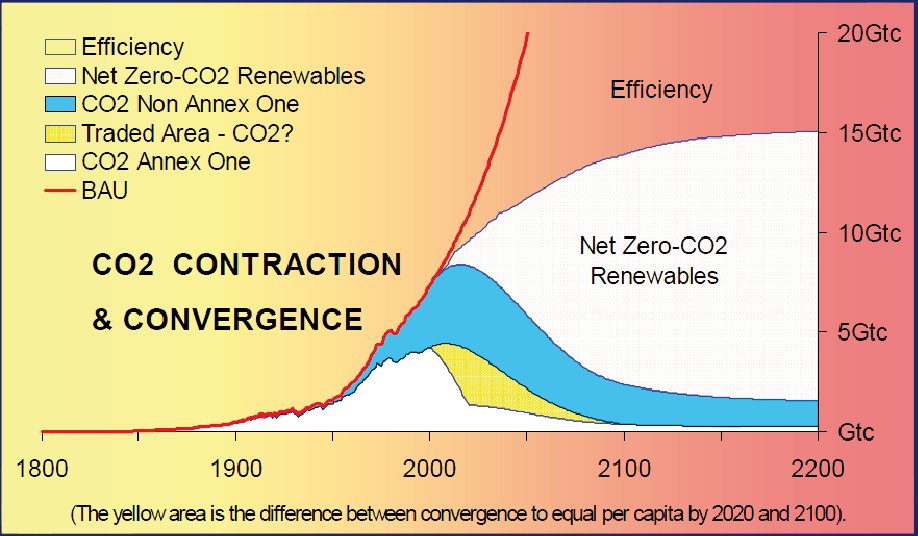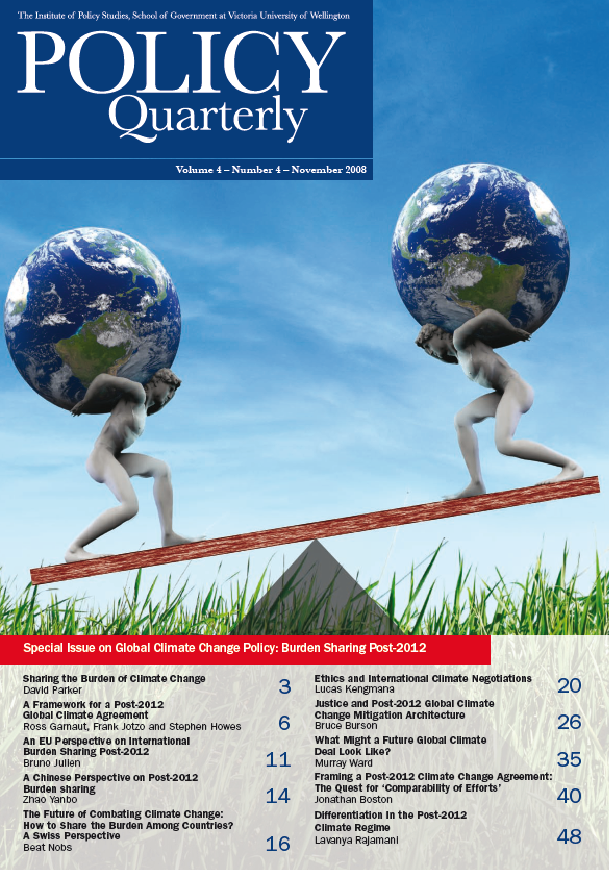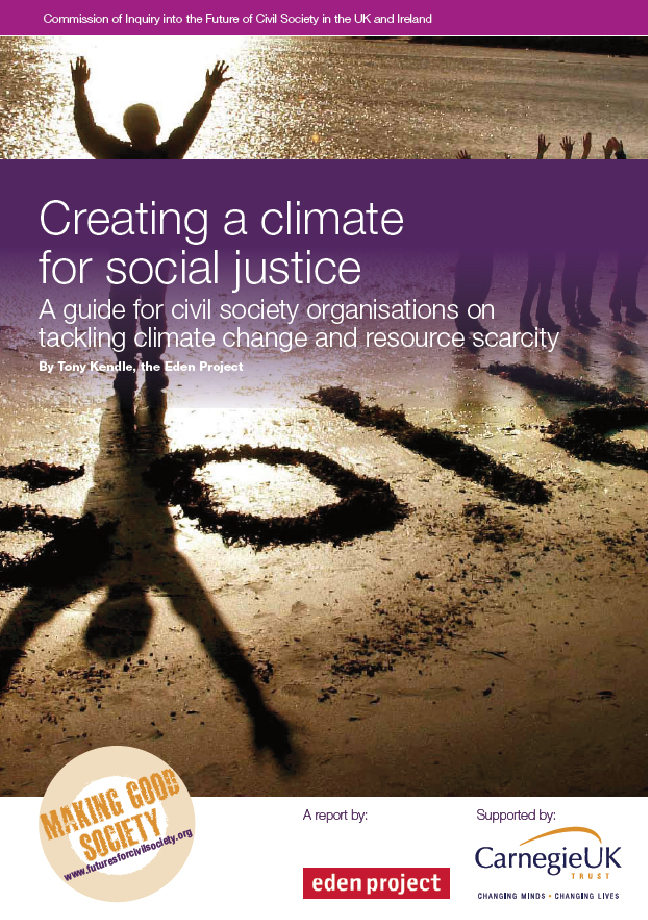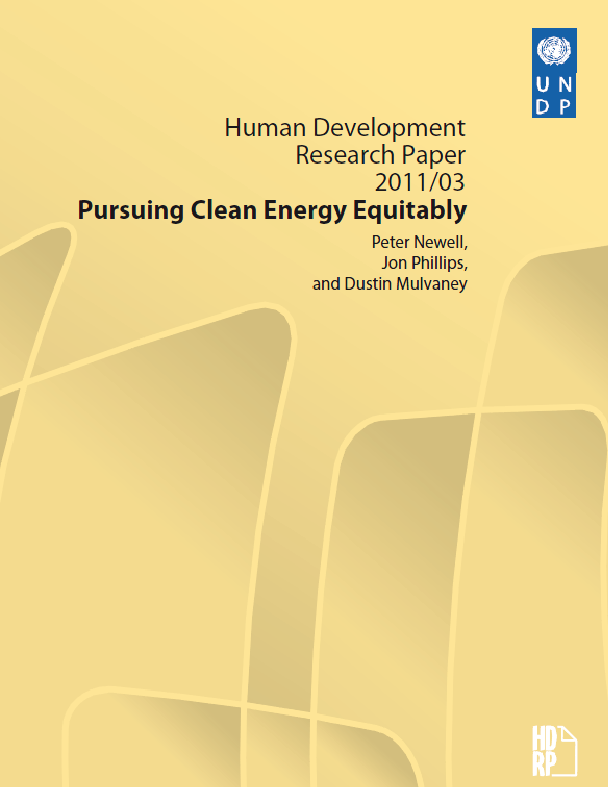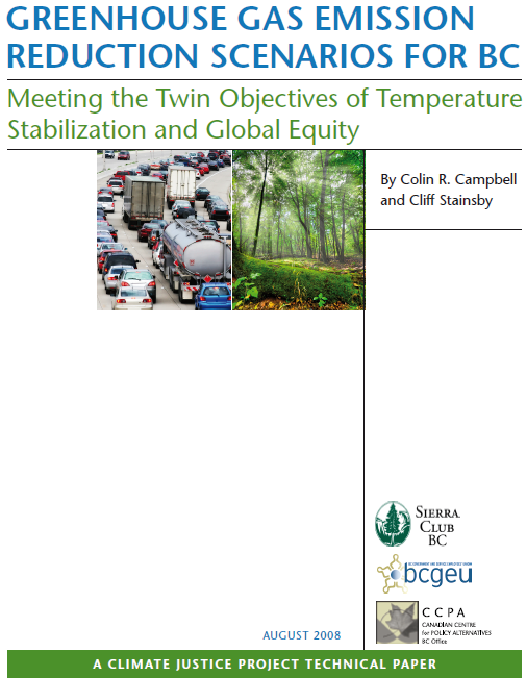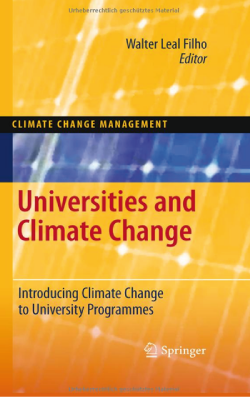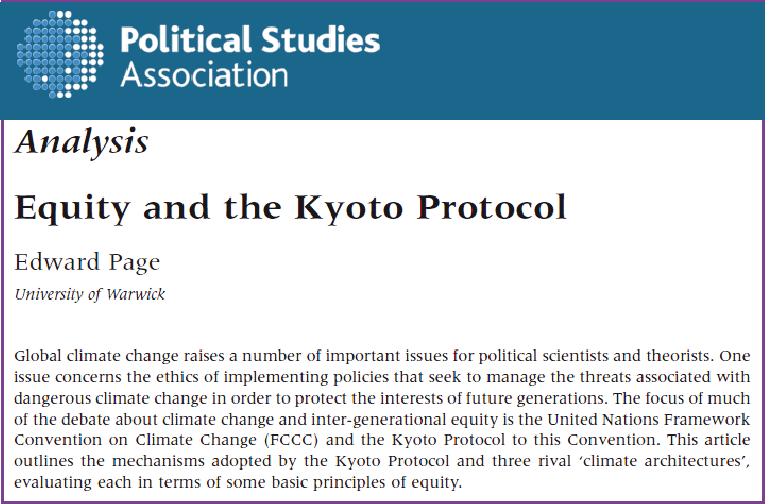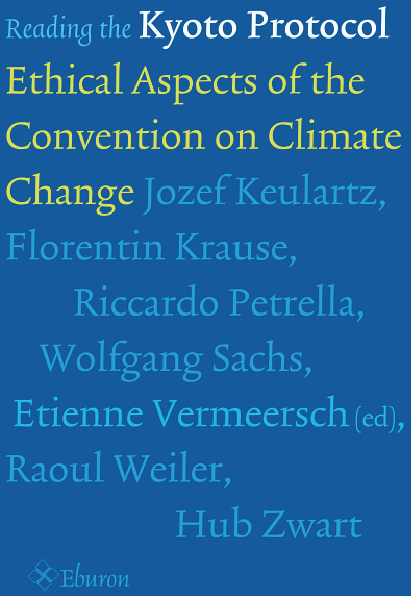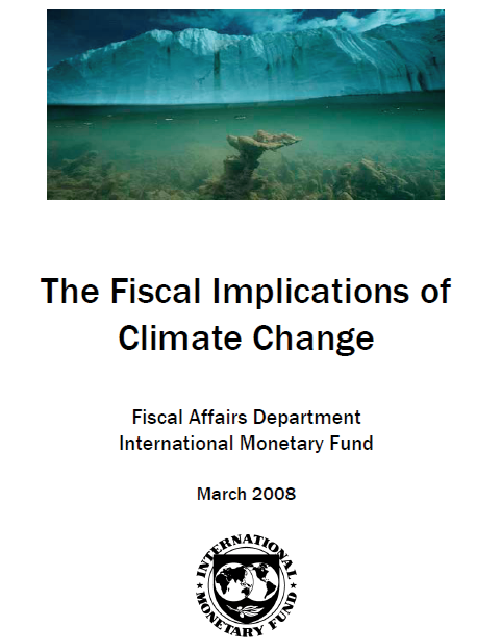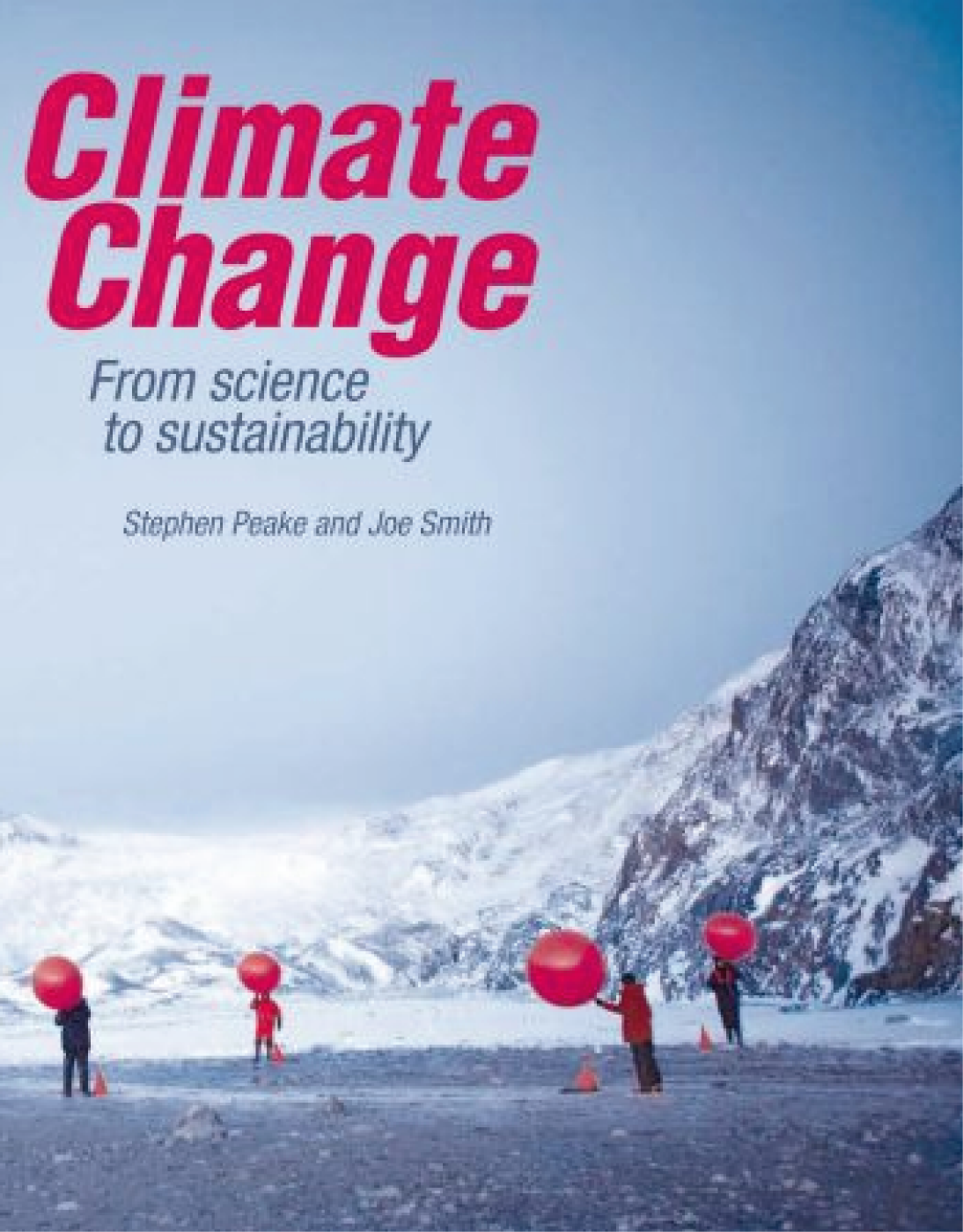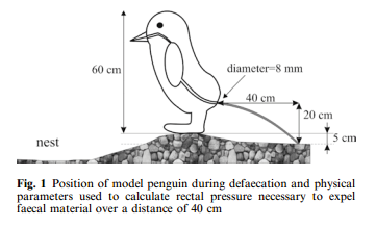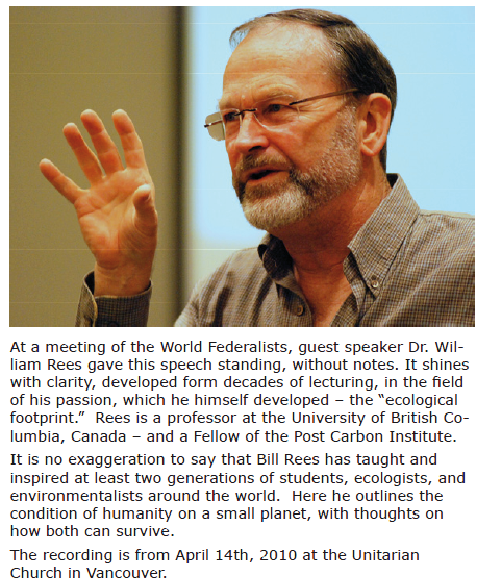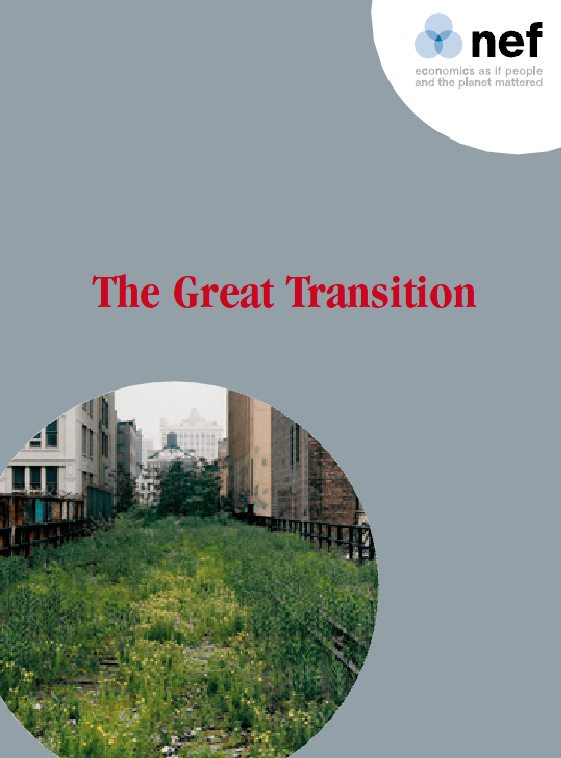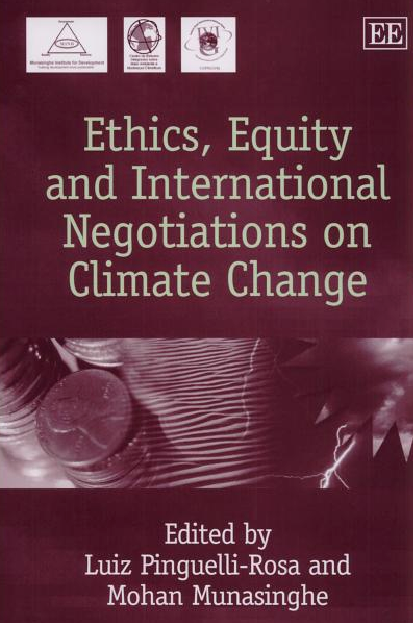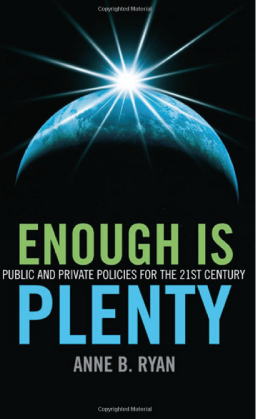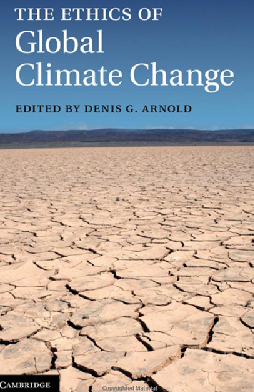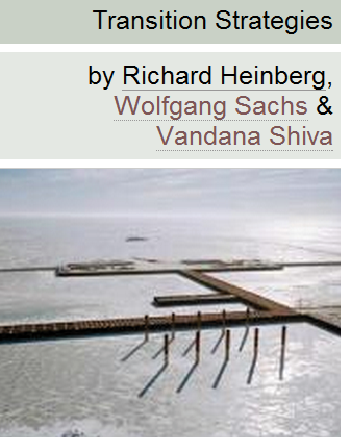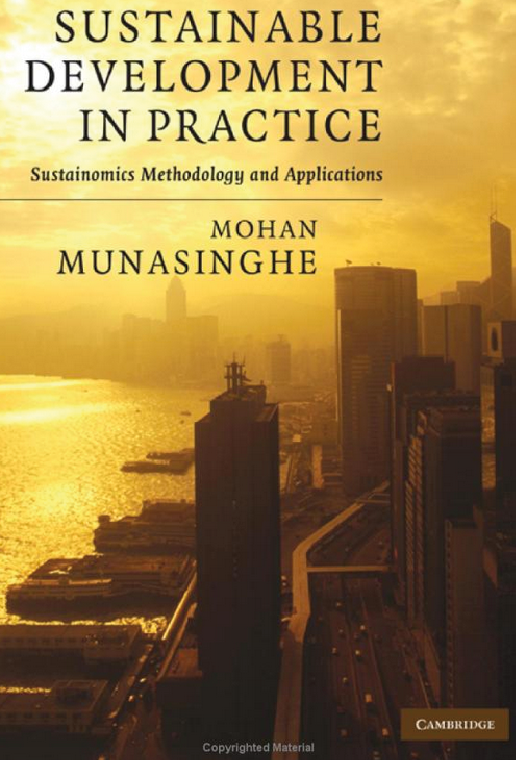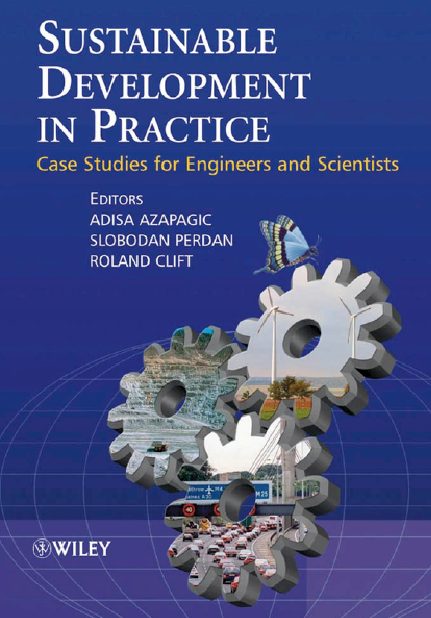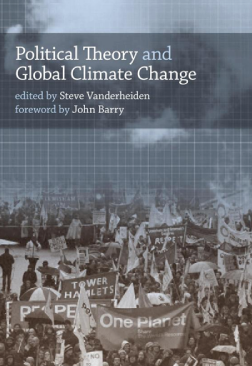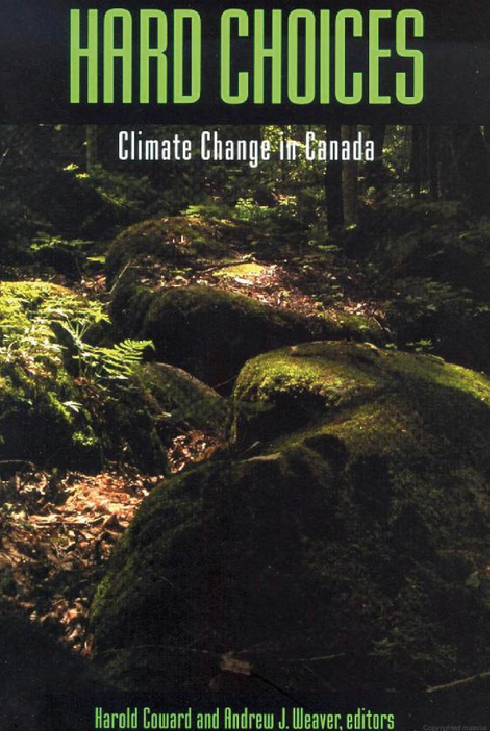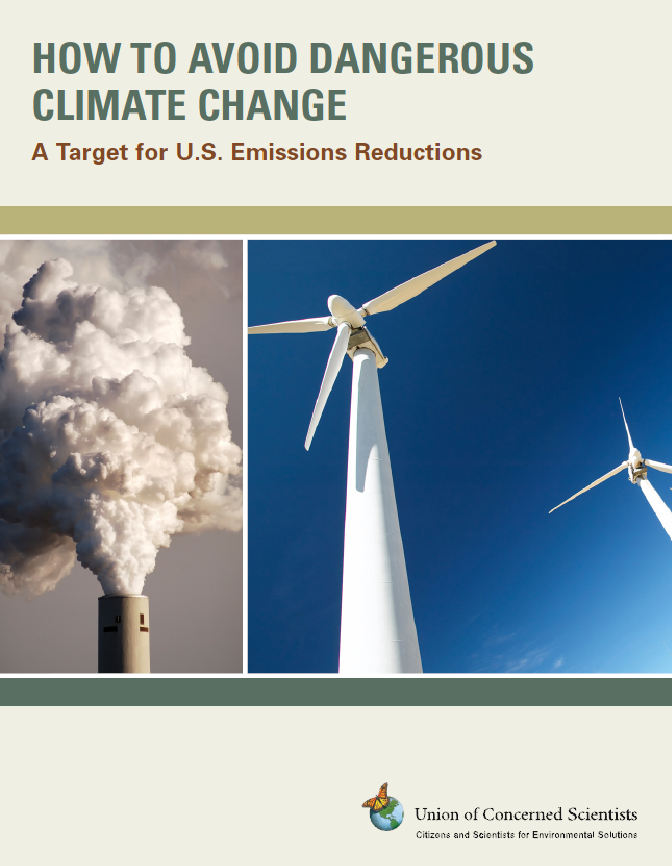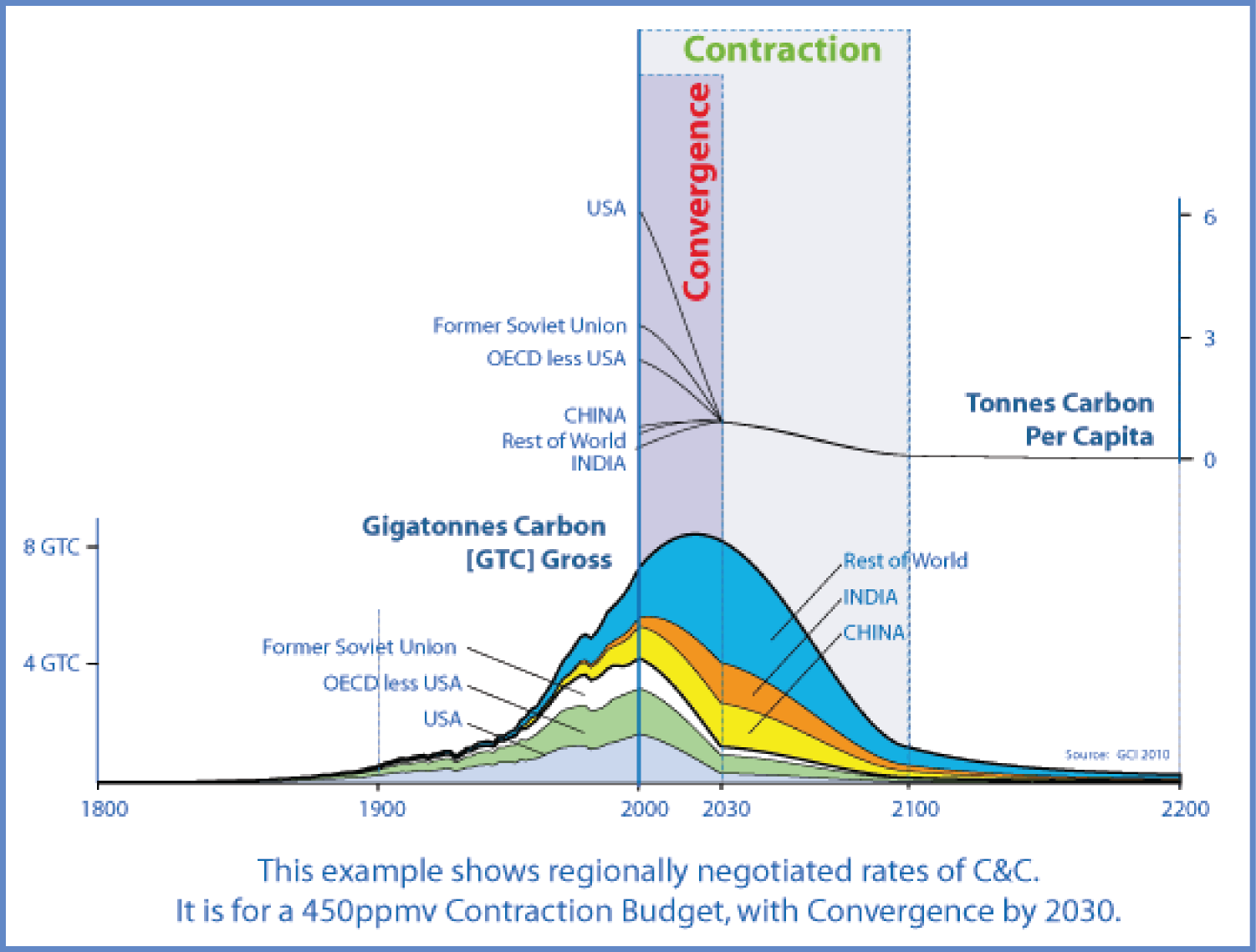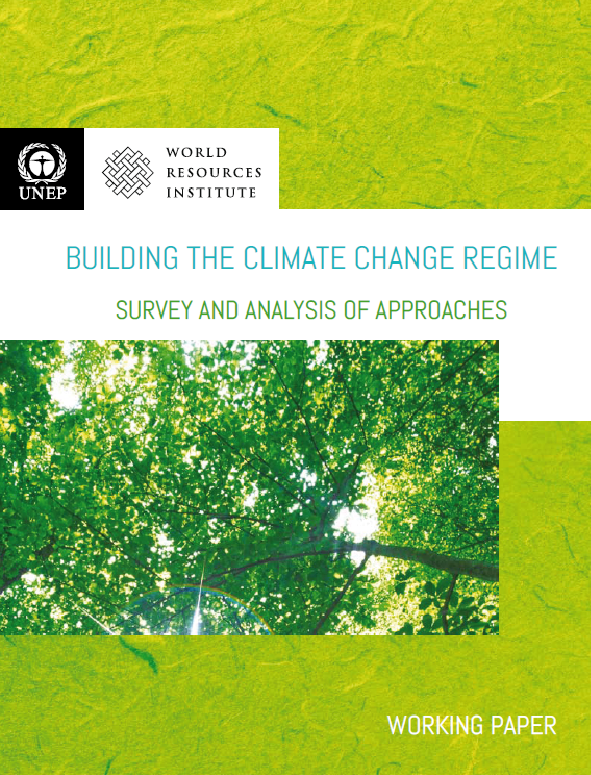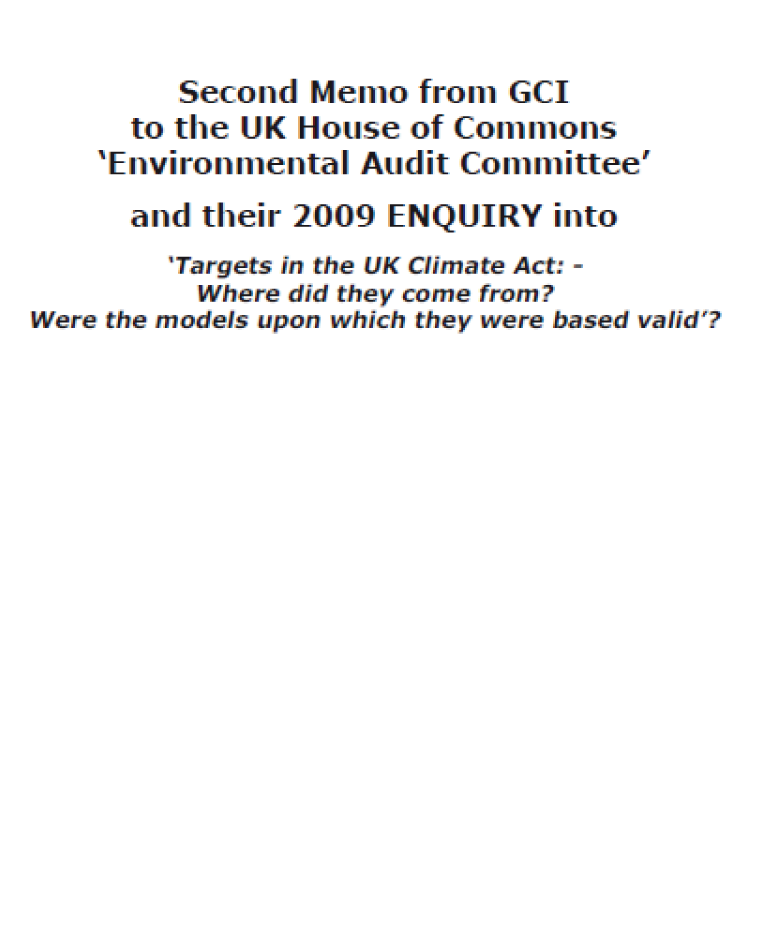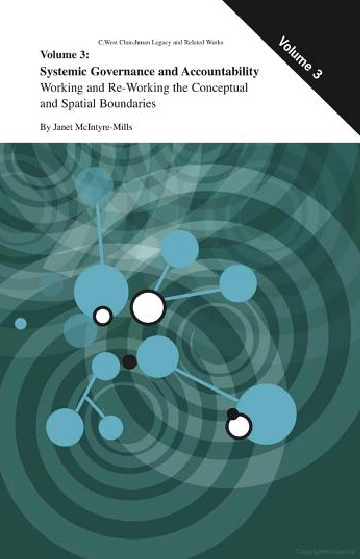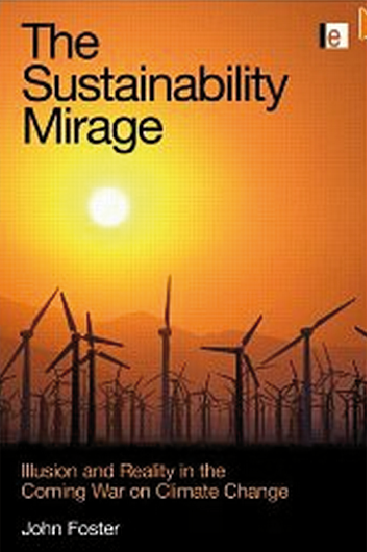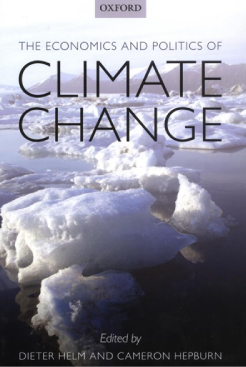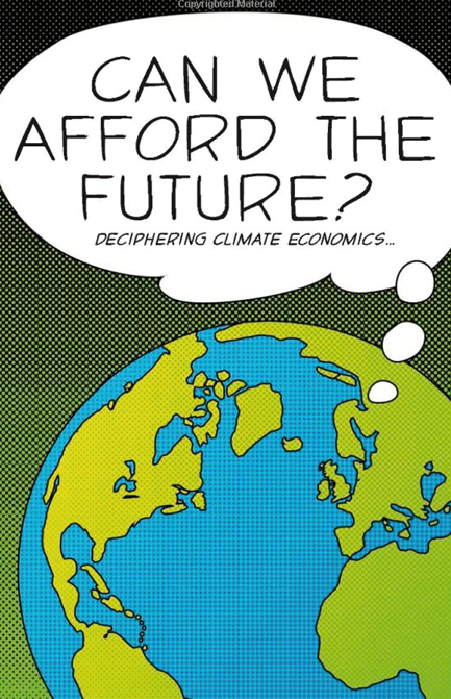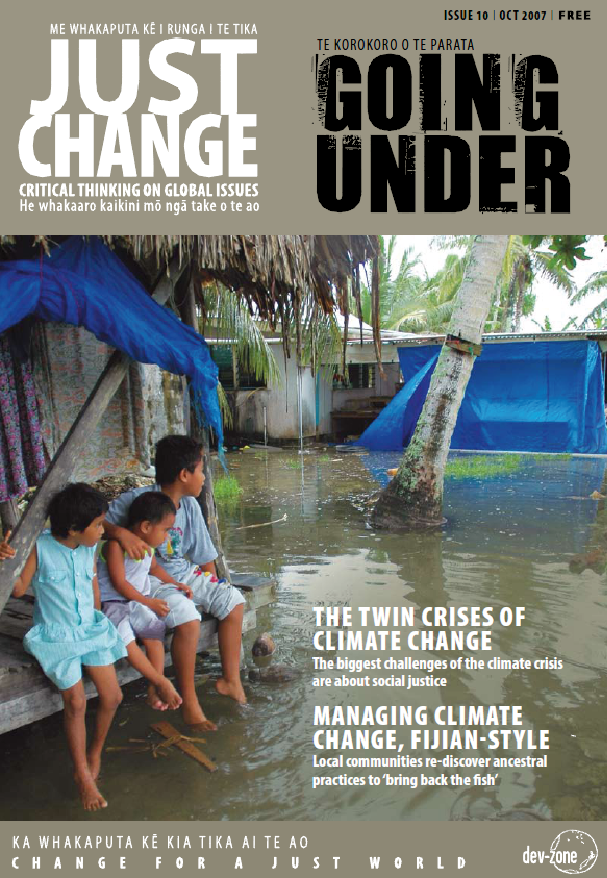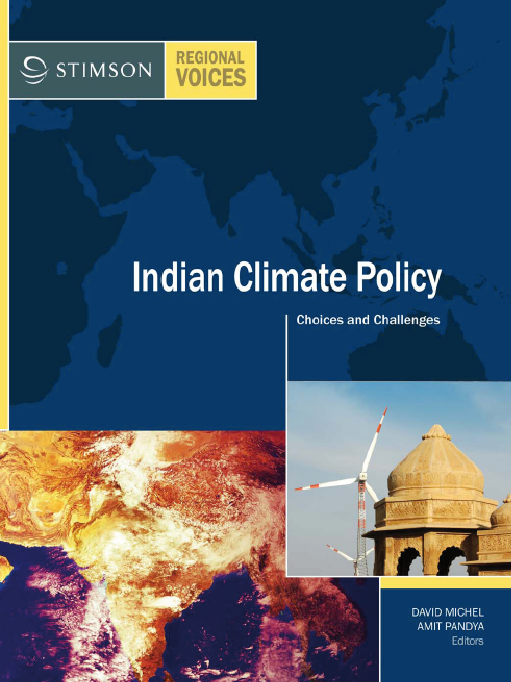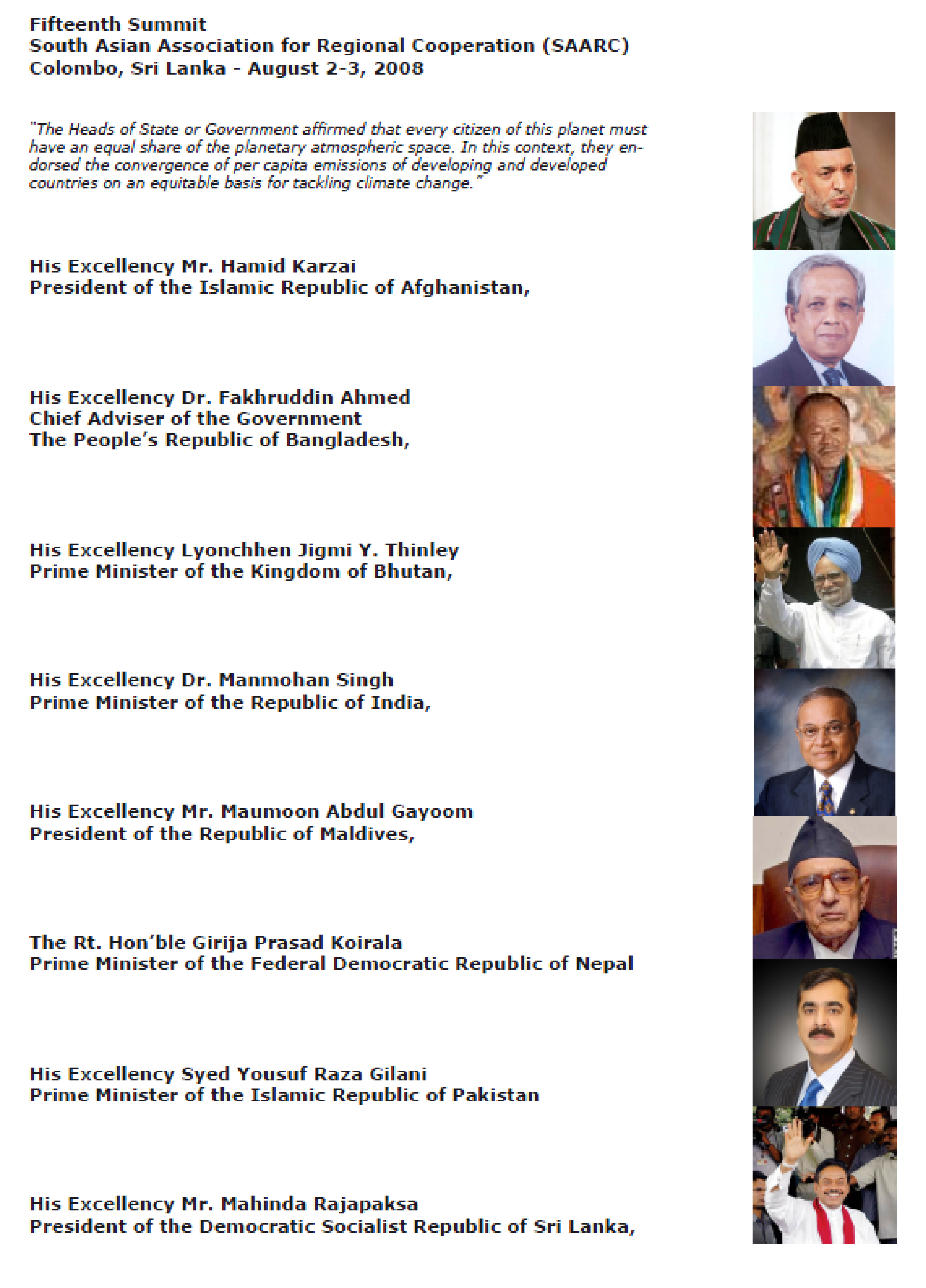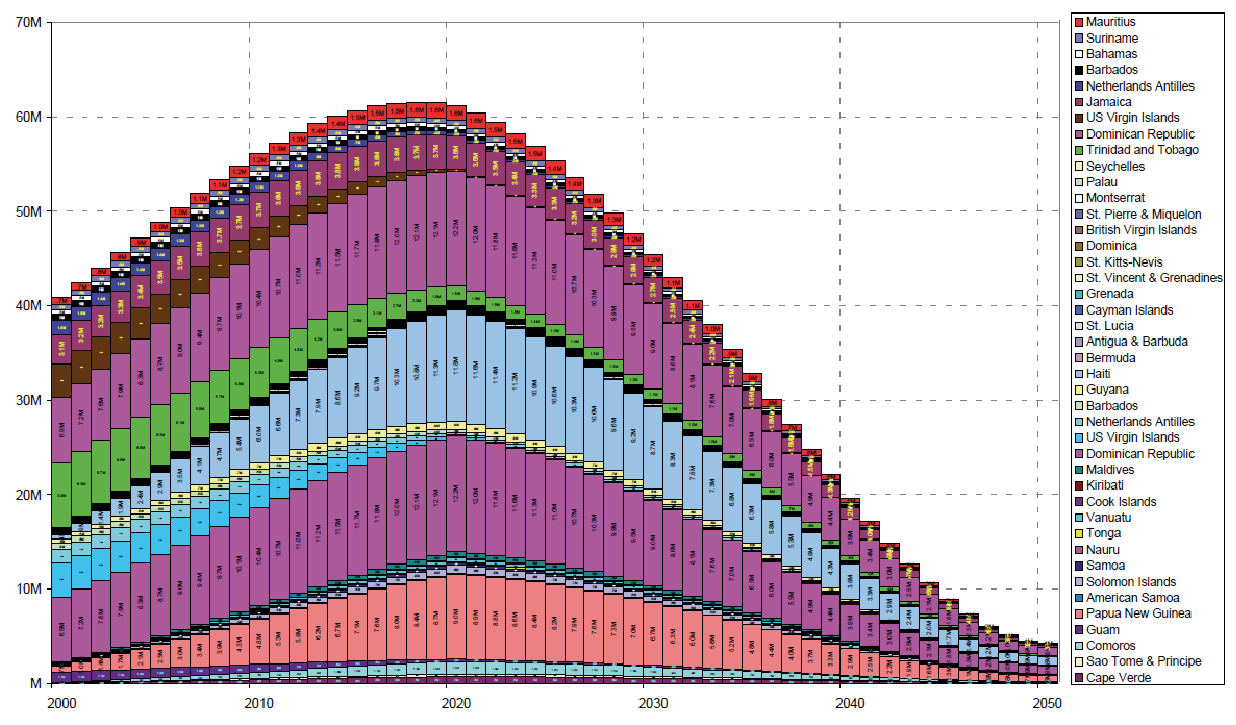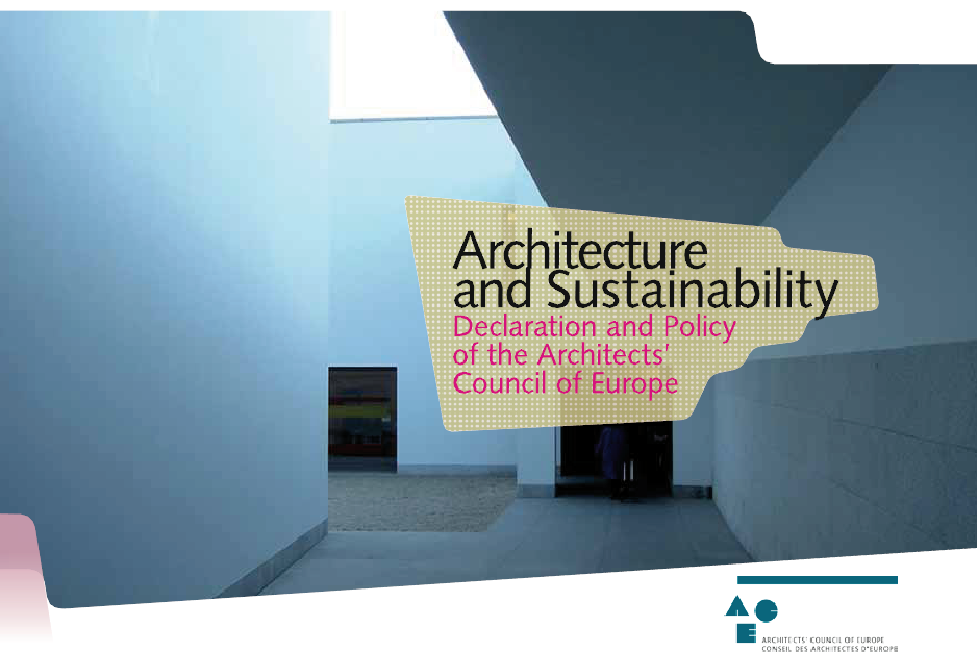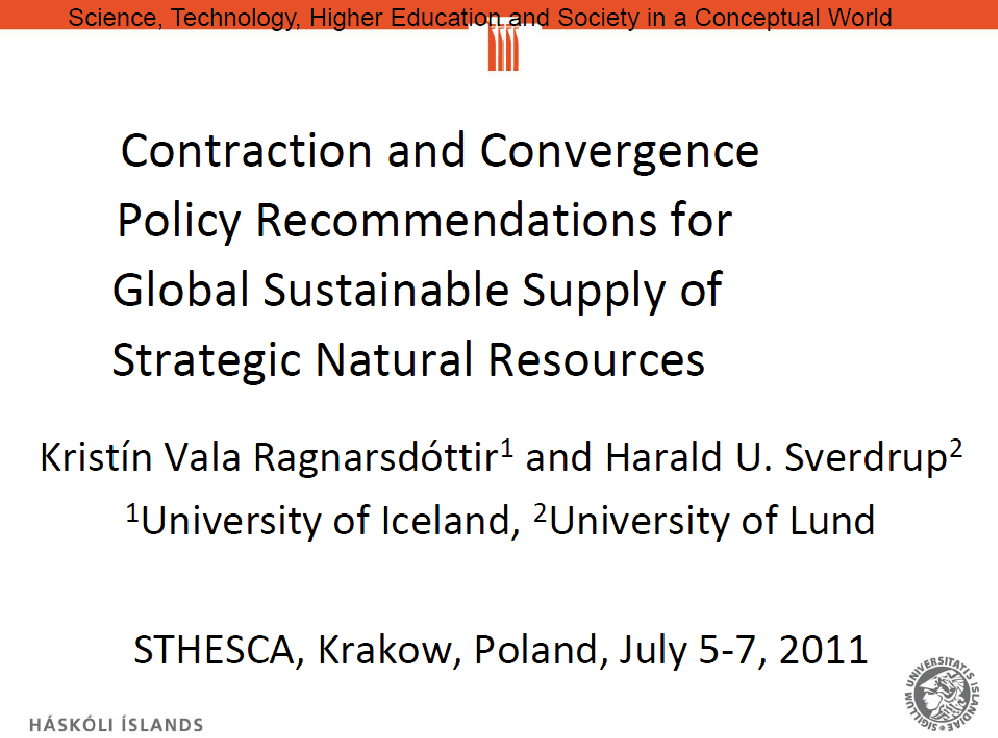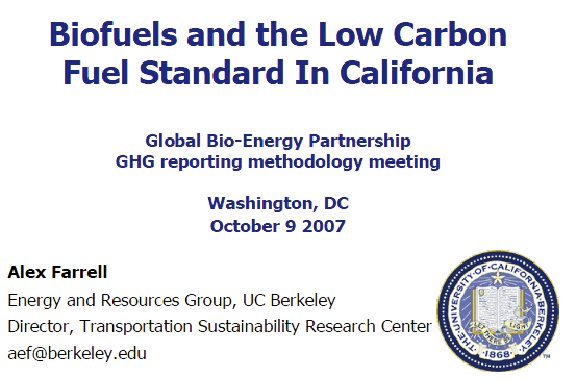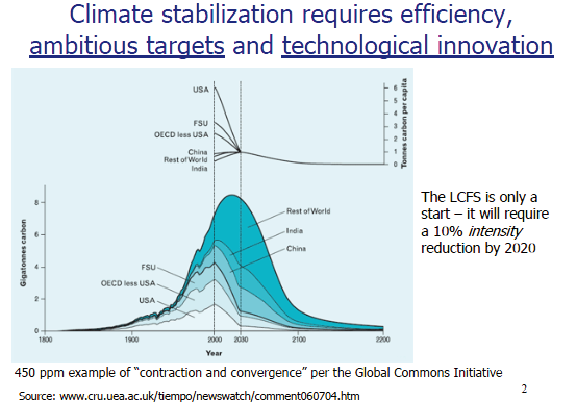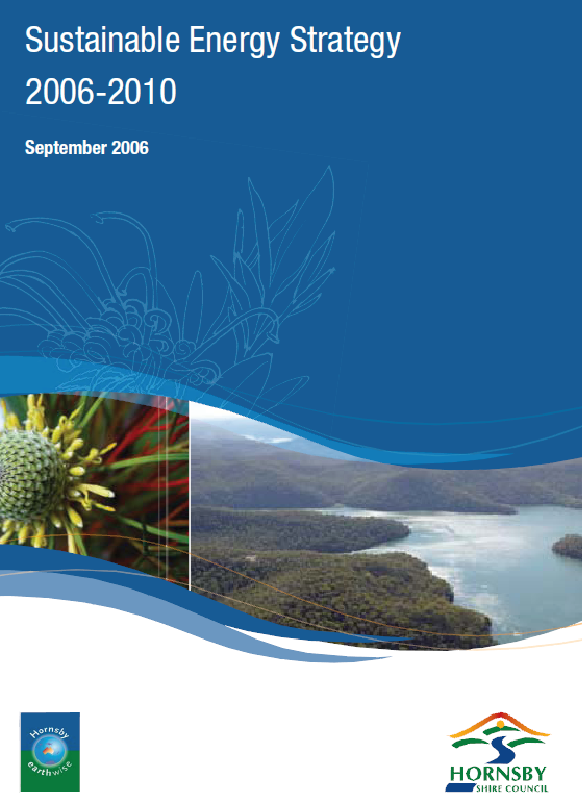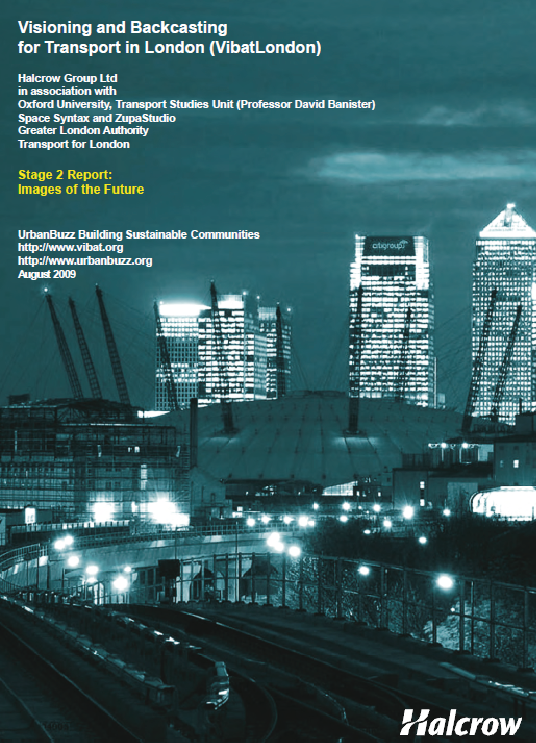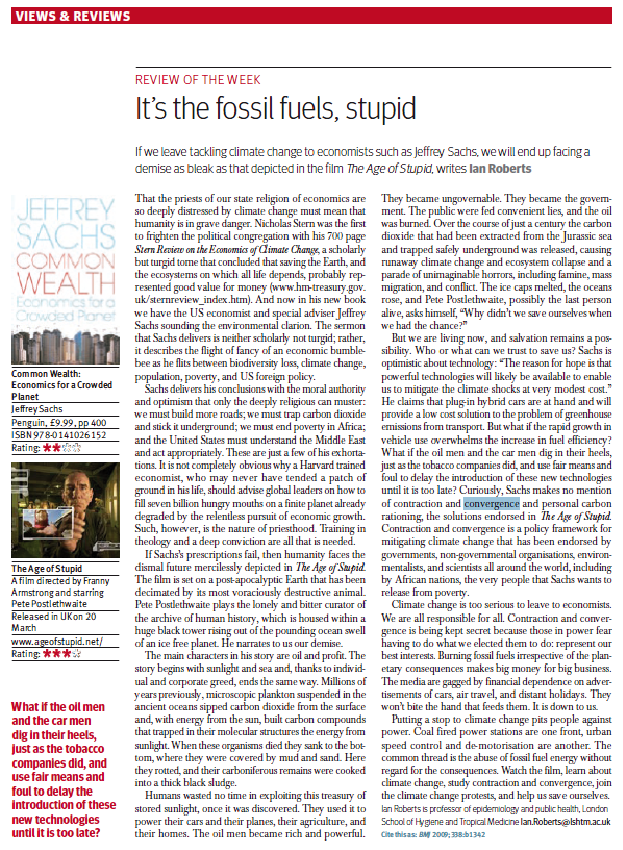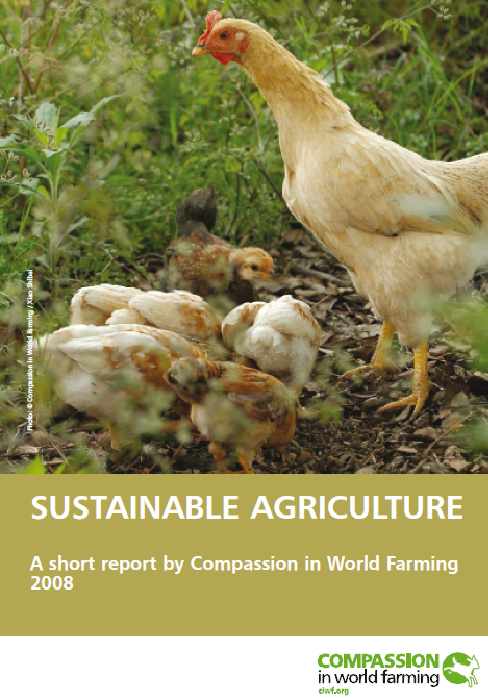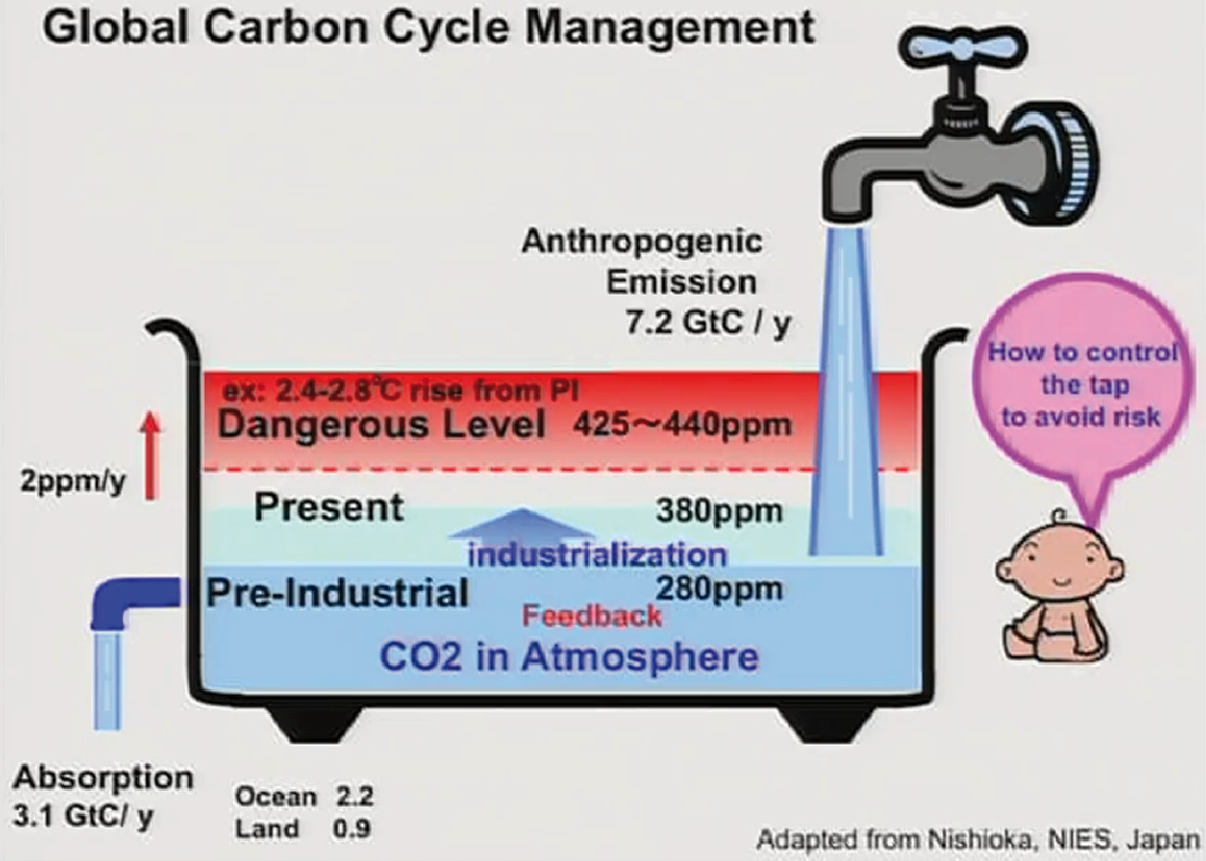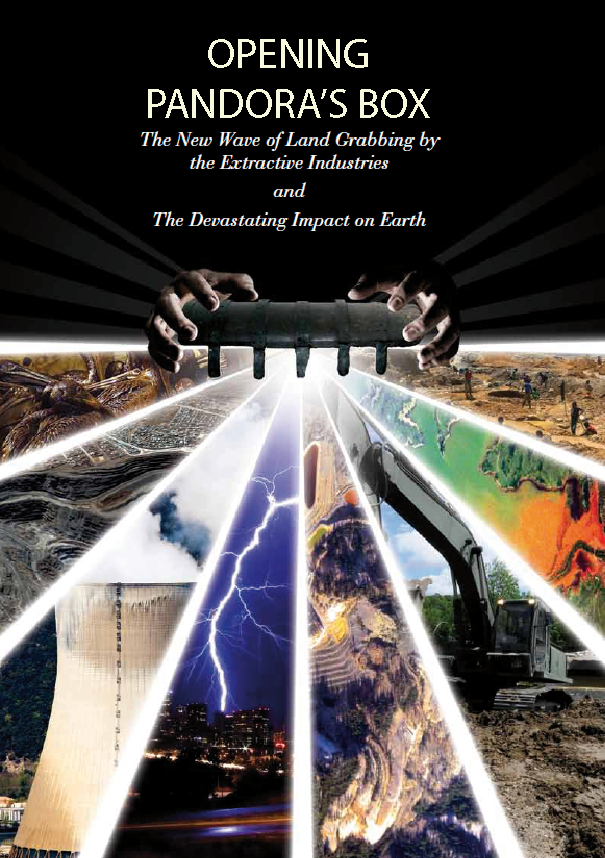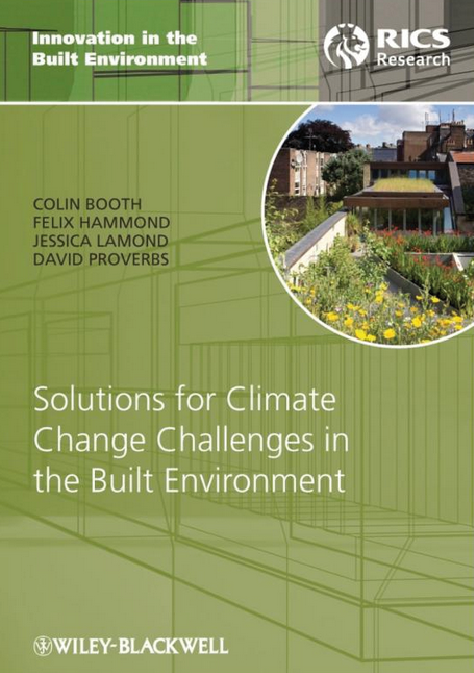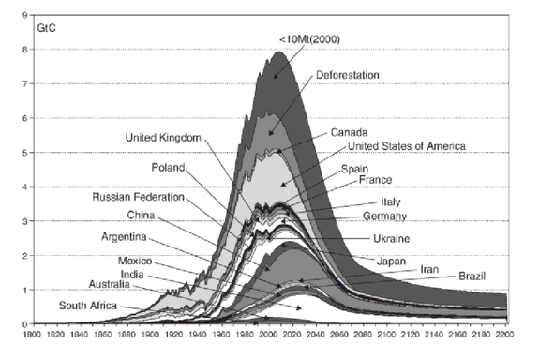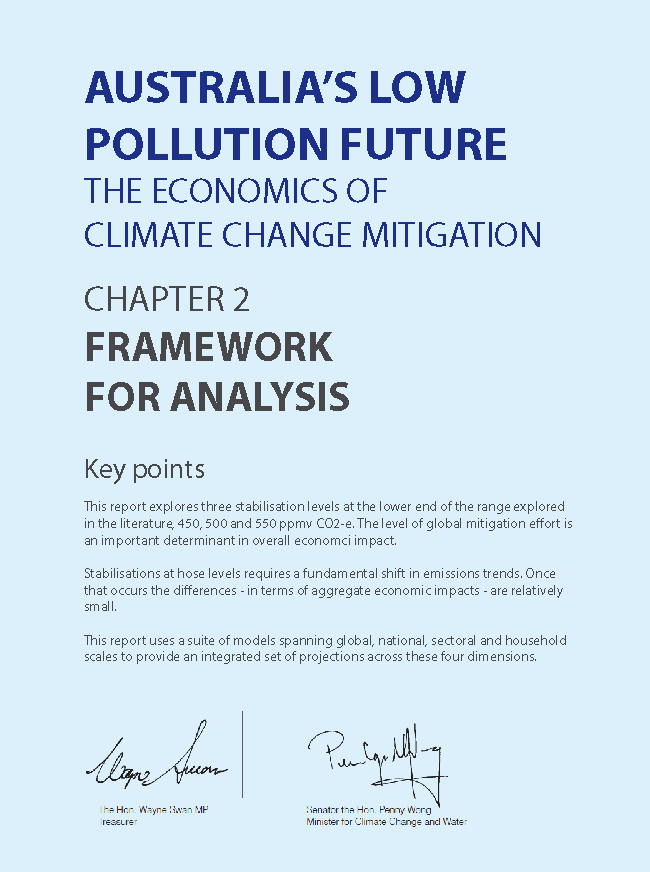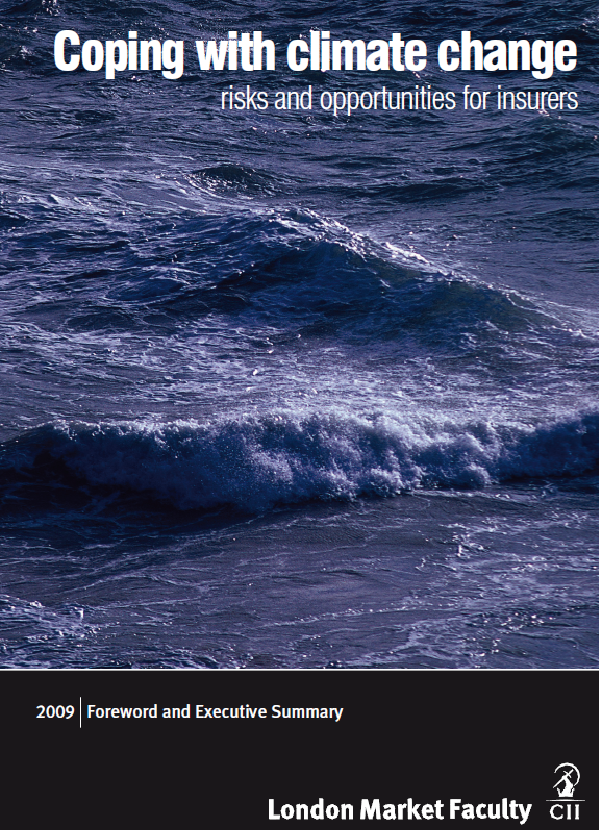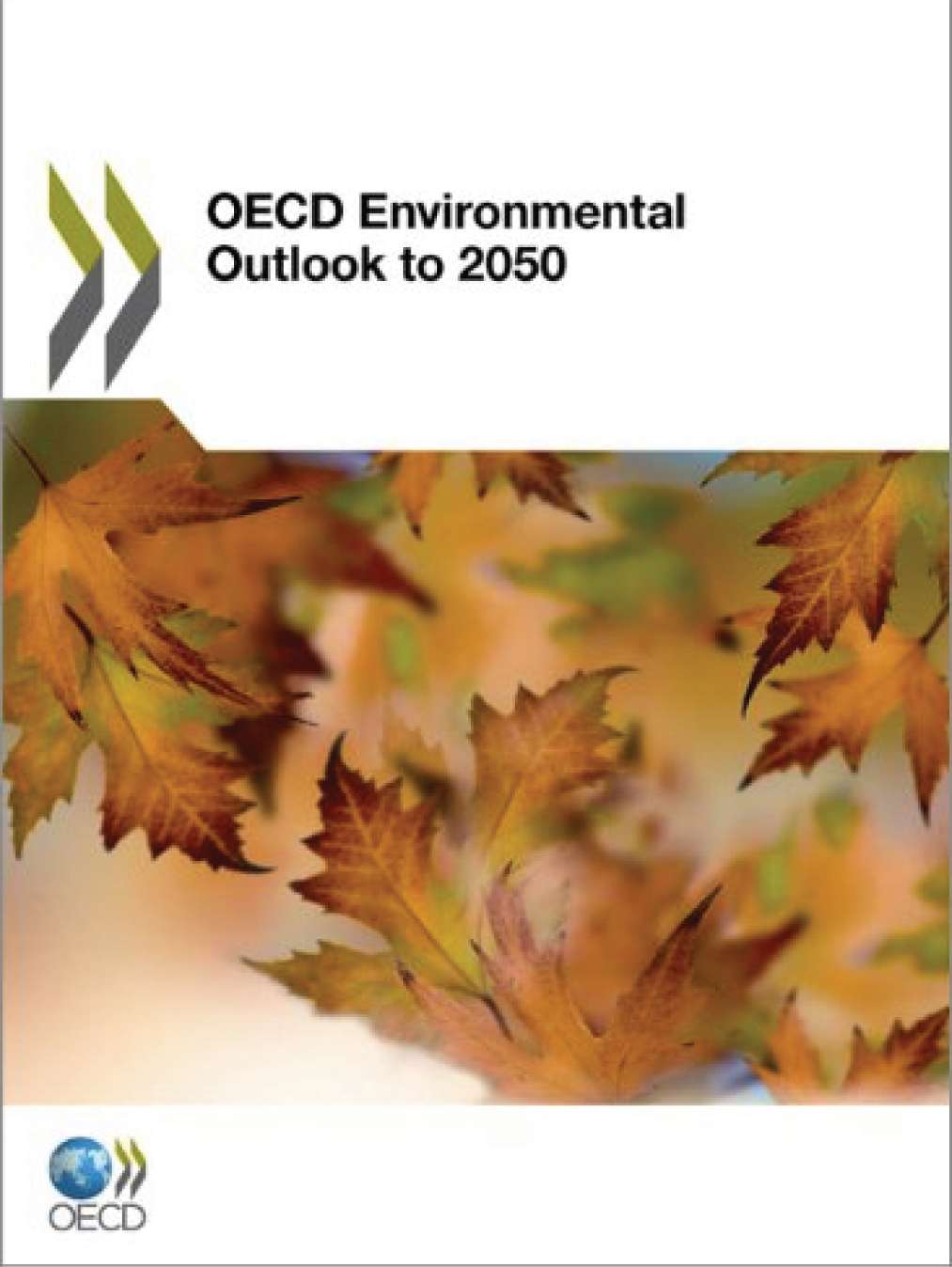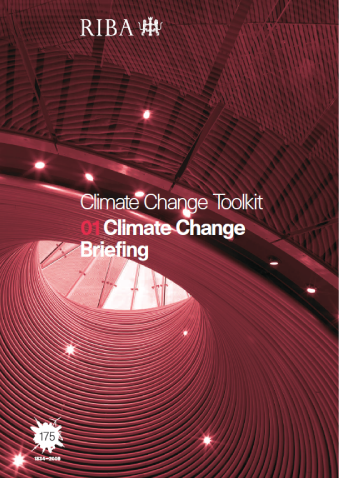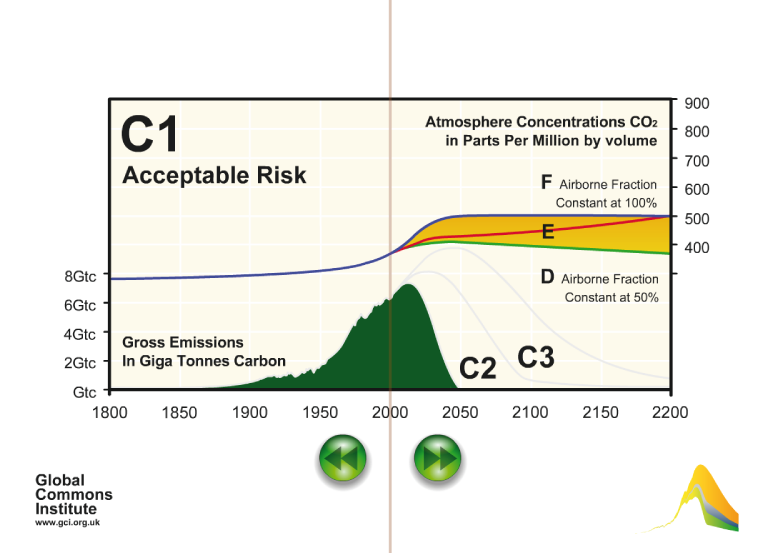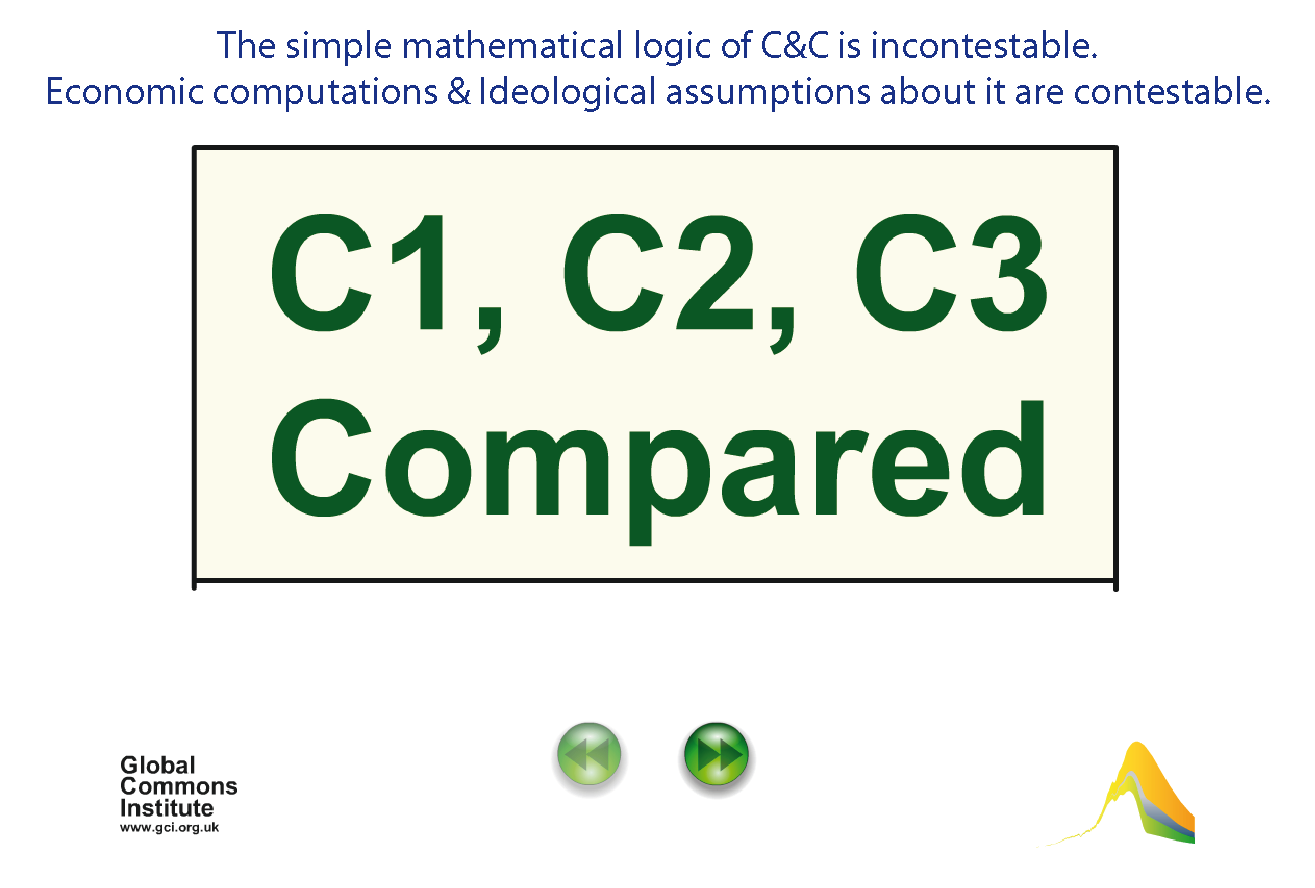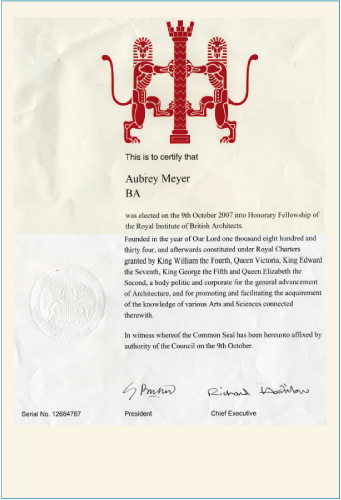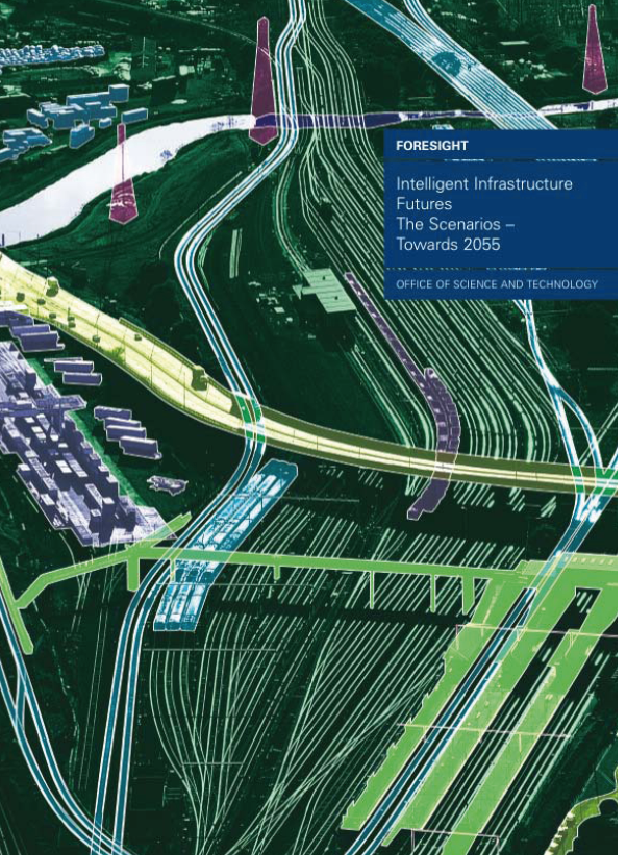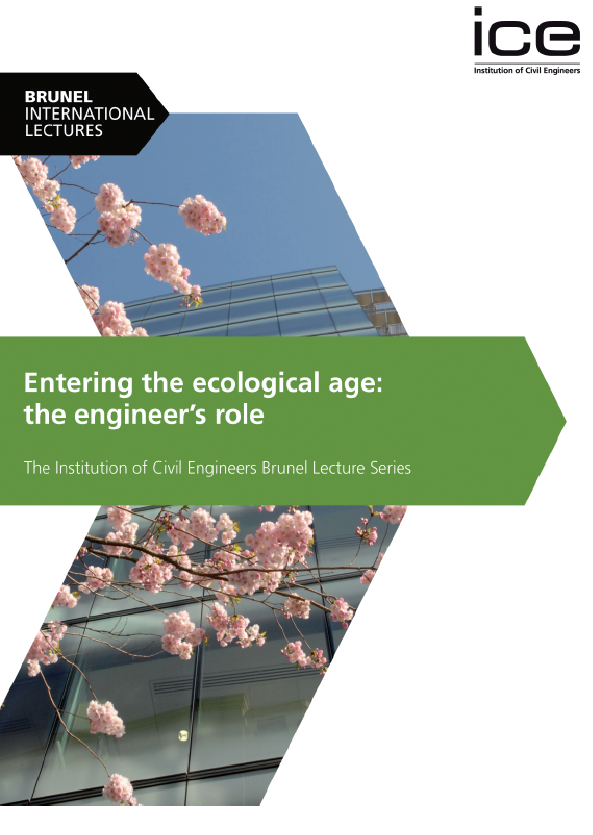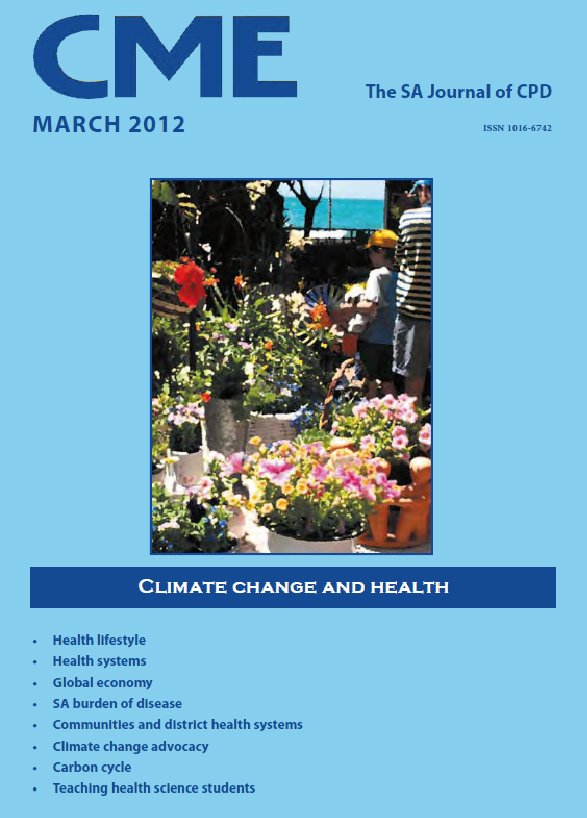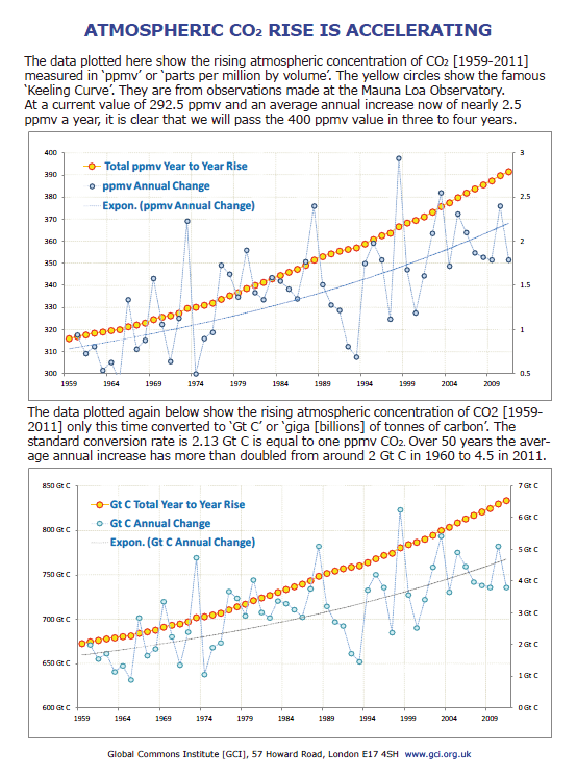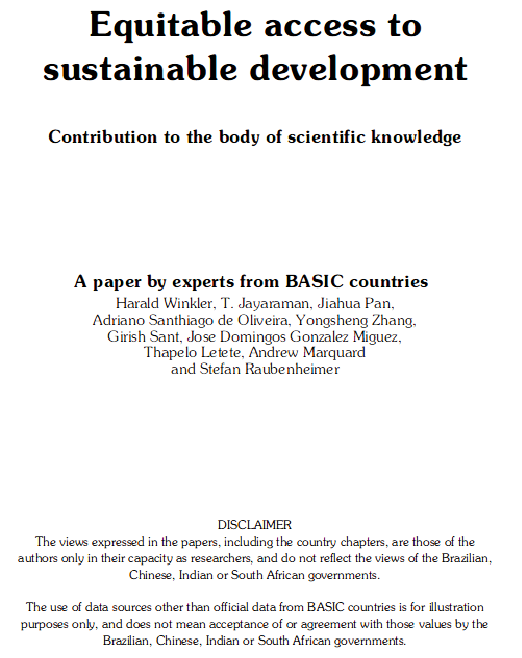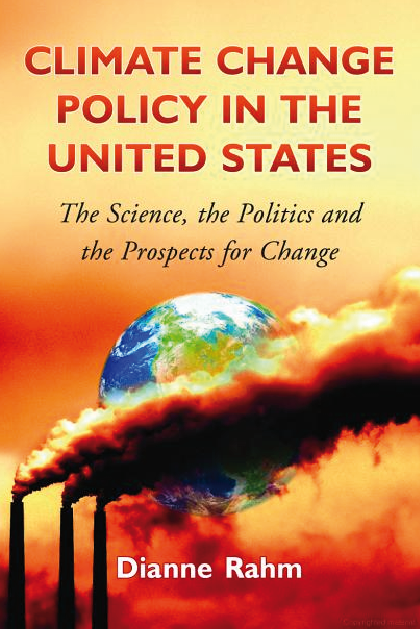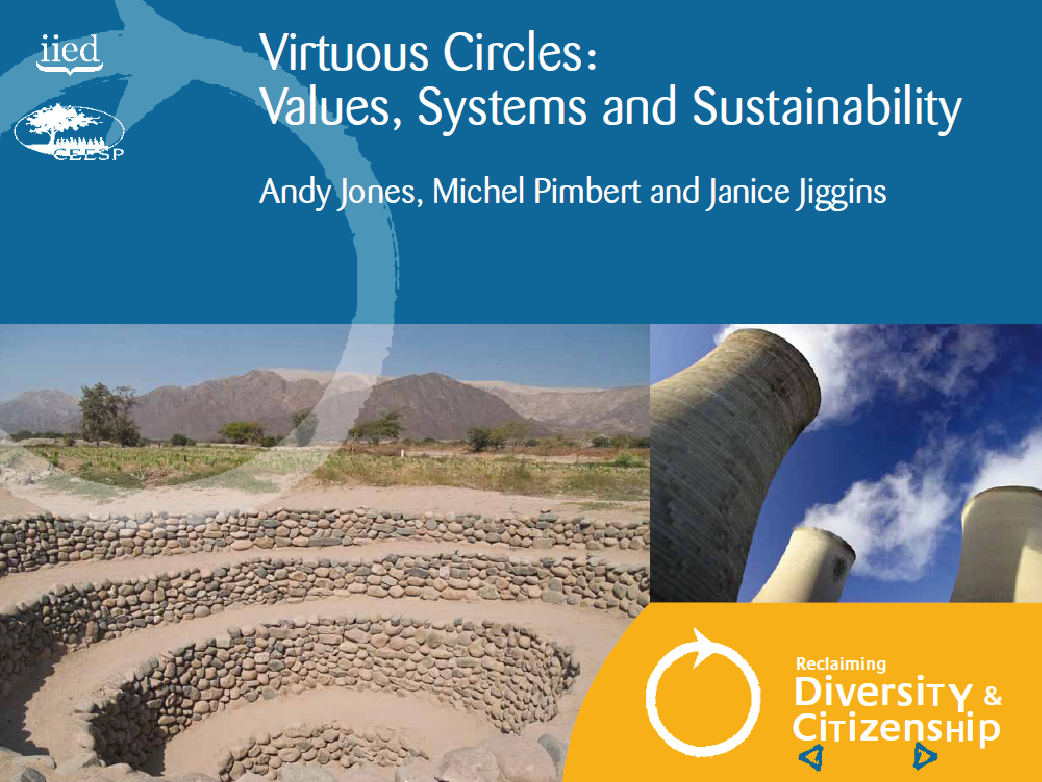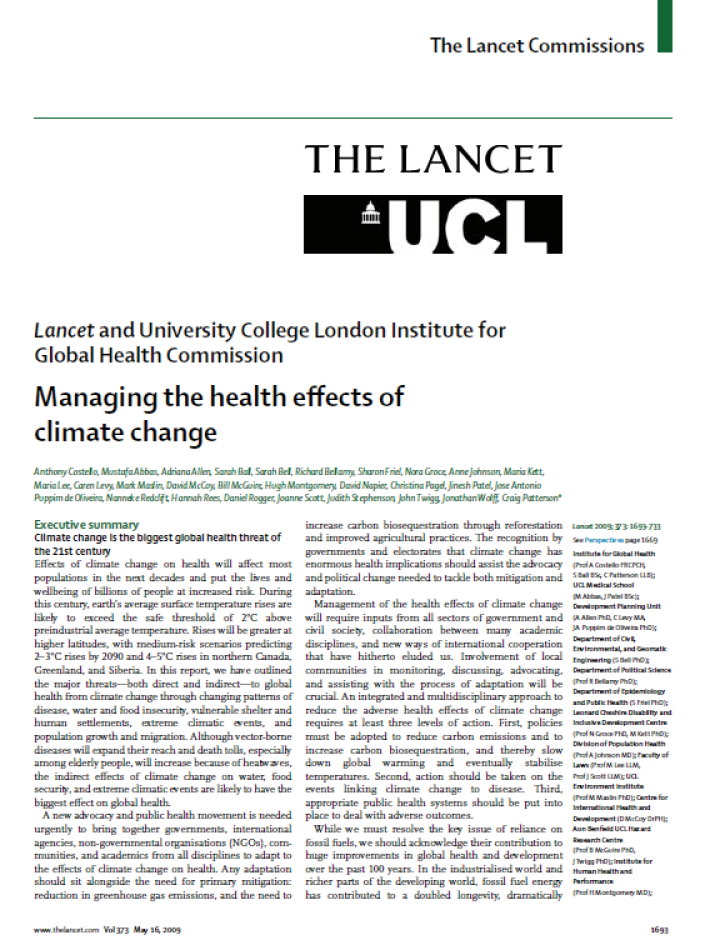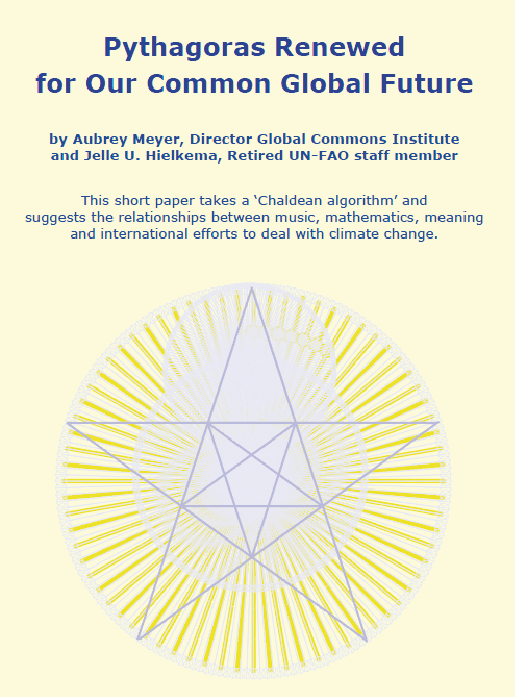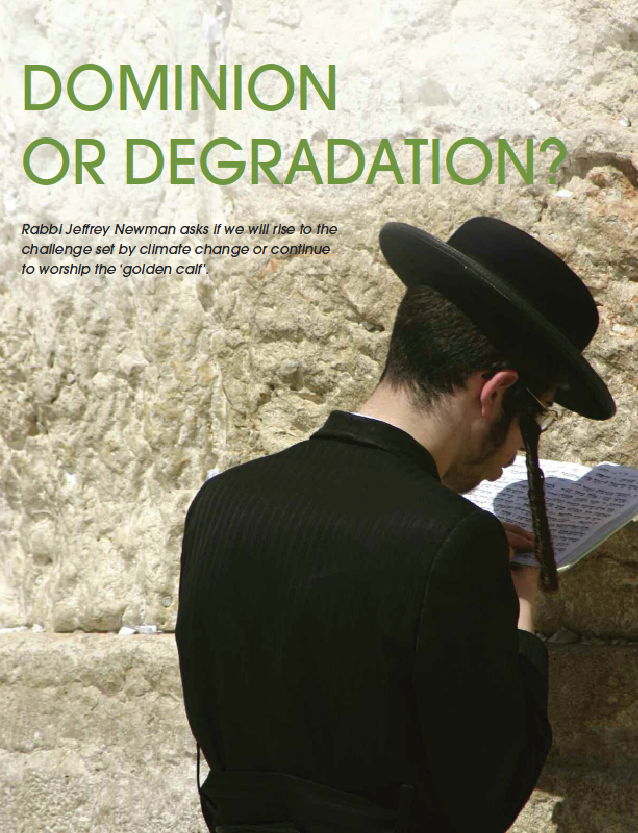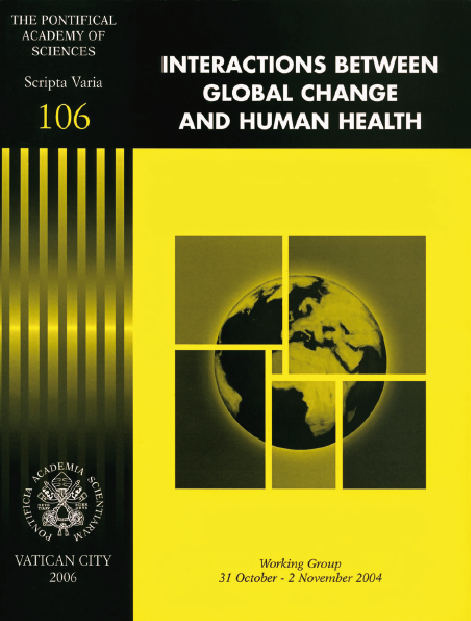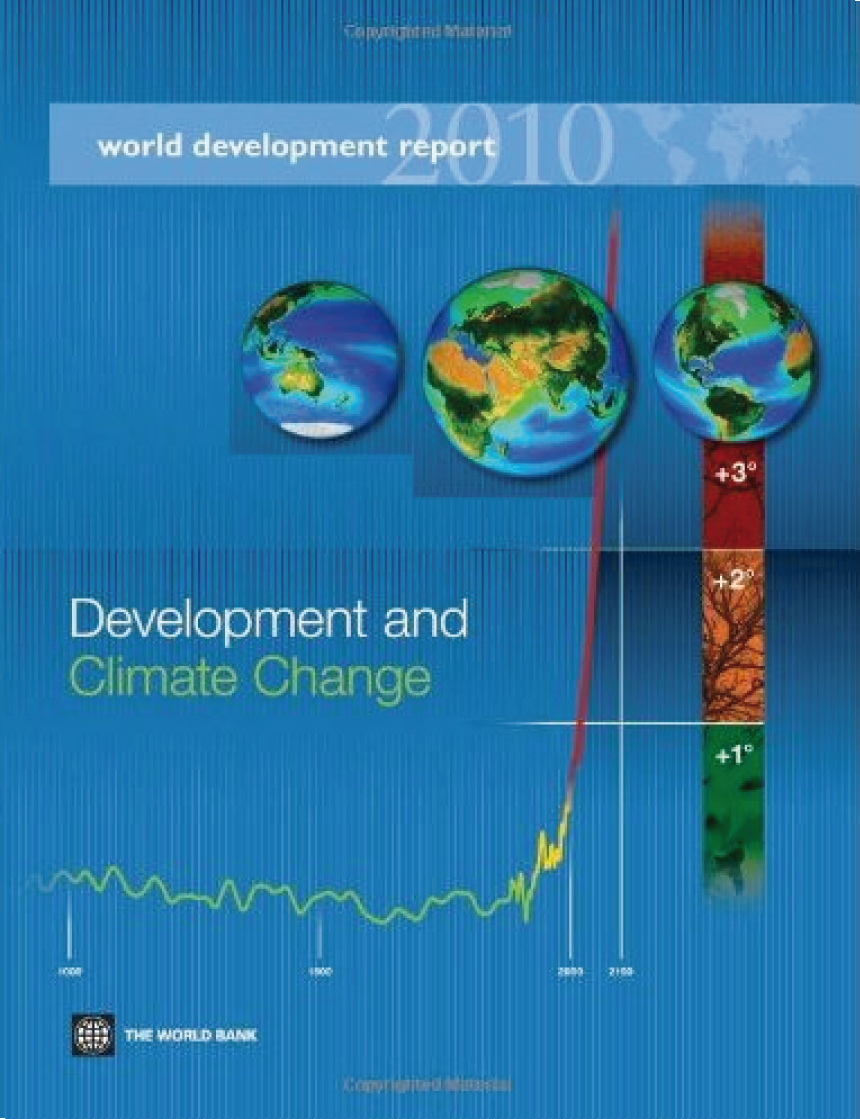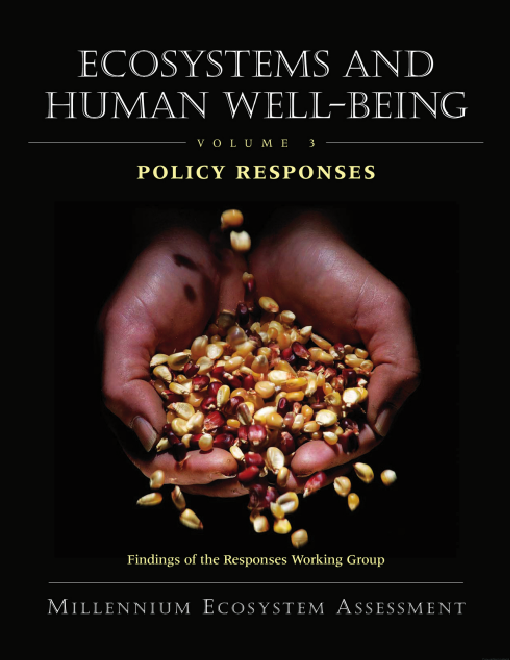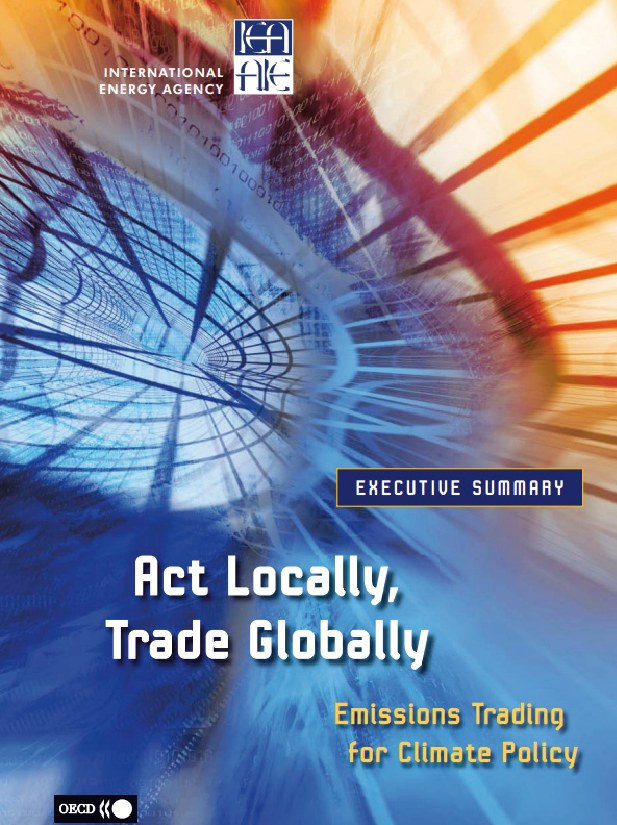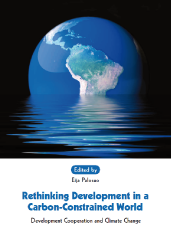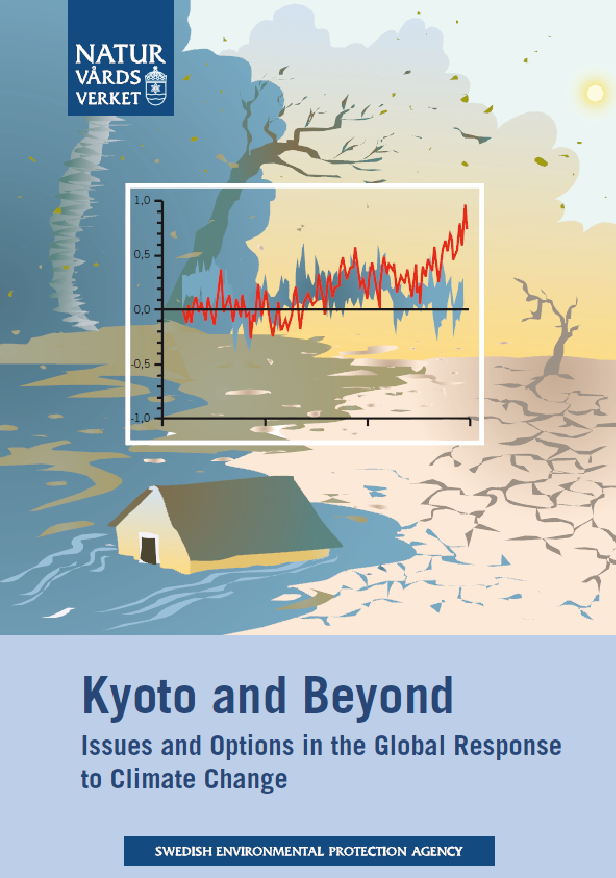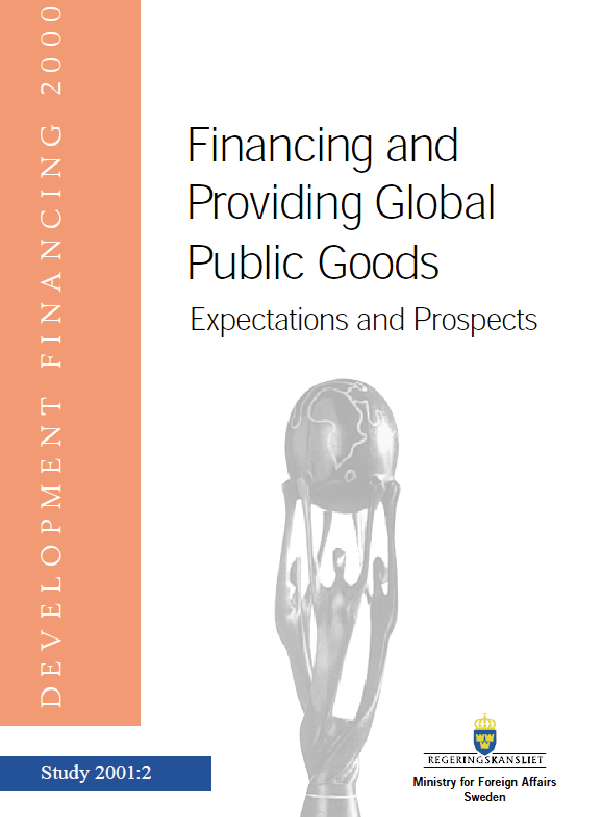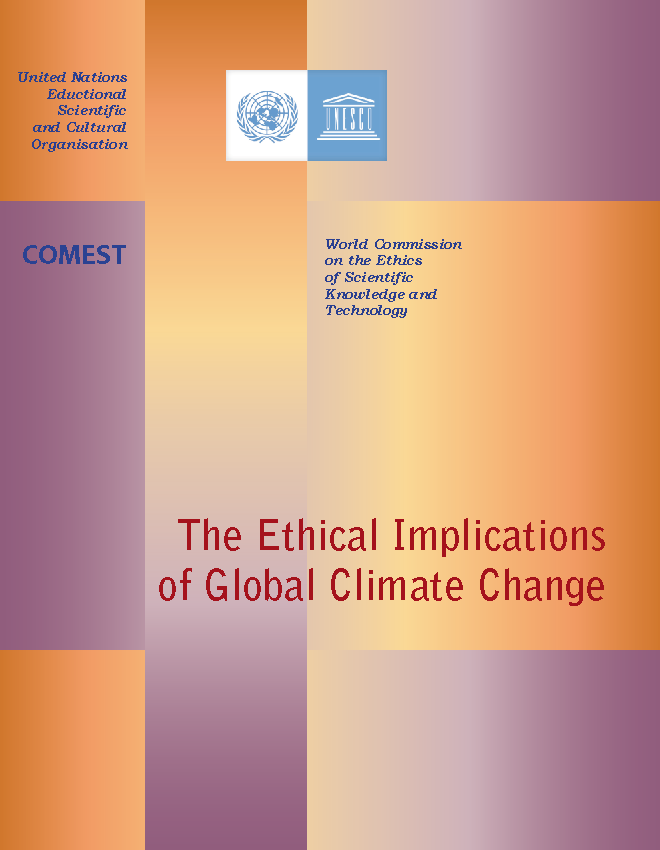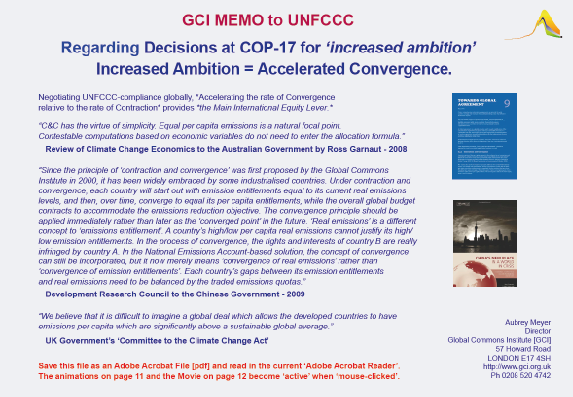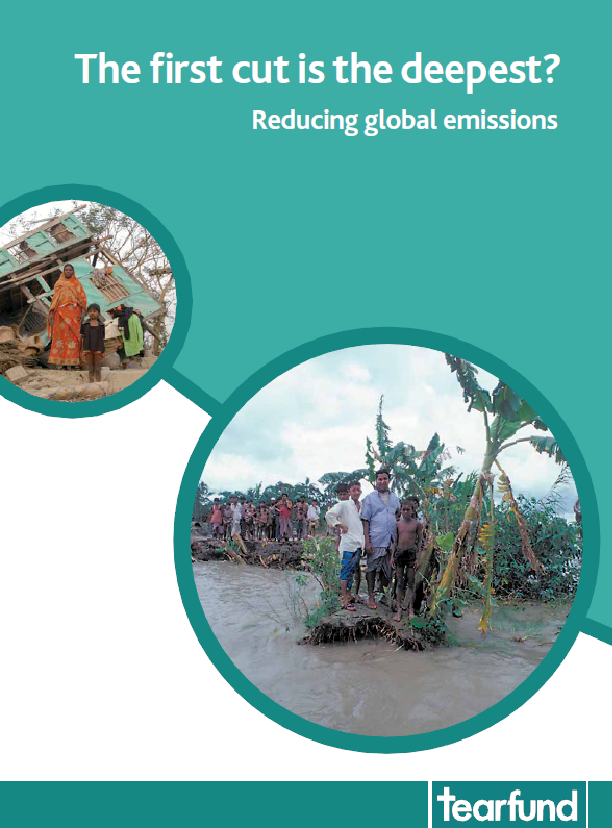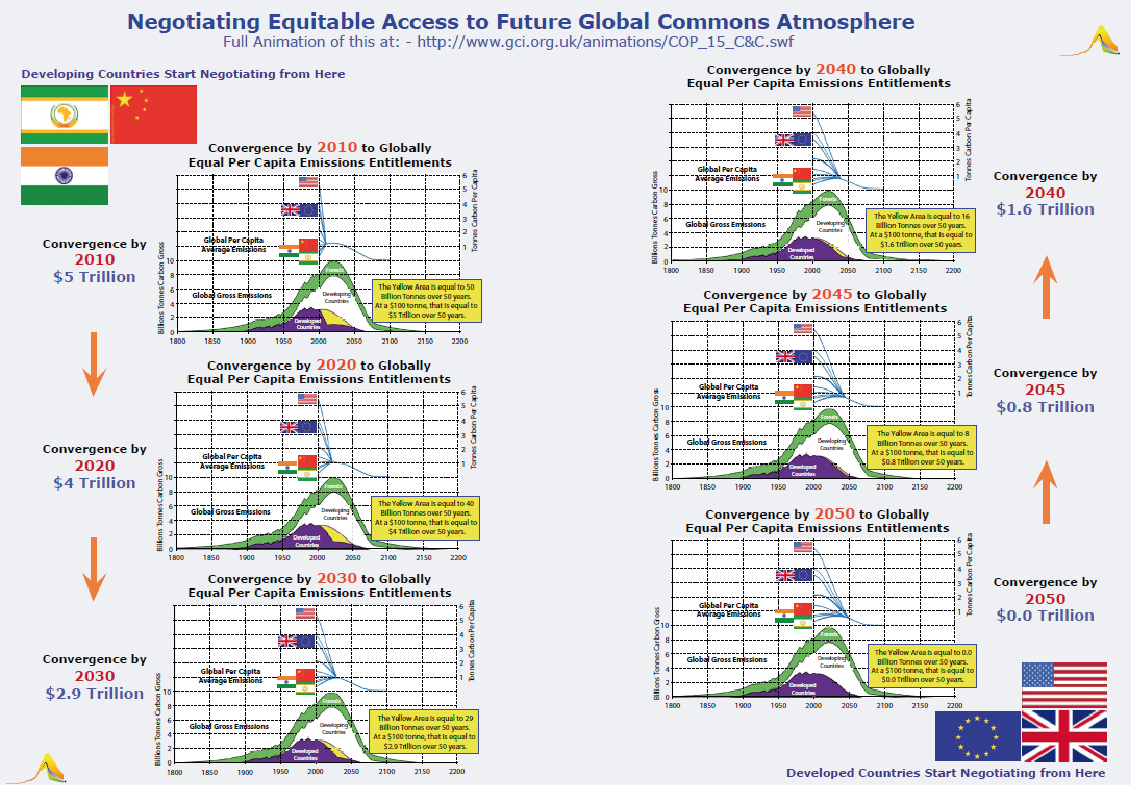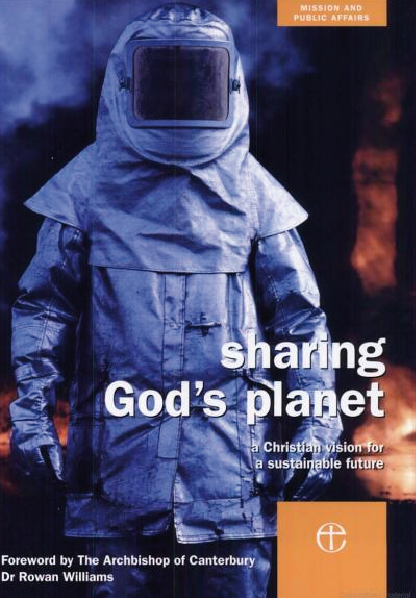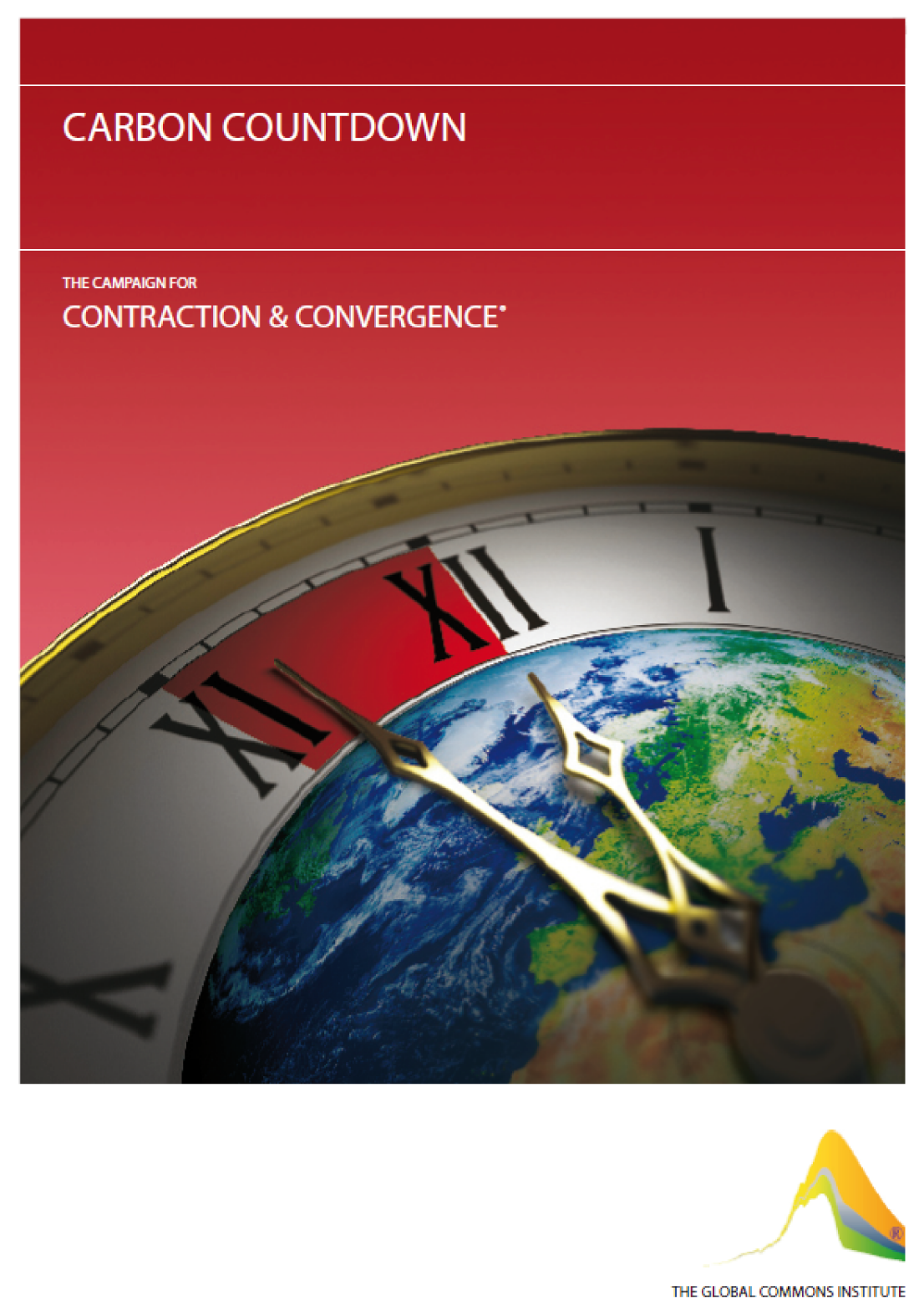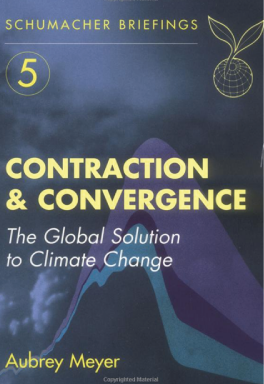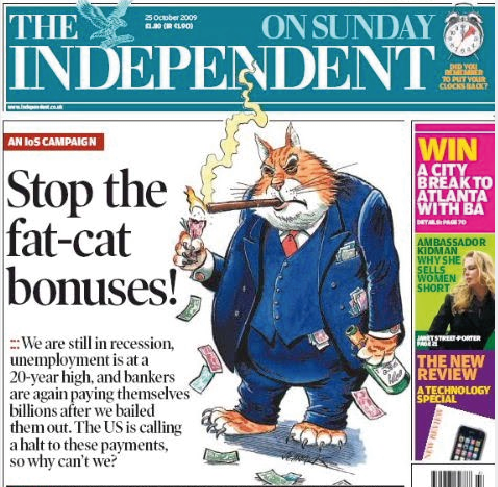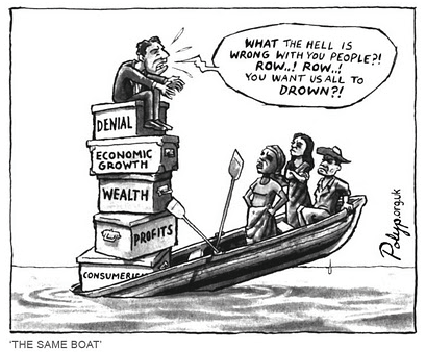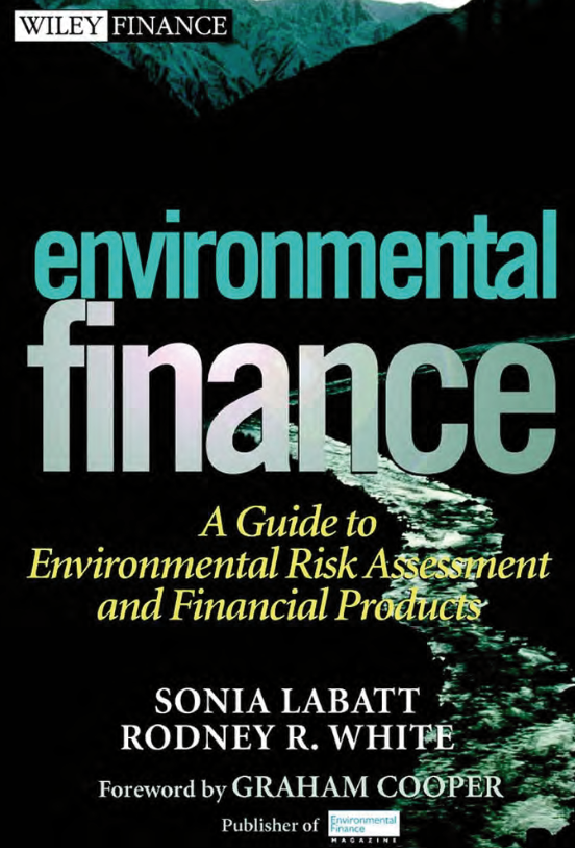"Challen presented the alternative policy; namely, 'contraction and convergence', devised by the London-based Global Commons Institute led by Aubrey Meyer: We know that we need to reduce our carbon emissions so that we arrive at a safe concentration in the atmosphere - perhaps 450 parts per million. We also know that without developing countries being part of a global agreement, it won't work. The answer is convergence - we should aim to contract our emissions while converging to a per-capita basis of shared emissions rights.Challen's warning of the consequences, should contraction and convergence fail to be adopted worldwide as a post-Kyoto climate policy, was expressed in extremely stark terms: Our economic model is not so different in the cold light of day to that of the Third Reich, which knew it could only expand by grabbing what it needed from its neighbours. Genocide followed. Now there is a case to answer that genocide is once again an apt description of how we are pursuing business as usual, willfully ignoring the consequences for the poorest people in the world. This was a crucial and hard-hitting message.
So how did the mainstream media respond to the parliamentary climate change group's challenge? The environment editors and commentators at the Daily Telegraph, Financial Times, the Guardian and The Times had nothing at all to say. Only the Times published a commentary. This was penned by its anti-green columnist, Mike Hume, rubbishing the parliamentary group as a 'cream-puff army' peddling 'irrational' drivel."
NEWSPEAK in the 21st Century
David Edwards and David Cromwell
30 March 2012 - "C&C the most simple yet sophisticated plan for averting runaway climate change." Rory Spowers
"Developed by Aubrey Meyer and the Global Commons Institute [GCI] the Contraction and Convergence [C&C] is perhaps the most simple yet sophisticated framework which tackles the seemingly impossible task of stabilising the atmospheric concentrations of of carbon dioxide and averting the irreversible trends of runaway climate change."
Rising Tides
Rory Spowers30 March 2012 - "Climate Change could bankrupt us by 2065" CGNU UK's largest Insurer
Insurer: Warming WIll Bankrupt Global EconomyClimate Change Could Bankrupt Us by 2065
THE HAGUE, The Netherlands, November 24, 2000 (ENS) - The sixth largest insurance company has warned that damage to property due to global warming could bankrupt the world by 2065. Dr. Andrew Dlugolecki, director of general insurance development at CGNU, told delegates attending the international climate change summit in The Hague that the rate of damage caused by changing weather will exceed the world's wealth. CGNU is a top five European life insurer and the United Kingdom's largest insurance group.
"Property damage is rising very rapidly, at something like 10 percent a year," he told a briefing at the 6th Conference of Parties (COP 6) to the UN Framework Convention on Climate Change, yesterday. "We've still not yet really begun to see the effects of climate change in the West. What we are seeing so far is largely the result of more people living in areas which are becoming more dangerous. But once this thing begins to happen, it will accelerate extremely rapidly, as the IPCC report makes clear."
Dlugolecki contributed to a Intergovernmental Panel on Climate Change (IPCC) report due out next year. The IPCC consists of more than 2,500 scientists from around the world, and its first assessment report in 1990 was used as the basis for negotiating the United Nations Framework Convention on Climate Change (UNFCCC). He said that the current rate of growth of damage of 10 percent a year will exceed Gross Domestic Product by 2065. He added that the insurance industry was in danger of "running out of money," to deal with the disasters.
"This stark warning must help focus the minds of everyone sitting round the negotiation table at the climate summit," said Mark Johnston of Friends of the Earth. "We've all seen the storm warnings, now we are being told the financial forecast. These talks must not fail to produce a deal that will prevent future climate chaos."
Dlugolecki proposes a more radical approach to climate change than is being discussed at COP 6. The concept, known as contraction and convergence, has long been promoted by the London based group the Global Commons Institute (GCI). GCI describes itself as an independent group of people whose aim is the protection of the "Global Commons." It fears the world may be driven beyond the threshold of ecological stability by the relentless pursuit of economic growth.
The 10 year old group has proposed a contraction and convergence framework under which all countries are allocated tradable quotas of a global emissions budget. As the global budget contracts the distribution between countries gradually converges, reaching equal per-capita levels. Put simply, carbon dioxide and other greenhouse gases caused by human activity must be cut drastically, but every country should have an equal right to use the fuels which emit carbon. Huge cuts in emissions from developed nations should allow a corresponding emissions rise from developing countries.
"If Contraction and Convergence is adopted as the tool for managing CO2 and other greenhouse gases, there will be a transition to a point (convergence) where future entitlements to emit will have become proportional to population," says GCI on its website. In projections, GCI suggests 2045 will be the year of convergence. It says population forecasts could become critical and be the subject of negotiation. "However, it could be counterproductive to create an incentive for countries to increase their share of the global emissions budget through population growth," says GCI. "We suggest that a starting position should be that Annex One countries are treated as stable from 2000 forward, and that non-Annex One countries are treated as stable from the Convergence year (2045) forward."
Annex One countries are the 38 industrialized countries, plus the European Union, committed to making cuts in greenhouse gas emissions under the 1997 Kyoto Protocol.
30 March 2012 - ECOHOUSE Sue Roaf "Full account of C&C"
For an account of the theory of Contraction and Convergence see here and the GCI website
Ecohouse
Sue Roaf
30 March 2012 - UK Green Party; Sian Berry "We must campaign globally within the C&C framework."
Green Party Female Principal Speaker Siân Berry today said that tomorrow's IPCC report underlines the need for immediate action to drastically reduce carbon emissions:"This report is a call to arms - we must go further, faster.It confirms that the disastrous effects of climate change are already being observed, and that these effects will accelerate significantly without major changes in policy. We must move rapidly to a Green economy based on need rather than greed. The report demonstrates that climate change could be far worse than previously thought, and suggests a mean temperature rise of about 3 degrees C by 2100. This would have devastating effects. Sustainability requires a serious commitment to tackling climate change; we must set targets nationally, and campaign globally, within the Contraction and Convergence framework, to limit the global mean temperature rise to 2 degrees C. Anything beyond this will challenge and change our civilization beyond recognition."
30 March 2012 - "Good news - C&C exists. Simple & straightforward." Keeping Our Cool by Dr Andrew Weaver
The fact that everyone has to eventually eliminate their emissions and arrive at carbon neutrality makes it a little easier to construct an international policy framework. Achieving carbon neutrality is a grand challenge, but it's one that we can and must meet. The good news is that an international policy framework already exists. In the early 1990s, Aubrey Meyer, founder of the U.K.-based Global Commons Institute, developed "contraction and convergence." The concept is simple and straightforward.
First, you determine what level of global warming is tolerable and what is unacceptable. We'll use 2 degrees C as the threshold. Second, you determine the allowable emissions that would keep you within this target. Our analysis suggests 539 billion tonnes of carbon from 2001 onward (484 billion tonnes from 2007 onward). This corresponds to the assumption of a 4.5 degrees C climate sensitivity, the upper bound of the IPCC likely range, meaning that there is less than a 330/0 chance of breaking the 2 degrees C threshold. The final contraction target is carbon neutrality, and we'll assume this occurs in 2100.
Now we must allocate the 539 billion tonnes of carbon emissions to individual countries between 2001 and 2100. This is the convergence phase. On the convergence date, the principle of global equity is evoked, and every person on Earth is given the right to emit the same amount of carbon. That is, per capita carbon emissions for all countries converge to a common number. We'll use 2075 as the convergence year, although there is no reason why it could not be the same as the contraction year, 2100. Finally, a date has to be chosen beyond which additional credits are not gained for increasing your country's population. That is, increasing your allowable emissions by increasing your country's birth rate is not to be encouraged.
Keeping Our Cool
Andrew WeaverReview of Weaver's book here
30 March 2012 - "The health sector has a crucial role bringing about C&C." Anthony Costello, Global Health
The health sector has a crucial role in helping to reduce greenhouse gas emissions and to bring about ‘contraction and convergence' across the world. High-emitting countries in the U.S., Europe and elsewhere must drastically reduce emissions by up to 90 percent by 2050 with an individual annual limit eventually capped at about 2 tons per head of CO2 equivalent (industrialized countries currently emit 10-20 tons per head). Low-emitting developing countries, who have contributed almost nothing to the problem, should be able to increase emissions up to the same level.Until recently, I was deeply pessimistic about the ability of our global leaders to bring about such an enormous change in our industrial processes, and to police and effect such challenging policy changes. But two things have made me more optimistic.
First, we can afford it. The high costs for the U.S. economy of reducing emissions were a major reason for rejecting U.S. ratification of the Kyoto Protocol. Recent reviews by Barker and Ekins of the costs needed to bring about required reductions in greenhouse gases suggests that if policies are expected, gradual, and well designed, they should cost no more than 1-4 percent of world GDP. The amount, several trillion dollars, sounds like a lot, but actually represents no more than 6-12 months of world economic growth. This is equivalent to the recent bank bailouts, and the sooner such policies are planned and coordinated, the lower the bill.
Second, there are reasons to be optimistic about the development of renewable energy technology. The technology we need is either available or not too far from development. Solutions are needed to develop renewable energy sources. Protecting ideas through intellectual property rights is a key issue if eco-technology is to succeed.
Global Health Magazine Summer 2010
CLIMATE CHANGE: SKEPTICS STEP ASIDE - ANTHONY COSTELLO30 March 2012 - "C&C et al were analysed." IPCC Working Group 3, AR4 2007
A large variety of system designs for allocating emission allowances/permits were analysed, including contraction and convergence, multistage, Triptych and intensity targets. The studies cover a broad spectrum of parameters and assumptions that influence these results, such as population, GDP development of individual countries or regions, global emission pathways that lead to climate stabilization (including overshooting the desired concentration level), parameters for the thresholds for participation and ways to share emission allowances.
Climate Change 2007: Working Group III: Mitigation of Climate Change30 March 2012 - "Common scheme is the C&C Principle." Lavinia Baumstark University of Berlin
A common scheme is the Contraction and Convergence principle (Meyer), which postulates that emission rights are allocated depending on the historical share of emissions in the beginning and converge to equal per capita emission rights later in the century.
Investment Strategies for Climate Change Mitigation
Lavinia Baumstark University of Berlin30 March 2012 - "C&C offers a realistic opportunity for strategic north-south alliances." Prof Markus Vogt LMU
Contraction and convergenceOne of the most interesting concepts for a common contract on CO2 justice is currently being debated under the title contraction and convergence (C&C). This combines a contract which fixes an upper limit for global CO2 emissions (contraction) with a gradual introduction of a distribution of emission rights according to egalitarian principles (convergence).
Basis for the fixing of a global upper limit is consensus within society about level of the ecological risk that can be justified. However, ecological risks can neither be calculated from a natural threshold nor predicted with any certainty. And yet there is a broadly accepted consensus within current political negotiations that global warming by 2°C or a 450ppm concentration of CO2 can be taken as just such a threshold. 56 Following the principle of risk avoidance the C&C concept uses this rather low upper limit, although climate researchers disagree as to whether it is still a realistic goal.
For the process of negotiating CO2 reduction rates the C&C concept accepts the historical distribution as the basis for proportionally-fixed contributions (grandfathering). This is however only the starting point for what then becomes a process with fixed and binding stages, aimed at gradually drawing closer to an egalitarian pro capita distribution of emission rights. The grandfathering principle eases the transition for countries with a high level of emissions. It can be justified ethically as property protection and pragmatism.
“And while a convergence that begins with grandfathering can be ethically justified as easing the transition on high-emitting countries, consistency would seem to demand a similar ‘back end’ mechanism by which emission in low-emitting countries would be allowed to temporarily overshoot the global average, if, that is, ‘easing the transition’ is indeed the justification for initial grandfathering.”
The post-Kyoto negotiations have not yet reached a decision between the two types of model described here as contraction and convergence and responsibility and capacity. C&C offers a realistic opportunity for strategic north-south alliances and is currently enjoying growing support, for example in Great Britain.
Climate Justice - An ethical analysis of the conflicts, rights and incentives surrounding CO2
by Prof. Dr. Markus Vogt, LMU Munich29 March 2012 - Beyond Green "There will have to be significant C&C between rich & poor"
- you know that global CO2 emissions rose 29% between 2000 and 2009 and that the world's population increased by 800 million during that same short period
- you know that the world's population is very likely to reach 9 billion by the year 2050, and that people in the emerging economies cause only a small fraction of the CO2 emissions of the average Brit - and that accordingly there will have to be significant ‘contraction and convergence' between rich and poor nations and regions
- we agree that there is an imperative to reduce CO2emissions from the UK economy , by between 90% and 100% against 1990 levels by 2050
- while the science is far from perfect (and can never be perfect) its central thesis that anthropogenic CO2 emissions are causing a rapid and highly dangerous warming of the global climate is highly unlikely to be wrong
- even if they had the appetite, governments can't magic the changes necessary to achieve the rapid transition to a no carbon economy, so we need to do a lot of stuff ourselves. In time government will tell you to do much more of some things and stop doing lots of other things (regulation); carbon ‘bads' like the internal combustion engine and coal-fired power stations will be aggressively targeted (carbon taxes) and carbon ‘goods' like railways, bicycles, solar power and, errm... people heavily supported (less tax/new facilities and resources); if you agreed with the points above this is inevitable - it's only a matter of time
- the UK land-use planning, place-making, development and regeneration sectors haven't covered themselves in glory with regard to climate change since it first came to light in the 1980s and therefore some serious strategic re-thinking and urgent, rigorous and concerted ACTION is needed now (and why not if this is what we're going to be told to do by governments at all levels soon anyway?)
- if government budgets, taxes, sloppy legislation, rules and regulations and inert public authorities get in the way of what you want to do to achieve very low-to-no-carbon places and environments we'll all get cross, then get organised, speak out, lobby and make a fuss as if our children's lives depended on it.
29 March 2012 - Planet Under Pressure Final "More Science Gentlemen?"29 March 2012 - "C&C shrinks North/South gap & encourages low-carbon energy paths." Norwich Greenhouse
Contraction and Convergence (C&C) is a system designed to allocate, on an equal basis CO2 to all humankind. The over-consuming countries require an adjustment period to contract their CO2 emissions, while developing countries are able to increase to some extent (until convergence occurs).After Convergence each country would receive the same allocation of CO2 emissions permits per head of its population at some agreed base level for the year. Those countries, unable to live within their allocation would be able to buy more permits from countries, which ran their economies in a more energy-frugal way. The theory is that this would allow a steady flow of purchasing power from countries that have used fossil fuels energy to become rich to those still struggling to break out of poverty. C&C would thus not only shrink the gap between rich and poor but also encourage the South to develop along a low fossil fuel-energy path.
The over-consuming industrialised nations, which have cause the warming problem invariably argue that the market should be left to correct the imbalance.
"To begin with, we must acknowledge that climate change is the greatest market failure the world has ever seen. Greenhouse gas emissions are an externality, affecting the lives of others, with people not paying for the consequences. It is therefore not enough to say leave it to the market, the market has already shown it has failed".
David Cameron MP - Conservative Party Leader - Do Good Lives Have To Cost the Earth? 200829 March 2012 - "C&C a pragmatic framework to solve climate change." Interview with Green Collar Asia
Interview with Green Collar Asia By Bhavani Prakash
"Contraction & Convergence as a pragmatic framework to solve Climate Change"
In 1992 the world agreed a Climate Change Convention at the UN. Its objective is to halt the rising concentration of Greenhouse Gas [GHG] in the atmosphere at a level that is low enough not to trigger dangerous rates of climate change. By 1995 the Convention had been ratified by a sufficient number of Governments to bring it into force and a process of International negotiations began to control and reduce the GHG emissions from the human economy that were responsible for this rise of concentrations in the global atmosphere.
Climate scientists now see a 2 degree C temperature rise above pre-industrial levels as a ‘safe’ upper limit. GHG concentrations have risen 40% above preindustrial levels and need to stop rising below 60% to keep within that 2 degree temperature limit. To achieve that, global GHG emissions need to fall to near zero within about the next forty years.
To accelerate to this greener future with abundant jobs in emissions-free renewable energy, clean transport and infrastructure, sustainable agriculture and oceans, a global climate deal on GHG emissions control is an essential pre-condition and now urgently needed. The Contraction & Convergence [C&C] model discussed here offers a framework for such a global climate deal.
Attempts over the last seventeen years at arriving at a climate deal during the COP climate change summits have been ‘guesswork’ and a ‘patchwork’, with various countries coming up with emission reduction numbers which are mostly expedient to their economic interests, rather than meeting the objective of the Convention and the collective good of humanity.
Nations need to sit down together to agree jointly how much carbon emissions need to contract overall to stay within the total budget of emissions that is required to stabilise concentrations at a safe level, and decide how each nation’s or region’s share of that budget can be determined in a manner that is rational and fair. C&C then proposes that within the overall contraction that is required, all nations or regions converge to a uniform per capita emission figure. This creates shares of the budget as either ‘entitlements’ to emit or actual emissions. The key negotiation under C&C is the rate at which the over-consumers and under-consumers need to converge.
With this framework accepted as the basis of the process from now on, guesswork is superseded and the likelihood that planet will remain within the carbon budget is considerably increased.
28 March 2012 - Absolute Astronomy Seattle "Many consider C&C the best way."
Contraction and Convergence
[A few 100 more campaign-type statements here].
The concept of Cap, Contraction and Convergence as a replacement to the Kyoto agreement, has been recently gaining ground. The idea here is that the limits to carbon emissions need to be capped at 350-450 parts per million, currently considered to produce a raise in world temperatures above pre-industrial levels of between 1 to 2 degrees Celsius. It is currently believed that further increases would bring about major positive feedbacks (the burning of forests and the loss of carbon from soils and oceans) which currently limit greenhouse gas emissions, and would lead to a run-away global warming similar to the Eocene period, during which there was no ice at the poles. To sustain this figure, it is proposed that on equity grounds, all people should be allocated an equal carbon footprint (currently about 2 tonnes per person, which by 2050 could fall to 1.5 tonnes per person through population increase). World per capita carbon emissions, currently in excess of 4 tonnes per person needs to contract to those levels, if these targets are to be met. As a result, in the name of global and inter-generational equity, policies needing to be instituted need to converge, over a fixed period towards this figure for every country. A trading regime, whereby which countries in excess of these figures (from example the USA at 20 tonnes per capita, purchase carbon credits from a country using less than its allocation (e.g. Kenya at 1.3 tonnes per capita), is considered by many as the best way of solving this problem. For example the Contract and Converge strategy has now been adopted by India, China and many African countries as the basis for future negotiations. The UK Royal Commission on Environmental Pollution said in 2000 �the UK should be prepared to accept the contraction and convergence principle is the basis for international agreement on greenhouse gas emissions�.
Action on Climate Change
Absolute Astronomy [Seattle USA]
Environmental Policy Instruments
Environmental policy instruments are tools used by governments to implement their environmental policies. Governments may use a number of different types of instruments. For example, economic incentives and market-based instruments such as taxes and tax exemptions, tradable permits, and fees can be very effective to encourage compliance with environmental policy.
Voluntary measures, such as bilateral agreements negotiated between the government and private firms and commitments made by firms independent of government pressure, are other instruments used in environmental policy. Another instrument is the implementation of greener public purchasing programs.
Often, several instruments are combined in an instrument mix formulated to address a certain environmental problem. Since environmental issues often have many different aspects, several policy instruments may be needed to adequately address each one. Furthermore, instrument mixes may allow firms greater flexibility in finding ways to comply with government policy while reducing the uncertainty in the cost of doing so. However, instrument mixes must be carefully formulated so that the individual measures within them do not undermine each other or create a rigid and cost-ineffective compliance framework. Also, overlapping instruments lead to unnecessary administrative costs, making implementation of environmental policies more costly than necessary In order to help governments realize their environmental policy goals, the OECD Environment Directorate studies and collects data on the efficiency of the environmental instruments governments use to achieve their goals as well as their consequences for other policies. The site serves as a complementary database detailing countries' experience with the application of instruments for environmental policy.
The current reliance on a market based framework is controversial, however, with many prominent environmentalists arguing that a more radical, overarching, approach is needed than a set of specific initiatives, to deal coherently with the scale of the climate change challenge. For an example of the problems, energy efficiency measures may actually increase energy consumption in the absence of a cap on fossil fuel use, as people might drive more efficient cars further and they might sell better. Thus, for example, Aubrey Meyer calls for a 'framework based market' of contraction and convergence examples of which are ideas such as the recent Cap and Share and 'Sky Trust' proposals.
28 March 2012 - "Green Economy means C&C for resource-justice" NGO update for 'Zero Draft' at Rio+20III. Green Economy in the context of sustainable development and poverty eradication.
Framing the context of the green economy, challenges and opportunities25. Implementing Green economy has to be seen as one of the means for achieving sustainable development, which must remain our overarching goal. It should be based on the Rio principles, in particular the principle of common but differentiated responsibilities and precautionary principle and should be people-centred, human rights based and inclusive, providing opportunities and benefits for all citizens and all countries.
26. We view the green economy as a means to achieve sustainable development, which must remain our overarching goal. We acknowledge that a green economy in the context of sustainable development and poverty eradication should be within the limits of the carrying capacity of the planet and human capital. It should increase resource efficiency and sufficiency, phase out the unsustainable consumption and production patterns, and move the world toward low-carbon economies.
27. Achieving world-wide Green Economies, and with that resource justice, means also a scheme of
contraction and convergence for over- and under-consumers of natural resources and waste disposal.28 March 2012 - "Insurers must speak strongly for C&C." Geneva Papers Internat. Assoc. Insurance Economics
From a risk management perspective, the costs of being too lax about emissions could be very high, due to a breakdown in the climate system. It therefore makes sense to aim for tough limits, which can be relaxed later if appropriate. There is ample guidance from scientific sources on this. Many scientists believe that an atmospheric level of 450 ppmv (parts per million by volume) of carbon dioxide should be the initial target for prudence. We are already at 380. For long-term allocation, the “Contraction and Convergence” model (C&C) seems appropriate (see Figure 7). This consists in choosing a "safe" global annual emissions level and (2) a date at which it wi ll be shared out globally on a per capita basis. The other element is (3) a start date from which time the actual, unequal per capita emissions start to move towards their final , equal per capita levels. The name C&C reflects the facts that the annual emissions contract to a safe level, and the per capita shares converge to become equal.
Figure 7. Contraction and Convergence (C&C). Source: Global Commons Institute
Key: Vertical axis is billions of tonnes of carbon emitted annually. Horizontal axis is the year. Operation The solid line (BAU) shows the path that emissions will follow on historical patterns. The "C02" segments of the chart show how actual emissions could develop under C&C The gap between BAU and actual emissions would be solved by energy efficiency and RE. In the short run, since the C&C emissions allocation is based on equal per capita allowances, that gives the developing world something to trade, as they have lower per capita emissions generally.
Insurers have a duty as ubiquitous players in the economy and society to help to shape climate policies in a responsible and effective way. With their expertise in risk management, and their responsibilities as custodians of future wealth they are uniquely placed, but in general they have been dilatory in this task. It is time for them to speak out strongly for specific measures: a target for atmospheric CO2 of 450 parts per million, and adoption of the Contraction and Convergence model as a method of allocating emissions.
Geneva Papers on Risk and Insurance28 March 2012 - New Zealand Climate Change & Energy Minister & many others on C&C in Policy Quarterly
Sharing the Burden of Climate Change
Policy Quarterly issue with many article devoted to C&C-related issues
"Moving to equal per capita allocations is often referred to as ‘contraction and convergence’ (Global Commons Institute, 2000): a contracting global annual emissions budget, with national allocations converging to equal allocations per person everywhere. This basic principle has been promoted by India and found support in recent times in Europe, and variations of the approach have figured in recent reports on the way forward for global climate negotiations (Stern, 2008; Commission on Growth and Development, 2008). Allocations would decrease continually for countries above the per capita global average. For countries below the average they would increase for some time â�� albeit typically at a rate slower than unconstrained emissions growth â�� before decreasing in line with the global (average) emissions."
This excerpt is from an article in Policy Quarterly by Hon David Parker. He holds the climate change and energy portfolios in the Labour-led government [New Zealand] and in this role has taken part in a number of international meetings and UN negotiations on climate change. On the domestic front, he has overseen the development of the New Zealand Emissions Trading Scheme which recently passed into law.
28 March 2012 - RIBA et al at COP15 "We support binding targets for all based on C&C."
COPENHAGEN: A call to action
We, the Royal Institute of British Architects, Architecture Canada, the Australian Institute of Architects, and the Commonwealth Association of Architects call for an ambitious and effective international response to climate change, to be agreed at the 15th United Nations Framework Convention on Climate Change Conference of the Parties in Copenhagen, Denmark, 7�18 December 2009The market can help rather than hinder sustainable designs and materials, however currently, sustainable buildings or retrofits are hindered by market barriers. A price on carbon reflecting the true consequences of its use and complementary government policies and incentives, will facilitate the competitiveness of sustainable design, and thus enable energy efficiencies and other environmental benefits to be achieved.
We support binding emissions targets for all economies, based on the principles of contraction and convergence� as they will generate appropriate price signals. However, we recognise that the mechanism through which each country achieves their target must be flexible.
RIBA at COP1528 March 2012 - "At a world level C&C could be promoted but powerful forces are opposed." Monthly Review
In the absence of systemic change, there certainly are things that have been done and more can be done in the future to lessen capitalism’s negative effects on the environment and people. There is no particular reason why the United States can’t have a better social welfare system, including universal health care, as is the case in many other advanced capitalist countries. Governments can pass laws and implement regulations to curb the worst environmental problems. The same goes for the environment or for building affordable houses. A carbon tax of the kind proposed by James Hansen, in which 100 percent of the dividends go back to the public, thereby encouraging conservation while placing the burden on those with the largest carbon footprints and the most wealth, could be instituted. New coal-fired plants (without sequestration) could be blocked and existing ones closed down. At the world level, contraction and convergence in carbon emissions could be promoted, moving to uniform world per capita emissions, with cutbacks far deeper in the rich countries with large per capita carbon footprints. The problem is that very powerful forces are strongly opposed to these measures. So such reforms remain at best limited, allowed a marginal existence only insofar as they do not interfere with the basic accumulation drive of the system.
What Every Environmentalist Needs to Know About Capitalism
Fred Magdoff and John Bellamy Foster
28 March 2012 - EDEN Project "C&C calculates CO2 for all as 'Fair Shares Fair Choice. It is an awesome idea."
Fare Shares, Fare Choice is a charitable campaign supporting the idea of a globally fair and climate safe carbon share for everyone. The ‘Fair Share’ is based on a global model supported by the UN called Contraction and Convergence (C&C) which calculates the total CO2 limits people need to stay within in order to avoid really dangerous global warming, and calculates a per capita share for everyone on the planet. It also takes account of the carbon needs of developing countries to reach reasonable levels of health care, education, housing, and so on.The campaign aims to creatively promote fair carbon budgets to a wide cross-section of society and show who supports this principle. This complements Sustainability South West’s mission to champion action now to achieve genuine sustainability â�� that is, living and working in ways that are healthy, productive, socially just and within environmental limits.
Whilst the most urgent sustainability priority is to significantly reduce carbon emissions in order to reduce dangerous climate change � this priority must be achieved in the most socially just way. To be truly sustainable, economic progress must likewise support a low carbon economy that also enhances social welfare.
The Fair Shares, Fair Choice campaign promotes positive, socially just and environmentally sound, low carbon choices for individuals, businesses and public and voluntary sector organisations. A mock-up Fair Shares carbon budget card provides individuals with their annual carbon budget for the next ten years. An interactive website offers a sign-up facility for the campaign and free advice from virtual carbon coaches. Those signing up to the Fair Shares campaign demonstrate wide ranging support that transcends sectors, ages and party politics. Supporters include celebrity/expert endorsements, MPs, councillors, local authorities, schools, the South West TUC, businesses from many sectors, residents and visitors.
Lesley Stephenson of Sustainability South West, explains:
"‘Fair Shares, Fair Choice has the common good at its heart but recognises that we are all individuals and need some freedom to make our own choices. It translates a relatively complex scientific model for tackling climate change (contraction and convergence) into an idea that everyone can understand, support and act on positively in our own way. There are lots of initiatives that calculate carbon footprints but Fair Shares, Fair Choice offers a fair and safe carbon budget that everyone can be personally creative with."
Fair Shares, Fair Choice is an awesome idea for a little sustainability charity with more goodwill than funds but once we discovered the idea we felt we simply had to do our very best to promote it.’
For further information, visit: www.fairsharesfairchoice.com
The Eden Project - Creating a Climate for Social Justice
27 March 2012 - Editorial British Medical Journal, "Contraction & Convergence offers the best hope."
Will Doctors now take a lead on Climate Change
Last week was Climate Week in the UK, featuring a host of awareness raising activities across the country. And next Wednesday, 28 March, is NHS Sustainability Day. So it seems a good moment to be publishing our Spotlight on climate change. The seven articles have been specially commissioned from among the speakers at last year’s high level conference on climate change, hosted by the BMJ in partnership with a consortium of other organisations.In case there are any remaining doubters reading the BMJ, we begin with the science. “No science is ever completely settled,” writes Chris Rapley in the first article. “However, among the tens of thousands of scientists working in the field of climate science worldwide there is almost complete agreement that our climate system is changing, and that human activities are the predominant driving force.” Equally firmly agreed upon are the risks to health and life, summarised by Tony McMichael and colleaguesâ��risks that are already realities for many of the world’s more vulnerable people. What is less clear is how to reduce or even start to reverse the damage before it’s too late.
I agree with Robin Stott that a global policy of “contraction and convergence” offers the best hope for our future, addressing climate change and social inequity But the political will to achieve this remains elusive. Public engagement and greater efforts to convince politicians will be needed to keep climate change high on the political agenda when the problems of the global economy are so pressing. The question is, can we find a new economics that doesn’t rely on environmentally catastrophic growth, and can we find it in time?
In his introduction to the Spotlight Tony Delamothe finds one ray of sunshine: that low carbon economies can improve health. In their article, Andy Haines and Carlos Dora explain that health professionals are uniquely placed to promote policies that are good for the planet and for people. Whether doctors are willing to take a lead on this remains to be seen and is the subject of this week’s poll
27 March 2012 - FORBES "C&C the best posible solution to twin problems of climate change & inequity."
Contraction and Convergence; the best possible solution to the twin problems of climate change and inequity.
Forbes Magazine "Home page for the world's business leaders" recycles BMJ27 March 2012 - Scientific American "C&C widely seen as the fairest approach"
The fairest goal is widely seen as a per-capita allocation, where everyone in the world is given the same cap on personal greenhouse gas emissions. Developing nations favor an approach, known as "contraction and convergence," that would bring rich countries' per capita emissions down while increasing the allowance for everyone else.
27 March 2012 - "C&C a modest Proposal to Save the Planet" Abrupt Climate Change
A Modest Proposal to Save the Planet
Contraction and Convergence
Decreasing global emissions of carbon dioxide with justice and fairness
27 March 2012 - One truth, many viewpoints of beautiful order in the solar system27 March 2012 - "How long is a piece of string?" Economists and string players differ . . . .
Audio-Visual of 'strings' [touch hear and see] Beautifully Animated
If, about future 'growth', you ask an economist 'how long is a piece of string', he may tell you a witty Woody Allen one-liner about infinity being a really long time, 'especially towards the end' - in other words he'll probably try and avoid the question.However, if you ask a string-player how long is a piece of string, he'll probably say 'exactly twice half its length' as in the audio-visually animated image above. This is true because it has 'ontological structure'.
27 March 2012 - "Proposals include C&C supported by many developing nations." UNDP Human Dev. Research
Proposals include 'contraction and convergence�, an idea promoted by the Global Commons Institute and supported by many developing nations (Meyer 2000). This framework aims to ccontract� overall carbon emission safely below the threshold to avoid runaway climate feedbacks and keep warming within tolerable limits. At the same time overall per capita carbon emissions would 'converge� by redistributing emissions entitlements.
Human Development Report Pursuing Clean Energy Equitably27 March 2012 - Sierra Club Canada "Achieving C&C will be very challenging."
The Question of Equity
BC Reductions to Achieve Emissions Equity by 2100 and Avoid Catastrophic Climate Change.
Even though BC's emissions per capita are about one third less than Canada as a whole, we are still among the hig hest per capita emitters of GHGs ~ n the world, and thus share the greatest moral obligation to reduce our emissions. Assuming equal per capita global rights to emit GHGs, British Columbians will have to achieve emission reductions significantly faster than the global average. The designation "contraction and convergence" has been used to describe the strategy that requires high per capita emitters to reduce emissions most quickly so as to achieve convergence of global emissions rates within a reasonable time. This will not be easy for BC, as the following analysis demonstrates. Achieving "contraction and convergence" - that is, equal allowable per capita emissions globally - over the 2008 to 2100 period will be very challenging. Because many industrialized jurisdictions, such as British Columbia, are starting with per capita GHG emissions considerably higher than the global average, they must achieve emission reduction rates considerably greater than the global average if global equity is to be achieved.
Sierra Club Canada25 March 2012 - "C&C is a framework based on equity." Parliamentarians & Staff Programme World Bank Institute
Since August 2007, The World Bank Institute Professional Development program for Parliamentarians & Parliamentary Staff has been available online. By making this series of learning modules publicly available, the World Bank Institute will assist a greater share of the world parliamentary community in fulfilling their role in the governance process.Contraction and Convergence
While the Kyoto Protocol is the legally binding international regime on climate change, a number of proposals have been put forward as alternatives for future regimes. Brazil proposed setting differentiated emissions reduction targets for Annex I countries ranked according to the impact of their historic emissions on temperature rise. In general, countries with a longer record of greenhouse gas emissions will have a greater share of responsibility for emission reductions than countries where industrialization started later. The proposal was originally designed for application to Annex I countries. However, it could theoretically be applied to developing countries as well. “Contraction and Convergence”, conceived by the Global Commons Institute in the early 1990s, is a framework based on equity. Contraction and convergence uses two principles: contraction of global carbon emissions and convergence of per capita emissions across the world’s population. It proposes reducing overall greenhouse gas emissions to a safe level, or “Contraction”, where global emissions are reduced because every country brings emissions per capita to a level that is equal for all countries, or “Convergence”. The convergence mechanism assists in distributing emission allowances and eventually, at the end of the convergence period, countries will have allowances in proportion to their populations. Developed countries would be the first to make large cuts in their emissions levels, whereas developing countries would be permitted to keep increasing their emissions levels for a period before also beginning to cut their emissions. This framework, intended to form the basis of an international agreement is expressed as a simple mathematical formula, which can be used as a method for stabilizing carbon levels in the atmosphere.
Parliament and Climate Change
Unit 8: Responding to Climate Change through International Negotiations
25 March 2012 - Goddard Space Flight Centre "Recommend you experiment with C&C."
You can choose either the 9-regions version or the complete 200 countries version of the model. The 200 countries version is a large package (5MB) because it has full computations for all the countries. The nine-regions model (2MB) contains basic data for all the countries but carries out computations only on the regions, and when parameters are changed the recalculation will be much faster. One of the new features of v8 is a facility for the users to redefine regions, this feature works on the small as well as the large model. It is recommended that initially you experiment with the 9-regions version.
Description: Users can download the Excel workbook itself here.
Contraction and Convergence Options model25 March 2012 - "Not surprising, C&C emerged as the only way." Universities & Climate Change Walter Leal Filho
"Perhaps the most interesting lessons for the authors came from being involved in a very small-scale version of the type of negotiations that are taking place internationally as nations try to agree on global emission reduction targets. Although there were only five organizations involved, the negotiations mirrored the international negotiations in many ways. The participants sought an equitable distribution of the burden of climate change response, while arguing for their own special circumstances and the need for differentiation of targets to take these circumstances into account.It is interesting, though perhaps not surprising, that a contraction and convergence approach emerged as the only equitable way to provide differentiation of targets across the participants. Some authors (e.g. Garnaut 2008; Singer 2006) believe that such an approach is the only way to achieve a successful equitable outcome in international negotiations on climate change response and the ATN experience supports this conclusion. However, the key factor that allowed this approach to succeed in the ATN was the commitment of all parties to the ATN partnership and its spirit of collaboration. A similar spirit is sorely needed in international negotiations on climate change response."
Contraction and Convergence; A Global Solution to a Global Problem
Universities and Climate Change
Chris Riedy Jane Daly Walter Leal Filho
25 March 2012 - "C&C may prove more attractive & motivational than rivals." Prof Edward Page, Political Studies
"Bj�¸rn Lomborg, for example, suggests that extending the terms of Kyoto throughout the century would mean that the world would have to wait one year to enjoy the economic prosperity it would have enjoyed in 2050 if no international action to combat climate change had been undertaken."Rival architectures can usefully be analysed in terms of their fit with four principles of equity: -
- C1: A safe atmosphere: climate architectures (and the measures they involve) should aim to minimise ‘dangerous climate change’. There is no consensus as to what constitutes dangerous climate change, or what level of global warming would trigger it since the idea has an irreducibly normative, as well as natural scientific, component (Schneider and Lane, 2006, p. 7). However, a useful working definition can be found in terms of the aim to limit increases in atmospheric concentrations of CO2 to a doubling of their pre-industrial level of 280 parts per million (ppm). For comparison, atmospheric CO2 concentrations reached 377 ppm in 2004 â�� a 35 per cent increase on the pre-industrial level (Keeling and Whorf, 2005).
- C2: Affordability: climate architectures should not be excessively costly to adopt for existing and subsequent generations. This is a complex issue, given that estimating the social and economic impacts of alternative climate responses rests not only on accurate models of climate change for different levels of CO2, but also of development, population growth and migration (Tol, 2002, pp. 48ff.).
- P1: Universal participation: members of all countries should be represented in the construction of the climate architecture and its mechanisms and policies; and while future generations cannot participate directly, their interests should also be taken into consideration at all times.
- P2: Fair burden sharing: the costs of implementing the architectures and the measures they involve should reflect the differing contributions of each country (and its members) to present and future climate change as measured by their current and historical greenhouse emissions.
‘Contraction and Convergence’, has three main components.
- Each person on the planet is granted an ‘equal right to emit’ greenhouse gases by virtue of their equal right to use the benefits provided by a shared atmosphere. This principle is treated as intrinsic to the architecture of the approach.
- A ‘global ceiling’ for greenhouse emissions is set based on a calculation of the amount the atmosphere can withstand without dangerous climate changes emerging.
- Each country is allocated a yearly ‘carbon emissions budget’ consistent with the global ceiling not being exceeded, and calculated according to each country’s population size relative to an agreed base year.
The key aim is to bring about a stabilisation, and later a contraction, in global greenhouse emissions so that they stay below a safe level, together with the idea that, in the longer term, all countries will converge on a roughly equal level of per capita emissions compatible with the long-term stability of the climate system. Within this approach, a country that wants to emit more than its yearly quota must buy credits from countries that have spare capacity. The country selling the credits can then invest the receipts in activities enabling it to develop in a sustainable manner. The flexibility of this approach means that many developing countries will not be required to reduce their emissions to the same extent as developed countries even though there will be a cap on how much their emissions are permitted to grow. While ‘emissions trading’ is a key feature of all of the proposed successors to Kyoto, the trading zone under Contraction and Convergence covers the whole planet from the outset.
Unlike a number of competing approaches, Contraction and Convergence, if fully implemented, could be expected to reduce the risks of dangerous climate change substantially. Although the approach would be more costly to implement than its rivals in the short to medium term, it sits more easily with principles C1 and C2 than its rivals when we focus on the longer term. It also has the merit that, because it adopts emissions targets based on scientific criteria for protecting the atmosphere it reduces the role of power politics in determining the structure of the regime. The approach still involves a certain amount of horse trading associated with the selection of the base year (as well as with the specific details of mechanisms concerned with emissions trading and the role of sinks) but much less than with rival architectures. Moreover, the ‘convergence’ part of Contraction and Convergence at least partly deals with the need to achieve a fairer international distribu tion of the benefits associated with CO2 emissions. For all these reasons, this architecture seems to fit better with principle P2 than its rivals.
Finally, Contraction and Convergence also offers an interesting approach to the problem of historical responsibility, which has hitherto dogged attempts to construct a truly global solution to climate change for some developed countries (principle P1). Contraction and Convergence, in being a fundamentally forwardlooking approach to climate change, does not allocate the most costly duties of climate mitigation and adaptation to developed countries because they are responsible for the emergence of climate change. Rather, it distributes the duties of climate management in line with their ability to undertake the protective measures deemed necessary to safeguard a future where dangerous climate change is avoided. As a result, Contraction and Convergence may prove more attractive, and therefore motivational, than rival architectures that appeal to the controversial historical duties members of developed countries possess as a result of the behaviour of their ancestors.
EQUITY AND THE KYOTO PROTOCOL Edward Page Journal compilation
Political Studies Association POLITICS
25 March 2012 - "C&C combines ecology and equity most elegantly" Wolfgang Sachs, Whose Atmosphere?
WHOSE ATMOSPHERE?
The IPCC low concentration scenario results in a CO2 concentration of 450 ppmv CO2 and a total greenhouse gas concentration equivalent to about double pre-industrial levels. TIlis would produce a long.term temperature increase of about 2.5Â�C at the present best estimate of climate sensitivity. However, it is difficult to maintain that such a target would be tolerable with respect to the human rights of considerable sections of the world population. A lower target is required. taking into account not only the aggregate cost of dimate change mitigation, but also protection of the inalienable livelihood rights of la rge numbers of world cit izens. The Climate Action Network has therefore called for a target which keeps the global mean temperature increase below 2”C above preÂ�industrial levels, with the temperature being reduced as rapidly as possible after the time that it peaks. Such a target is unlikely to be ‘safe”, but the probability of a large scale dangerous change would be lowered for most regions. So far, both Northern and Southern governments - apart from the Island States - have shown little interest in defining low danger emission caps in the climate negotiations. All parties disregard the fact that when it comes to capping emissions, the choice is between human rights and the need for affluence. The task of keeping the temperature rise below 2’C appears too large, and too threatening to the economic interests of consumers and corporations. In particular, it still seems to have escaped the attention of Southern countries that dimate protection is of the utmost importance for the dignity and survival of their own people. It is time they become protagonists of climate protection, because climate protection is not simply aoout crops and coral reefs, but fundamentally aoout human rights. The point of convergence of North and South on equal emission levels cannot be achieved at the expense of contraction , i.e. the transition to globally sustainable levels of emissions. Once again, sustainability gives rise to equity.Indeed, the vision of "Contraction and Convergence” combines ecology and equity most elegantly; it starts with the insight that the global environmental space is finite, and attempts to fairly share its permissible use among all world citizens. taking into account the future generations as well.
Ethical Aspects of the Converntion on Climate Change
Wolfgang Sachs25 March 2012 - "C&C - Strong Philosophical Appeal." IMF Policy Paper
The Global Commons Institute has devised a greenhouse gas abatement proposal called Contraction and Convergence (Global Commons Institute 1997), in which the emphasis is placed not only on a significant contraction of anthropogenic CO2 emissions, but also on an equitable per capita distribution of the resulting global carbon budget. The latter implies a transition to a point (convergence) where future entitlements to emit will have become proportional to population. The uniform per capita allocation of emission rights reflects egalitarianism in the sense that all people have inherently an equal right to pollute. The egalitarian criterion per se has a strong philosophical appeal. However â�� under contraction of the global carbon budget â�� it is unlikely to be acceptable for industrialized countries with currently high per capita emissions unless the transition path allows for long-term “smooth” adjustment towards the terminal point.
“Contraction and Convergence of Carbon Emissions:
An Intertemporal Multi-Region CGE Analysis,” Journal of Policy Modeling;
The Fiscal Implication of Climate Change
International Monetary Fund25 March 2012 - "C&C not from well-resourced international agencies but determined campaigners." Peake OUP
"Contraction and convergence" - "One way of ensuring climate equity or justice assumes equal rights to the global commons - that is the oceans, Antarctica, space and the atmosphere. One influential example of this way of thinking is the Contraction and Convergence approach. In this case, the goal is to see net aggregate emissions decline over time below some maximum threshold level that stabilises greenhouse gas concentrations with per capita emissions of Annex I and Non. Annex I countries arriving at equality. A key assumption within this approach is that international climate change agreement should be based on the equitable distribution of rights to emit greenhouse gases. It is interesting to note that the idea did not come from a well-resourced international NGO or one of the international agencies, but was forced on the climate-change negotations by the determination of a few campaigners like Aubrey Meyer, a former classical musician. With some savings, a suitcase, a laptop computer, some support from friends he toured the climate-change negotiations to press his arguments. He and his colleagues could be seen as the Robin Hoods of climate negotiations from the 1990s onwards."
Climate Change - from Science to Sustainability:
Stephen Peake Jo Smith OUP25 March 2012 - Heavens to Bettsy, Richard's favourite Penguin Pooh? Possibly Simon Cook's favourite.
P'p'p'p pick it up at your peril . . . .
Richard Bett's favourite scientific diagram? Possibly Dr Simon Cook's25 March 2012 - Prof William Rees Br Columbia "C&C has to be the way."
This broadcast from William Rees was apparently off-the-cuff.
The really inconvenient truth, which we do not wish to discuss, and certainly is not on any political platform to date, are these ones. This is actually a statement from the World Business Council on Sustainable Development, or at least the output from a workshop they held in the early '90's in Antwerp, Belgium. Looking at the data on material resource trends, pollution around the Earth, matching this against production and carrying capacity, that workshop concluded that in the industrial world, reductions of up to 90 percent would be required by the middle of this century, in order to enable necessary growth to occur in the Third World, and to keep the whole within the carrying capacity of the planet.This is now a version of what we call 'contraction and convergence.' We in the rich countries have got to slow down. In fact reduce our consumption to create the ecological space necessary for those who deserve to grow, so that they can come up to a decent standard. Keep in mind there are now officially a billion people on Earth who are malnourished, that's calorically malnourished.. And probably another two billion who are deficient in some dietary standard or other. We don't notice, because we've always had plenty in this resource-rich part of the planet. But the fact is, about half the people on Earth are still living the Malthusian dilemma. Just based on our consumption date, we in North America should be designing an economy that uses 80 percent less in absolute terms in order to create the space for others to gain their fair share.
Contraction and convergence has to be the way, if you are going to have equity on a single planet, and sustainability at the same time. We should be designing a smaller, equitable steady-state economy, that maintains itself within the carrying capacity.
This published paper on "Blocking Sustainability" from William Rees is a tour de force
Professor William Rees
School of Community and Regional Planning at the University of British Columbia (UBC).25 March 2012 - Share The World's Resources "C&C the only truly equitable solution to climate conundrum."
More Justice, Less ConsumptionAlthough ‘climate justice' is often used as an umbrella term to include the questions of individual responsibility for the environment and collective First World accountability, the issue is driven by the same interlinked questions of unsustainable consumption, ever-increasing commercialisation and social justice. If countries of the Global North are to achieve the necessary reduction in carbon emissions, a transformation is required in the way we manage the world economy, coupled with an extensive reduction in consumption levels by the richest nations and greater equity in resource usage between nations.
It is at this level of international policy that there is a clear parallel with the other key issue of our time - poverty and hunger. Ending poverty will initially require a greater sharing of the world's finite natural and productive resources, and this in turn will entail living more simply in rich countries so that others ‘may simply live'. All this must be coordinated internationally, in line with widely accepted models of contraction and convergence which present the only truly equitable solution to the climate change conundrum. The prospect of saving the environment is not without great hope and optimism, however, as evidenced in the emergent formation of a global mass movement that must decisively influence the necessary change in direction.
An international commitment to equally sharing our right to the atmosphere, and our right to pollute it, alongside strict targets for emissions reductions, will go a long way to ensuring the viability of life on earth for future generations. The contraction and convergence mechanism works in line with the principle of sharing and provides the necessary framework for CO2 sustainability.
How to Share The World's Resources: A Proposal25 March 2012 - Expert reactions from the Global South. "C&C in the BMJ etc - recommended reading."
International Health Policies
Headlines in Global Health Policies Reactions from Global South Experts
This week BMJ casts a spotlight on climate change. The journal provides a nice collection of articles with the latest news, state of the art research and viewpoints on the enormous political challenge. Some articles explore how a low carbon economy can boost people’s health, whether contraction and convergence is the way forward, etc. Suffice it to say: recommended reading.You can tell people are getting downright desperate, if ideas are being floated like Tom Burke’s: “My own very strong feeling is that what it’s really going to take politically to solve this problem is an insurgency of those under 40 against those over 40.“ If only it were that simple. This is anything but a generation issue (full disclosure: I turn forty in October). Last time I checked, greed was still in all of us, young and old. Adjusting incentive structures of decision makers and CEOs seems inevitable and part of the solution. However, in this short piece I’d like to focus on the popular claim that health professionals are “uniquely placed to guide the climate change conversation towards better policies that are good for the planet and for people.” They are, indeed, and pointing out that a low carbon economy would also be great news for our health is an excellent example of this. Publications like the New Economics Foundation’s ‘The great transition’ are very much in line with this kind of thinking.
Time to stop instrumentalizing health for economic growth
2012-03-23 13:50:39 Editorial - Kristof Decoster
"We assume a global ‘deal’ based on ‘contraction and convergence’ to limit, reduce and maintain total global emissions within defined limits (the contraction); we also assume that the UK’s total share of emissions progressively comes into line with its fair global share (the ‘convergence’), with significant transfer payments to developing countries during the process to facilitate their sustainable development."
The Great Transition New Economics Foundation - 2010
The Great Transition NEF Recommendation: -
"Government must agree a global fair deal on climate change with appropriate contraction and convergence targets to avert dangerous climate change, reflecting the UK’s ‘fair share’ of total sustainable carbon emissions."
25 March 2012 - Energy & Climate Post Hack News "Carbon Budget Group used C&C to estimate different paths."
Energy and Climate Post-Hack News
March 13, 2012 in Events
Earlier this month, our Energy and Climate Hackday brought together about 50 people in London and online, joining from Berlin, Washington D.C., Amsterdam, Graz and Bogota.
The Carbon Budget ChallengeThe Future Carbon Budget group worked on visualising how the world would look under different algorithms for “allocating” emissions to countries, where the weightings of each country would vary based on:
- historical emissions or the extent to which past high-emitting countries have “used up” their rights to emit in the future.
- population change and expected population growth and the rights of future generations to development
- capacity of emission abatement based on GDP and resources to invest in research and development of green technologies.
A Contraction and Convergence model, which reduces overall emissions and brings them to an equal level per capita, was put together during the afternoon. Building upon this model, developers designed a visualisation tool where one could input different implementation years, GDP and population growth rates in order to estimate the contraction and convergence path.
25 March 2012 - "C&C leads equity to Sustainable Development." Ethics, Equity & Climate Change negotiations.
The issue of 'equity' broadens the policy discourse by including considerations not primarily motivated by the impacts of climate change and mitigation policies on global welfare as a whole, but rather by whether climate change and mitigation policics would exacerbate existing inequalities among and within countries. This is the basis for policy strategies that seek to promote greater equity in global use of resources by allowing the emissions of developing nations to expand while overall global emissions are reduced. An important product of this is the 'contraction and convergence' approach in which the pursuit of greenhouse gas stabilization drives convergence of per capita emissions and income. This focus has led from considerations of equity towards an agenda of sustainable development.
Ethics, equity, and international negotiations on climate change edited
Luiz Pinguelli Rosa, Mohan Munasinghe
25 March 2012 - Enough is Plenty Anne B Ryan "C&C has potential to contribute to global justice."
"A Contraction and Convergence framework of global quotas has the potential to contribute highly to global justice. The recent “make poverty history” movement has demonstrated a moral awakening and a will among the affluent to see justice created worldwide. But with this, as with so many other things, individuals cannot create new systems. Global quotas can create new sytems and new forms of wealth and ensure that wealth is evenly pre-distributed to all citizens of the globe. The trading of quotas brings money to poor countries as a right, not as aid. By insisting on equity, Convergence addresses the objections of “less developed” economies to paying for the damage caused by the developed affluent communities. Poor and vulnerable countries and communities are most at risk from the climate change that results from global warming, even thought they are least responsible for causing the problem. And those who are already cash-poor have fewer immediate resources for escaping from or coping with the effects of climate change. Trading in quotas is a way to create a rights of greater social justice."
"Enough Is Plenty: Public and Private Policies for the 21st Century"
Anne B Ryan25 March 2012 - "Egalitarian approach remarkably popular. It underpins C&C from GCI." Dennis Arnold CUP
One suggestion made by a variety of different people is that each person has a right to emit an equal amount of greenhouse gases. This view then takes an egalitarian approach to the distribution of one kind of energy right. This view is remarkably popular. It was for example expressed by Anil Agarwal in their Global Warming in an Unequal World. It also underpins the proposal known as Contraction and Convergence which has been developed and defended by the Global Commons Institute.
The Ethics of Global Climate Change
Denis G. Arnold
25 March 2012 - "The best approach is C&C from GCI." Vandana Shiva
Vandana Shiva
IN THE DEBATE on peak oil and climate change, there are two dimensions of equity. The first is the commonly addressed dimension of North�South equity. The best approach for this is Contraction and Convergence, proposed by the Global Commons Institute.
However, soon after the Earth Summit in Rio, economic globalisation was imposed on the world through the establishment of the World Trade Organization. On the one hand, this has allowed global corporations to grab the world’s markets. On the other hand, it has encouraged outsourcing of energy- and resource-intensive production, which translates into an outsourcing of pollution. Much of China’s and India’s increased emissions are corporate emissions.
The unit of accountability in emission reductions should be corporations, wherever they produce, not the countries where they relocate to maximise profits. In the context of globalisation, climate equity is not merely a North�South issue but, more importantly, an issue of corporate accountability and responsibility.
But there is an even more important equity issue in the context of climate change and peak oil. This equity is based on the rights of people, especially the rights of the poor. The same corporations that emit greenhouse gases also uproot the poor from their land and homes to establish industrialised agriculture, mega cities, malls and supermarkets, golf clubs and super highways � for the privileged.
25 March 2012 - "The absolute equality of C&C" CUP
While some industrialized nations might argue that the goal of equal per capita emissions is too idealistic or impractical, the direction of adjustment is clear. Net CO2 emissions per capita in industrialized countries should trend downwards, while such emissions in developing countries will increase with time. This result will emerge even if the objective is a more equitable distribution of per capita emissions, rather than absolute equality of the so-called �contraction and convergence� scenario.
25 March 2012 - "C&C for effective and enduring climate protocol." Sustainble Development in Practice; Wiley
The next step in the RCEP�s analysis moved into the socio-centric lobe of Figure 2.2, deploying ethical arguments to address how the tolerable emissions might be allocated among the inhabitants of the planet. ��Our view is that an effective, enduring and equitable climate protocol will eventually require emission quotas to be allocated to nations on a simple and equal per capita basis.�� The policy recommendation was that ��nations emission quotas (should) follow a contraction and convergence trajectory��.
24 March 2012 - "C&C has potential to overcome prominent normative obejctions." Vanderheiden, Barry
Relying on past cases of appropriorion or allocation of other unclaimed resources from the "globa[ commons" of Antarctica, the oceans and the moon, Raymond finds link precedent ror any of the five standard allocation arguments. Instead the recurring Humean claim to exclusive national property rights based in possession (like those implicit in GHG emission rights) is often opposed by "a more radical egalitarian re jection of any exclusive control that does not benefit all citizens of the world." Such a view can be seen, he suggests, in the Common Heritage of Mankind [CHM] principle that has been proposed for the management of the high sea, and that is reflected in the Moon Treaty. This principled resistance to what Raymond terms the ‘enclosure’ of the global commons contrasts with schemes that assume private-property-right allocation to be a necessary mechanism for avoiding the "tragedy of the commons," of an over-appropriated atmosphere. Despite its explicit rejection in principle of the private allocation of the atmosphere’s absorbtive capacity, Raymond identifies several conceptual links between the CHM idea and the "Contraction and Convergence” proposal for an equal per capita assignment of national emissions shares, and sees in this ideal the potential to overcome several prominent normative objections to the privatization of the atmosphere.
Political Theory and Global Climate Change
Steve Vanderheiden, John Barry23 March 2012 - "Since 1996 GCI has encouraged awareness of C&C. Site details growing support." WIPL
GLOBAL COMMONS INSTITUTE (GCI) is an independent group founded in 1990 and based in London. Its focus is the protection of the global commons of the global climate system. Since 1996 it has encouraged awareness of "Contraction and Convergence" (C&C) as an international framework for sharing the arrest of global greenhouse gas emissions. This site details C&C and its growing support around the world.
Wisconsin Interfaith Power and Light23 March 2012 - "C&C is the crux of the matter" Hard Choices Climate Change Canada
"Much of the discussion has been around the principle of "contraction and convergence." That is the principle of equity demands that all nations agree to the same level of per capita emissions entitlements and work toward achieving this by a specified date. Between the present and this future date, there will be a contraction of both total global emissions of greenhouse gases and per capita emissions in developed countries, while developing countries (in most cases) will be allowed to increase their per capita emissions until there is global convergence. This is no trivial matter, since per ca pita emissions for most OECD countries vary from 10-20 tons C02 /person (in 1995; the numbers are even higher for some OPEC countries) to virtually zero for some countries in sub-Saharan Africa. Per capita emissions for selected developed countries are shown in Figure 3.1, and the variations even within this group are notable. Agreement on contraction and convergence is the crux of the argument."
Hard Choices Climate Change in Canada23 March 2010 - Union of Concerned Scientists "Several proposals suggest that C&C most equitable."
Given a global emissions budget (the overall amount of carbon that can be released into the atmosphere worldwide), the next task is to allocate each nation’s share of responsibility for the budgetâ��first, by dividing the budget between industrialized and developing nations as a whole, and then, among individual nations. Several proposals suggest that the most equitable approach would be to allocate global emissions reductions by population for example Contraction and ConvergenceHow to Avoid Dangerous Climate Change
Union of Concerned Scientists23 March 2012 - Tom Burke, are you now saying UNFCCC must negotiate 'insurrection'?"In your BMJ article you say your ‘very strong feeling’ is that the resolution of the problem of climate change requires winning a battle between those who care about the future (in your view, those under the age of 40) and those who want to stay in the past (those over 40)?
Are you now saying that what you call this 'insurrection' is what negotiators at the UNFCCC must negotiate? This is hardly a move towards helping them to agree a numerate and transparent framework. This is not clarification leading to any progress. It is more avoidance leading to more chaos."
Full correspondence here
23 March 2012 - Keeping the Climate Stable: Jo Abbess - "C&C is 'Mutually Assured Decarbonisation'."
I think that within a short space of time, it will become admitted, even by Friedman-onomists (and other assorted Freak-onomists) that marginal pricing strategies on high carbon energy are not producing a major shift to a low carbon energy economy.
Nobody wants to buy carbon permits, so they will all duck the quotas, and buck the system.
The prevailing economic conditions, caused by a collapse in wealth and the onset of both climate change and fossil fuel depletion, and their respective impacts on food and energy production, are creating a volatility in the costs of energy � mostly in the buoyancy direction. Which is fine for anybody trading in energy industry stock, but not for the rest of us, and is especially limiting for any attempts to price greenhouse gas emissions.
Policies to create a carbon “market” by implementing varieties of “Cap and Trade”, and the so-called Clean Development Mechanism â�� a “flexible” approach permitted under Article 12 of the Kyoto Protocol, are showing a residual inefficacy â�� that means they are failing â�� an inability to cause widespread change.
That would be OK if we only expect carbon markets to provide some equilibrium in disparate progress towards carbon emissions reduction. If carbon markets were recognised as only being able to enable a small tranche of the overall changes required.
Carbon trading can be a useful mechanism if it’s used as a vehicle for “technology transfer”. By that, I don’t mean selling shale gas technology to China, Oman or Saudi, but creating a flow of useful Renewable Energy technology from industrialised world to under-developed world.
The world’s poorest, and lowest emitters, should be entitled to gain value from their under-consumption, by “selling” emissions credits to the world’s highest emitters, whilst the rich world de-carbonises. This “offsetting” is argued by most people, but it can never be a major factor in the global changeover to low carbon energy â�� only a mobiliser.
What the world needs to do � all the players � including Civil Society, consumer organisations, non-governmental organisations, energy industry, energy-producing nations, governments and international institutions, is to agree a treaty of Mutually Agreed Decarbonisation � through a combination of the explicit financing of renewable energy and energy demand management � machine and process efficiency, conservation, insulation, energy balancing through storage. Built into this strategy has to be an expectation of a different future from the energy-wasteful, high carbon energy today � a pre-requisite for all licenced commercial energy activities.
Even simple game-playing analysis reveals that punishing bad carbon behaviour through monetary means is not going to work to bring about a low carbon world � there is too much dependency on carbon, and so too many forces that will act to compromise the pricing strategy � whatever form it takes.
Creating a slight imbalance between the relative costs of clean and dirty energy cannot impact the energy economy � as high carbon energy is endemic/ubiquitous in industrialised countries � oil, coal and gas are the pillars of modern consumer civilisation.
Only strategies that raise up the good behaviour of the move to a low carbon economy and the concomitant lower greenhouse gas emissions � renewables and energy demand management � will succeed in displacing high embedded carbon from economic flow, stocks and securities.
Contraction and Convergence, as formulated by the Global Commons Institute under the leadership of Aubrey Meyer is the recipe that everyone can adopt as a framework without compromising their national, corporate and personal ambitions, and the hook on which every government can pin their renewable energy and energy management promotion strategies upon.
Let’s look at the example of another form of pollution â�� tobacco smoking. Trade rules forbade the banning of sales of cigarettes, and making smoking more expensive hasn’t stopped people doing it. It is clear that the correct solution is the banning of the manufacture of tobacco products â�� but it would take a brave regulator to even suggest that because of the vested interests. Health education arguments have helped many to quit, and so have cigarette substitutes â�� but it would have been useful to have a positive alternative to offer to replace nicotine in peoples’ lives of habit.
The carbon habit is a much bigger problem than smoking � and it seems clear that trying to impose economic instruments such as prices and taxes is not going to touch it. In this case, we should not be defeated by climate change damages, but overcome evil with good.
23 March 2012 - AOSIS at LSE "Without logic, we can get nowhere. C&C is a viable long-term model. AOSIS wants a rational, science-based solution rooted in the maths-reality of emissions."
The speakers at a public meeting at the LSE on the 22nd of March 2012 were Karl Hood the AOSIS Chairman and Leon Charles the chief climate-negotiator of Grenada.
- Karl Hood said, "Without logic, we can get nowhere."
- Leon Charles said, ”C&C is a viable long-term model.”
- Karl Hood said, "AOSIS wants a rational science-based solution rooted in the maths-reality of emissions".
23 March 2012 - "We advocate C&C" John Foster, Brett Clark, Richard York in 'The Ecological Rift'.
The measures that the authors advocate include:
- Along with Hansen, the authors support abandoning any further mining of coal, it is all to be kept in the ground that the burning of this particular fossil fuel must cease.
- Deforestation must also cease, and measures to reforest devastated areas must be implemented immediately � something already enshrined in the Ecuadorian Constitution.
- Introduce a global contraction-and-convergence scheme to bring greenhouse emissions under control in a scheme that is equitable to all peoples of the planet. Cap-and-trade systems lock in failure, as does a carbon-tax unless it is imposed at the gate of the miner.
- Bring an end to government welfare and spending on both industrail agriculture and military spending. Consider global military expenditure alone, which in 2010 stood at over $1.6 trillion per annum, and continues to rise; �this corresponds to 2.6 per cent of world gross domestic product (GDP), or approximately $236 for each person in the world�.
- The authors deem it is far more important to invest these massive sums money in a global environmental defence fund instead.
Foster, Clark & York, THE ECOLOGICAL RIFT
23 March 2012 - WRI cite GCI C&C Report to Minister Hilary Benn "Will the Ravens leave the Tower?"
Building the Climate Regime World Resource Institute
KEY ISSUE - MEANS FOR SHARING THE MITIGATION EFFORT
Context on adequacy:At Cancun, Parties to the UNFCCC agreed to limit global average temperature rise to no more than 2�C above pre-industrial levels, leaving open the option to adjust the goal to 1.5�C.8 There is still a possibility that countries will frame a global goal within the UNFCCC in terms of a peak year for emissions to meet the temperature goal. While proposals from the policy-making community often frame adequacy in terms of parts per million GHG concentrations, the UNFCCC debate is not framed with this metric; instead a temperature goal has been adopted.
For example, Global Commons Institute ‘Contraction and Convergence’, 2007
"Will the Ravens Leave the Tower?" available here
GCI Evidence to the UK Minister at DEFRA Hilary Benn in November 2007
"Will the Ravens Leave the Tower?"
This concerns rates of C&C in the light of Coupled Carbon Cycle modelling introduced to IPCC AR4 through the C4MIP.
This report resulted in the Enquiry by the UK House of Commons Environmental Audit Committee [EAC 2009] to which GCI gave extended evidence.
GCI Evidence to Enquiry by the UK House of Commons Environmental Audit Committee [EAC 2009]
"'Targets in the UK Climate-Act: Where did they come from; were the models on which it is based valid?"
showed they came from C&C and successfully challenged HMG on the 'odds' of their targets keeping
within '2 degrees' global temperature rise.
This UK Met Office Hadley Centre gave evidence as wellThe issue at this stage was why - for the UK Climate Act - had the UKMO Hadley Centre: -
- revoked any attention to the C4MIP coupled-modelling of feedbacks AR4
- claimed all feedback effects were in their model
- adopted more than 100% sink-effciency after 2050 which most analysts regard as ridiculous
- been unaware they had even done it
- gone on subsequently to claim ocean CO2 acidification stops as atmosphere CO2 concentration stops. Their model, in conjection with the Government's AVOID programme, actually shows that the ocean pH falls with greater ocean CO2 concentration and ocean pH rises with lesser ocean CO2 concentration which is also ridiculous. They have refused any sensible discussion of this.
22 March 2012 - Arkwright Society Peak Climate Change: Green Festival Peak District 5-7 May 2012
Green Festival - Peak Climate Change
Second year of the Peak Climate Change Green Festival.
Event Date: Saturday, 5 May, 2012 to Monday, 7 May, 2012
Time: Saturday 12pm-6pm, Sunday 11am-6pm & Monday 11am-4pm
Type: Festival
Location: Cromford Mills
Booking Arrangement: Free entryThis Bank Holiday sees the return of the Peak Climate Festival with a wide range of exciting events to raise awareness of climate change. The threat of climate change will be explored through workshops, talks, stalls, live bands and film - all in the cradle of the Industrial Revolution. There will also be a selection of stalls where visitors can discover more about how they can help in their own fight against climate change.
If you would like to book a place on any of the following talks then please contact Visitor Services either by email visitorservices@arkwrightsociety.org.uk or phone 01629 825995
Talks programme
Saturday, 5th May15.00. 'Polar Bears, Penguins and Pancakes: Polar Science and Climate Change' by Liz Pasteur
Liz Pasteur (International Polar Foundation � UK) has a background in climate change research, starting her career with the British Antarctic Survey drilling ice cores in Antarctica and analysing them to investigate past climate. Following a stint as a lecturer on Antarctic cruise ships, she became an environmental consultant, specializing in environmental impact assessments for polar projects. She currently works for the International Polar Foundation UK, communicating on polar science, the environment and climate change.
16.30. Waking the Giant: How a Changing Climate Triggers Earthquakes, Tsunamis and Volcanoes
Bill McGuire (University College London) is an academic, science writer and broadcaster. He is currently Professor of Geophysical and Climate Hazards at University College London. Bill was a member of the UK Government Natural Hazard Working Group established in January 2005, in the wake of the Indian Ocean tsunami, and in 2010 a member of the Science Advisory Group in Emergencies (SAGE) addressing the Icelandic volcanic ash problem. In 2011, he was one of the authors of the IPCC report on climate change and extreme events. His books include A Guide to the End of the World: Everything you Never Wanted to Know, Surviving Armageddon: Solutions for a Threatened Planet and Seven Years to Save the Planet. His latest book is Waking the Giant: How a Changing Climate Triggers Earthquakes, Tsunamis and Volcanoes. Bill presented the BBC Radio 4 series, Disasters in Waiting and Scientists Under Pressure and the End of the World Reports on Channel 5 and Sky News. He lives in the Peak District with his wife Anna, sons Jake (3) and Fraser (8).
18.00. Contraction & Convergence�...or Catastrophe
Aubrey Meyer(Global Commons Institute) is a composer, string musician and award-winning environmental campaigner. Following a career that combined positions as a viola player in the London Philharmonic Orchestra and elsewhere, with composing award-winning ballet scores for the likes of the Sadler’s Wells Royal Ballet, Aubrey’s focus switched to the environment in 1988. In 1990 he founded the Global Commons Institute and later developed the Contraction and Convergence approach to reducing global greenhouse gas emissions; widely acknowledged as the only fair and equitable means by which this may be accomplished. The approach now has widespread support across the world and has attracted numerous plaudits. In recognition of his work,, Aubrey was nominated for the Nobel Peace prize in 2008, by a cross-party group of MPs.
Sunday, 6th May
16.30. The Climate to Rio and Leadership - Challenges and Opportunities
Paul Horsman (Global Campaign for Climate Action) is the Campaign Director for the Global Campaign for Climate Action (GCCA), which runs the tcktcktck campaign. The GCCA is a global alliance of over 325 organisations covering environment, aid and development, faith groups and the unions that have come together with the aim of taking action to protect the climate. Paul was a marine biologist before he started campaigning on peace and environmental issues in the mid-1980s. Subsequently he worked for the Marine Conservation Society and then joined Greenpeace where he was an international campaigner mostly working on the oil industry, climate change and energy issues in different parts of the world. In 2010, Greenpeace seconded Paul to the GCCA, and although this secondment ended in 2011, Paul has continued with the GCCA campaigning in the Alliance. He lives in Kent on board a traditional Dutch sailing barge or Tjalk.
18.00. Environment, Energy, Economy: the Triple Whammy and How to Avoid it
David Strahan (Independent energy consultant) is an award-winning investigative journalist and documentary film-maker who specializes in business and energy. For a decade he reported and produced extensively for the BBC's Money Programme and Horizon strands. He is also the author of The Last Oil Shock: A Survival Guide to the Imminent Extinction of Petroleum Man, published by John Murray. He is a trustee of the Oil Depletion Analysis Centre, and an honorary researcher at the Aon Benfield UCL Hazard Centre.
22 March 2012 - "C&C enquiring system enables mindfulness." Systemic Gov & Accountability J McIntyre Mills
Meyer A 2000 “Contraction and Convergence - The Global Solution to Climate Change.” Schumacher Briefing No 5 Green Books for the Schumacher Society Devon. It is about working conceptual and geographical boundaries. It is transdisciplinary, transorganisational and can be summed up as providing a process for testing out ideas and designing an ‘inquiring system’ that enables mindfulness. It is a democratic process where the experts are those with lived experience. We can distinguish between the old silo-based approach and the new systemic approach and argue that we need a shift in our thinking and practice to more open to new ideas.
Systemic Governance and Accountability
Working and Re-working the Conceptual and Spatial Boundaries - Janet Judy McIntyre-Mills22 March 2012 - "C&C. We must hang together lest we hang separately." The Sustainability Mirage, John Foster
The total framework within which a UK carbon-rationing regime must be established if the goal really is climate victory is pretty simple in outline for all that. It depends in fact on one of those solutions which is so simple that no-one could see it until it was formulated by a non-expert thinking outside the box. This is the framework known as contraction and convergence (C&C), first proposed by a tiny NGO called the Global Commons Institute in 1990. It is probably best explained in the words of Aubrey Meyer, the man behind it: -Global greenhouse emissions need to be reduced by 60 percent in less than a hundred years. When governments agree to be bound by such a target, the diminishing amount of carbon dioxide and other greenhouse gases that the world could release while staying within the target can be calculated for each year of the coming Century. This is the contraction part of the process. The convergence part is that each year’s tranche of the global emissions budget gets shared out among the nations of the world in a way that every country converges on the same allocation per inhabitant by say 2030. Countries unable to manage within their allocation would, within limits, be able to buy the unused parts of the more frugal countries.
This means, startlingly, just what it says. Over time, we converge on an equal share for every human being of the carbon dioxide and other greenhouse gases which it is judged safe for humanity as a whole to go on emitting. The global percentage reduction target and the date for reaching it are decided on the basis of our best scientifically informed estimate of what will give us the best chance of keeping now-inevitable global warming within survivable limits. We then work towards meeting that target on the understanding that well before we do so, every country will be operating within an equitable national emissions allocation. This allocation will be equitable because it will depend only on national population, multiplied by the personal carbon budget on which we shall have converged for each global citizen. As within the suggested UK rationing scheme, trading around these national allocations is permissible, but the overall global emissions quota is firmly capped.
A standard reaction among people encountering these proposals for the first time is to say, 'How hopelessly idealistic!' And such incredulity is perfectly understandable at first blush. Genuinely equal shares worldwide in a key resource equality not just in theory (high-sounding declarations of universal human rights and so forth), but in hard practice, to which the hitherto globally rich and dominant must conform themselves - and to a fixed timescale! Whose leg does he think he's pulling?
But this response will not survive much careful reflection. For what, actually is the alternative? We have to turn the global-warming super-tanker around, if not quite on a sixpence then certainly within a very limited stretch of sea - and its currently lumbering momentum is powered increasingly by the burgeoning carbon emissions of hugely populous and ambitiously industrializing developing countries. Any chance which a C&C framework offers for halting this process will be greater than the chance of halting it within a global regime where the already developed nations continue trying to defend their own turf, their own historic claims to far more than their fair share of the planet's absorptive and regenerative capacities, because that chance is simply no chance. Whatever may have been the pros and cons. from all the possible perspectives of real international equity in the past, the case for it now is irresistibly and urgently practical. It is with the climate war as Benjamin Franklin famously reminded the Continental Congress preparing to sign the US Declaration of Independence: we must hang together, or we shall assuredly hang separately. That is now the hard unvarnished truth for global humanity.
No doubt it explains why endorsement for the principle, at any rate, of C&C has in fact been forthcoming from a good many quarters where one would expect brisk intolerance of mere hopeless idealism. These include the World Bank, the European Parliament and the UK Royal Commission on Environmental Pollution. The UN's Intergovernmental Panel on Climate Change has explicitly recognized the logic, and tile World Council of Churches has called for commitment to the framework. It would require impossibly high standards to regard all these bodies as lacking in seriousness. Together, the weight or their testimony, suggests that it is may be dismissing C&C as impracticable which is actually the unrealistic option.
What all this means for a country like Britain is that we must act, at last, to redress the historic balance, not through windy 'apologies' for this or that colonial atrocity, nor just through a much more generous development aid budget, but through making the break in this critical arena. That means setting ourselves a reducing carbon ration within assumptions compatible with global convergence and then offering decisive leadership in the international process which will be required for choreographing the actual introduction of the C&C framework worldwide. This a very demanding kind of engagement when compared with our current stance, but it is no less than a survival imperative. There is still a huge job to be done in campaigning and preparing for C&C, never mind in implementing it. The question for this book and this chapter, however is how all this relates to a deep-sustainability understanding of what we are about.
The Sustainability Mirage: Illusion and Reality in the Coming War on Climate Change
John Foster21 March 2012 - Northumbria University Climate-Risk Teaching Module considers C&C
This module is available through Distance Learning. The module explores and analyses critical concepts and terms central to debates over climate change, including risk and uncertainty, adaptation and mitigation, burden sharing, and problems and issues relating to regimes, strategies and policy instruments for addressing global warming. It evaluates the evolution of the Framework Convention on Climate Change (UNFCCC) and its Kyoto Protocol and considers it effectiveness. It evaluates the effectiveness of mitigation and adaptation strategies as well as the flexibility mechanisms. It evaluates risks and uncertainties in the climate change arena and considers alternative approaches such as Contraction and Convergence
The method of assessment is by assignment with 4 separate assignments for the module. Teaching is through an E-Learning portal that enables access to electronic resources and e-mail contact with academic staff. GE0246 Managing Climate Change Risk SYNOPSIS OF MODULE
MSc Disaster Management and Sustainable Development21 March 2012 - OSHO supports C&C
With Contraction and Convergence [C&C], governments negotiate a convergence period to an equal per capita distribution of emissions entitlements globally.
OSHO World MagazineSee more here
21 March 2012 - "Ununsually thoughtful and genuine climate-journalism" from Richard Black BBC
[This was - unusually - a genuinely thoughtful, searching and intelligent bit of 'climate-change-journalism'. Its just a pity that Richard quoted the tactically rather extreme December 2008 Report by Jihua Pan from the Chinese Academy of Social Sciences, rather than the strategically smarter July 2009 Report from the Chinese Government which made the case for C&C at rates consistent with equity and an intelligently correct understanding of the C&C model*. Richard's article preceded that report by four months].
Anyway his piece correctly laid out the case . . ."The issue is this: how much carbon dioxide should each person on Earth be "allowed" to emit?
Put another way: if emissions of CO2 and other greenhouse gases are to be limited, at some target date, to a figure that science suggests can stave off "dangerous" climate change, then how does that figure break down at the personal level, when shared out among the world's citizens?
The figure that was being bandied about at COP-15 is two tonnes of CO2 (or its equivalent) per person per year. It's derived from the ambition of halving global emissions by 2050 compared with 1990 levels, as expressed by G8 leaders during their summit in Japan.
In turn, this may be enough to constrain the global average temperature rise to within 2-3C at most, which according to the Intergovernmental Panel on Climate Change (IPCC) would avoid many of the most damaging projected impacts.
Currently, the average Briton produces about 10 tonnes per year - the average US citizen more, the average Chinese or Indian considerably less. So a great deal of convergence is implied, and I should be remiss if I did not point up here the important role of Aubrey Meyer and the Global Commons Institute in developing the concept of Contraction and Convergence.
So let’s go back to the original question; how much carbon dioxide should each person on Earth be “allowed” to emit? Two tonnes by 2050 might be a starting point for discussions; but precisely how much, and by what means, are clearly questions where important nuances pertain.
Where there are grey areas, there is also much room for political wrangling; and of course any agreement on contraction and convergence towards some figure like two tonnes, with whatever caveats, in the end has to be negotiated between governments."
Richard Black - Carbon: How much is enough?* It was the disastrous mishanding of the issue of *the rates of C&C* at COP-15 - particularly the diktat from Ed Miliband and the team from DECC that convergence must be by 2050 - that almost certainly led to the hugely acrimonious row that broke out [reported by John Vidal in the Guardian] almost immediate the diktat was 'leaked' to the conference on day two.
Ed Milliband was the Minister at the UK Department of Environment and Climate Change [DECC]. He oversaw the introduction into law of the UK Climate-Act in 2008. This prescribed a global convergence-rate to equal per capita shares globally that completed by 2050. This was inside a global emissions contraction rate that peaked in 2016 and declined to zero emissions by the end of the Century.
~~~~~~~~~~~~~~~
Ed Miliband gave evidence to the Environmental Audit Select Committee [EAC] in October 2009, more than a year after the Climate Act had been in force and on the eve of taking the rates of C&C in the UK Climate-Act to COP-15 in Copenhagen in December 2009.
This prescription became known as the 'Danish Draft' and it was put forward by a group of Governments led by the UK at COP-15, with the claim that it would avoid exceeding an overal temperature rise of two degrees Celsius above pre-industrial and meet the requirements of equity.
The EAC Chairman asked him, "Will C&C feature in the negotiations at COP-15?"
"I think probably not is the answer," replied Mr Miliband. He went on, "I do not think that will form the basis of an agreement. I think that there is a sort of attractive justice element to the contraction and convergence idea. The complexity of it, though, is what is the point at which convergence takes place and what do we say about different countries' levels of growth at that point, GDP, how should we adjust for different weather conditions and all that?
Miliband appeared to be completely unaware that the convergence date of 2050 had already been turned into UK Law with UK Climate Act, an act largely scripted by DECC and the Climate Change Committee. He was also apparently unaware that the Chinese Government had proposed immediate convergence of emissions entitlements in July 2009.
But Mr Miliband then went further than that. He came home from the fiasco at COP-15 that he and DECC largely caused with their prescription, and using the Guardian newspaper, publicly accused the Chinese Government of having wrecked the COP-15 negotiations, because they had rejected DECC's convergence rate.
The obvious scientific and political falseness of the UK Government's claims to satisfy the demands of equity and urgency with this prescription, more than probably explains why the whole thing was rejected outright by Developing Country Governments at COP-15.
21 March 2012 - Dieter Helm and Frank Ackerman both articulate C&C. "Realistic - widely discussed."
Somewhat more realistically, �Contraction and Convergence� scheme proposes national emissions quotas would start from current levels and very slowly converge - over several decades - to being proportional to population.
The Economics and Politics of Climate Change [Hardcover]
Dieter Helm (Editor), Cameron Hepburn
One widely discussed idea is contraction and convergence (C&C).
Can We Afford the Future?:
The Economics of a Warming World (The New Economics): Deciphering Climate Economics
Frank Ackermansee publications
21 March 2012 - Is Tom Burke suddenly now calling in the BMJ for 'cultural revolution'? Fascinating stuff.
Is Tom Burke suddenly now calling for 'cultural revolution'?
Full story here
E3G Directors Tom Burke John Ashton & Nick MaybeNow we move to this, the next incarnation of Tom Burke, this solution-denier writing in the BMJ.
'Insurgency?' - perhaps he thinks he's in the Oxford Union.While Dr Robin Stott publishes a clear pro-C&C article in the BMJ saying he speaks largely for the medical profession
Mr Tom Burke [not a known or registered medical professional] repositions himself with this in same edition of the BMJ.He is still opposed to C&C. However he points out that technology & capital are freely available. Although [remember his admonition to Mayer Hillman; "these are matters of great complexity"], according to Tom Burke all we lack is 'political will' [and an attack by under 40's on over 40's]. One BMJ author described it as 'vacuous waffle'. Its certainly not 'Limits to Growth'.
"To deal with the problem of climate change we need a much deeper political analysis than we have had to date. This analysis needs to address the tension between markets and planning and the tension between entitlements and investment. So far, we have not begun to do that.
My own very strong feeling is that what it’s really going to take politically to solve this problem is an insurgency of those under 40 against those over 40. We need to shift the axis of politics from a battle between the left and the right to a battle between those who care about the future and those who want to stay in the past."
Has this now perhaps become Chairman Burke's 'Cultural Revolution' - just side with and incite the children? His 'very strong feeling' appears now to be asking the 'under-40's' to attack the 'over-40s. But does he seriously believe that they will be recruited to push 'investment not entitlement' in 'markets with no planning' for a present that many under-40's already know has been destroyed for them by these very 'investment-markets', let-alone a future that these same 'investment-markets' have as good as destroyed for everybody. These under-40s are hardly ready recruits for this '$-numeraire-casino'. That said, the battle split between the left and the right isn't the issue here. The split is still between the North and the South.
But never mind this and 'real people', now the 'real world' has ceased to be relevant to Chairman Burke as well. It is no accident that in addition to working for E3G, RTZ, Mr Burke now sits on the External Review Committee of Shell & the Sustainability Advisory Board of Unilever.
Will Chairman Burke now be leading his cultural revolution from the board-rooms of these 'forbidden citadels' that know only 'greed and growth at any cost' do you suppose? Who can say. He says his views are too well known to be sourced.
20 March 2012 - "Exquisitely beautiful" - animation of Islamic Artwork by Zarah Hussein
This Islamic Design work and its animation is exquisitely beautiful.
It is by Zarah Hussein and can be retrieved at this link20 March 2012 - "Substantial literature around C&C." US Congressional Research Service
There has been substantial literature internationally concerning “contraction and convergence” of emissions per capita. See, for example
GHG per capita. Although China is a leading GHG emitter, its GHG emissions per person fall far below those of the United States and other industrialized nations (Figure 3). China’s population was approximately 1.3 billion people in 2005, almost 20% of global population â�� a larger share than its GHG emissions. In 2005, Chinese emissions per capita were about 6 tons, compared to the United States at 25 tons, and Russia at 15 tons. China’s emissions per capita are also below the world average of 7 tons. In a policy context, the Chinese government and some observers point to China’s low emissions per capita â�� associated with China’s lower-than-average levels of income and consumption â�� and argue that the country’s GHG emissions per capita and in total should be expected â�� and allowed â�� to grow as incomes rise. Some contend, in moral terms, that the Chinese should have a “right” to consume per capita a greater share of world resources (in this case, the absorptive capacity of the atmosphere). People who consume a greater than average share of resources, they say, should reduce them to allow for expansion by those who now consume less than average.
China�s Greenhouse Gas Emissions and Mitigation Policies
Congressional Research service20 March 2012 - "C&C the most prominent justice-driven response to Climate Change". Aid Watch New Zealand
"In recognition of the underlying need for a justice-driven response to the climate crisis, several proposals have been tabled designed around the principle of climate justice. Perhaps the most prominent of these is the �Contraction and convergence� (C&C) model originally developed by the UK�s Global Commons Institute. The essence of C&C is that all individuals deserve the right to a fair share of the world�s carbon resources within the earth�s ecological limits. To take into account historical inequities in carbon usage, the model holds that industrialised countries should drastically contract their carbon output to an emissions level less than what their respective per capita share would be, to allow the space for majority world countries to continue emitting at a greater rate until their basic development needs are met. At this point C&C holds that per capita emissions from the majority world would converge downwards in line with those of the minority world, to a sustainable global level."
The Twin Crises of Climate Change
Flint Duxfield of AID WATCH in Going UnderJust Change is produced by Dev-Zone, a programme of the Development Resource Centre (DRC) � a not-for-profit, non-governmental organisation governed by a charitable trust. We are core funded by NZAID Nga Hoe Tuputupu-mai-tawhiti (The New Zealand Agency for International Development).
20 March 2012 - "The Indian PM made commitment to convergence of per capita emissions." Indian Climate Policy
"The most important departure from earlier positions went virtually unnoticed. This was a commitment by the prime minister when he was unveiling the plan not to allow India�s per capita GHG emissions to exceed the average per capita emissions of the OECD countries. The implications of this commitment went unnoticed in India and were later derided by the international media as a typical �in your face� gesture by India. But PM Singh made the commitment in the context of a long-term convergence of per capita emissions. In short, the more the OECD countries brought down their emissions, the less India would allow its emissions to rise" [see below].
Indian Climate Policy
“The Heads of State or Government affirmed that every citizen of this planet must have an equal share of the planetary atmospheric space. In this context, they endorsed the convergence of per capita emissions of developing and developed countries on an equitable basis for tackling climate change.”
Fifteenth Summit South Asian Association for Regional Cooperation (SAARC)
Colombo, Sri Lanka - August 2-3, 200820 March 2012 - "Just for fun" a mini AOSIS-Only C&C event - downloadable & zoomable for detail.
Just for fun - a mini AOSIS-Only C&C event. The file is downloadable and highly zoomable for numerical detail [use pan & zoom in Adobe tools]. Tells you a bit about the tensions within AOSIS over 'oil' and C&C.20 March 2012 - "Countering climate change C&C internationally supported." Architects Council of Europe
In 1993 the global architectural profession made a commitment in the �Declaration of Interdependence for a Sustainable Future� at the UIA1 World Congress in Chicago. More recently some ACE Member Organisations have adopted important policy initiatives with regard to sustainability and architectural practice. One example is the adoption, in October 2006 by the RIBA Council of Contraction and Convergence as the basis for the Institute�s policy to guide targets for reductions in emissions. The concept of Contraction and Convergence is an internationally supported philosophy for countering climate change and requires a global agreement on the levels of annual global emissions required to remain within safe levels of greenhouse gases in the atmosphere. By adopting Contraction and Convergence as one element of a four-part policy proposal the RIBA aims to achieve greater public awareness of the threat that climate change poses and it is using the policy to lobby influential organisations and government. Another example is the recent production, by the CNOA3 in France of an informative and instructive DVD on the topic of sustainable development. The DVD sets out the policy of the CNOA and provides documentaries on several examples of good practice that will permit its members to learn in detail about the benefits of adopting a sustainability-oriented approach to their work. Several recent important developments at the European Union level offer a favourable context for the launch of specific actions in the EU and in individual Member States.
Declaration and Policy of the Architects of Europe
20 March 2012 - "C&C policy recommendations for global sustainable supply." CONVERGE project Krakow Poland
Contraction and Convergence
Policy Recommendations for Global  Sustainable Supply of Strategic Natural ResourcesKristin Vala Ragnarsd6ttir1 and Harald U. Sverdrup2
University of Iceland, University of Lund
STHESCA, Krakow, Poland, July 5-7,2011Contraction and convergence
- North - contract their resource consumption
- South - increase their resource consumption
- Meet at the same equitable consumption rate
CONVERGEproject - FP7
20 March 2012 - Global Bioenergy Partnership Berkeley "Climate stabilization requires ambitious targets C&C"
20 March 2012 - "C&C May be more welcome than Kyoto." Sustainable Energy Strategy Hornsby Shire Australia
Contraction and Convergence
The Global Commons Institute in the UK has devised an alternative proposal to Kyoto for allocating quotas called �Contraction and Convergence� (C&C), in which each person in the world is entitled to emit an equal amount of greenhouse gases. The features of this flexible framework are: -
- Total global emissions gradually contracts towards a stable and safe level.
- Each country�s allocation of this resulting global budget gradually converges towards equal per capita levels by a fixed date (for example 2050).
As some nations will find it harder to achieve than others, C&C allows for trading emission permits. Increases in national budgets in response to rising populations would not be permitted after an agreed set date. This solution may be a more welcomed approach than the Kyoto Protocol which is seen by various countries as unworkable and unfair because:
- Allocated emission targets are perceived as unachievable within the allotted time.
- Allocating reductions proportional to previous emissions levels gives a higher quota to high emitting countries.
- Developing countries are excluded even though they increasingly contribute to a global problem.
Sustainable Energy Strategy
Hornsby Shire Council - 296 Pacific Highway, Hornsby NSW 2077, Australia19 March 2012 - Mashpedia "C&C is a proposed global . . . " a talking dictionary [!]
Contraction and Convergence (C&C) is a proposed global framework for reducing greenhouse gas emissions to combat climate change. Conceived by the Global Commons Institute [GCI] in the early 1990s, the Contraction and Convergence strategy consists of reducing overall emissions of greenhouse gases to a safe level (contraction), resulting from every country bringing its emissions per capita to a level which is equal for all countries. It is intended to form the basis of an international agreement which will reduce carbon dioxide emissions to avoid dangerous climate change, carbon dioxide being the gas that is primarily responsible for changes in the greenhouse effect on Earth. It is expressed as a simple mathematical formula. This formula can be used as a way for the world to stabilize carbon levels at any level. Advocates of Contraction and Convergence stress that negotiations at the United Nations Framework Convention on Climate Change [UNFCCC] are governed sequentially by the 'objective' of the UNFCCC [safe and stable GHG concentration in the global atmosphere] followed by its organising principles ['precaution' and 'equity']. C&C is widely cited and supported.
Mashpedia
19 March 2012 - Andy Haines BMJ; "C&C the most promising approach."
In order to avert dangerous climate change (that is, climate change that leads to major abrupt or irreversible changes in the climate system or a component of the system) many climate scientists consider that it is necessary to keep global mean temperature increases to no more than 2°C above pre-industrial levels. It will nonetheless be difficult, if not impossible, to hold temperature increases below this level given current trajectories of greenhouse gas emissions.Decisive action is needed to cut global emissions by at least 50% by 2050. This figure implies a cut of at least 80% for a developed country such as the UK, which has benefited historically from access to affordable fossil fuels. The Contraction and Convergence (C&C) position, in which countries aim for a similar per capita emission cap, seems the most promising approach to addressing the profound inequities in greenhouse gas emissions that currently exist.
Andy Haines19 March 2012 - BMJ Robin Stott; "C&C best possible solution to twin problems of climate change & inequity."
SPOTLIGHT: CLIMATE CHANGE
The most feasible present framework that embraces these principles is contraction and convergence (C&C). C&C is based on the science of limits and the logic of global rights. The global total of permitted emissions is calculated so as to achieve the objective of limiting and stabilising atmospheric carbon concentrations below the level beyond which runaway climate change becomes unavoidable (presently thought to be about 400 parts per million). This calculated amount of carbon (the global carbon budget) provides the quantum from which an inclusive, global, equal rights per capita entitlement of carbon is derived; an entitlement that will go to each adult. Emissions trading can then take place within the context of this scientifically calculated carbon budget and the rights based mechanism for distribution.
The implementation of a framework founded on these principles will require tough negotiation, particularly around the speed of convergence to an equal per capita entitlement of carbon dioxide emissions, which can be no more than one and a half tonnes per person by 2050 (assuming a global population of 9 billion). Calculation of the initial carbon budget takes account of the present capacity of the global sinks: the oceans, soils, forests, and other flora that absorb CO2. If these sinks diminish, C&C enables the necessary recalculation; the contraction and convergence framework has the capacity to be modified in relation to evolving risks.
How will C&C work?
The equal per capita entitlement of carbon emissions can be pre-distributed as carbon coupons to consumers who could then negotiate the sale of these coupons. Under-consumers (generally the poor) will have coupons to sell to over-consumers (generally the rich). Market forces will work for the poor as well as to reduce carbon emissions; a key feature of the scheme. Putting the poor in control is a crucial development goal, as evidenced by the recent moves by donor agencies such as the International Red Cross to simply give cash to the poor. Recent publications testify to the efficacy of this approach. Equal entitlement under C&C has the added advantage that, in the early stages of the implementation of the framework, rapidly industrialising countries such as China, India, and Brazil (which are still relatively low per capita emitters of carbon) will be beneficiaries.
Credits (entitlements) will be issued by the global institution that oversees global sustainable development and agrees and implements C&C. C&C envisages that a greater portion of these entitlements are delivered to individuals or small collectives. This commitment can be written into the global agreements. So also can the proportion of the entitlements that would be held by the country level group to cover communal facilities such as schools and hospitals. For instance, in the UK, the proportion of carbon emitted by collective rather than individual actions is around 40%, an indication of the proportion of entitlements that the UK would hold centrally.
The widespread uptake of microcredit and the penetration of electronic communication, especially mobile phone technology, provides a route for implementing C&C in poorer countries. And although C&C encourages low carbon solutions, it does not seek to define those solutions for any particular group. The agency of individuals and communities to use resources as they think best makes C&C nonintrusive and is one of the socially attractive properties of the scheme.
No other framework quantifies allowable carbon emissions against an atmospheric CO2 concentration. No other framework allocates entitlements of this amount in a way which is to the advantage of underprivileged people in both the countries that are yet to industrialise and the rapidly industrialising countries. These unique features account for the significant level of global support for C&C, support which will be essential to getting the framework implemented. During the implementation of C&C, a period of no more than a few years, a low carbon development fund of at least $150bn must immediately be established. Much of the money could be raised by a tax on airline tickets and imposition of a $5 tax on each of the 20 billion barrels of oil used by OECD countries each year, or through the introduction of a financial transaction tax as advocated by Nobel prize winning economist James Tobin.
Time is of the essence. This is well understood by health professionals. After any serious trauma, a patient�s chances of recovery are much greater if treatment is started within one hour of the event: the so called golden hour. Our traumatised globe is nearing the end of its golden hour. For the sake of present and future generations, we have to move quickly for our interventions to successfully heal the globe. An agreement to implement C&C cannot be delayed. |
Robin Stott - Contraction & convergence:
the best possible solution to the twin problems of climate change and inequity.
19 March 2012 - "Moving to a more stringent C&C global environmental future." Halcrow Images of the Future
Beyond 2025 issues relating to personal tradable emissions are discussed - with a view to moving towards a more stringent contraction and convergence global environmental future. Difficulties relating to the costs and administration and likely equity impacts of such a carbon trading scheme, and whether individuals require (or are entitled to) the same number of credits all need to be resolved in the early years to 2015. It is possible that rationing schemes prove unworkable at the individual level and are easier to apply at the industrial level (via the fuel supplier or motor anufacturing company). The latter involves less actors; though a wide public debate and understanding is still required.
Halcrow - Images of the Future19 March 2012 - "C&C is kept secret because those in power fear it. Its down to us." Review of the week; BMJ
Its the fossil fuels stupid
"Curiously, Sachs makes no mention of contraction and convergence and personal carbon rationing, the solutions endorsed in The Age of Stupid. Contraction and convergence is a policy framework for mitigating climate change that has been endorsed by governments, non-governmental organisations, environmentalists, and scientists all around the world, including by African nations, the very people that Sachs wants to release from poverty. Climate change is too serious to leave to economists. We are all responsible for all. Contraction and convergence is being kept secret because those in power fear having to do what we elected them to do: represent our best interests. Burning fossil fuels irrespective of the planetary consequences makes big money for big business. The media are gagged by financial dependence on advertisements of cars, air travel, and distant holidays. They won�t bite the hand that feeds them. It is down to us."
BMJ - Ian Roberts is professor of epidemiology and public health, London School of Hygiene and Tropical Medicine
19 March 2012 - "C&C now promoted by public health researchers." Compassion in World Farming
The perfect diet may not have been invented, but there is sufficient research to show that a plant-based diet high in fruits and vegetables, with minimal red meats is best. Wealthier, health-conscious western consumers are already adopting such diets, but rapidly developing nations are undergoing the same damaging nutrition transition that the west underwent in the twentieth century, and meat consumption is rapidly increasing.Public health researchers are now promoting contraction and convergence policies, where those on western diets cut back their consumption of meat and dairy, whilst allowing people in the poorer developing areas, e.g. in sub-Saharan Africa, to increase their consumption, with both converging at a level which is sustainable for human health and for the planet's resources and the environment.
Compassion in World Farming19 March 2012 - "Some analysts have argued for C&C." International Energy Agency.
"Allocation too can be differentiated. Framing the issue in terms of a “resource-sharing” paradigm has led some analysts to consider “equal per capita” allocation as the only fair option. Recognising that such per capita levels may not be immediately achievable, others have argued for a long-term convergence â�� what has been termed “contraction and convergence”. Allocation would be based on an interpolation between the current situation and the future equal per capita emission allowances."
Beyond Kyoto - Ideas for the Future
International Energy Agency
19 March 2012 - Civitas "Global C&C plan the most necessary step." UC Davis hosts NAS President Cicerone.
The presentation was in the UC Davis Chancellor’s Colloquium Series, a 45-minute presentation with question and answer for 30 minutes. It's presented by Ralph J. Cicerone, President of the National Academy of Sciences and Chair of the National Research Council. His expertise is in atmospheric chemistry, and he's one of the pre-eminent scientists speaking out on documented climate change in order to mitigate the increasingly critical impact of human activities on the global ecosystem.In a nutshell, earth's climate is changing, as can be seen from measurements of rising air and water temperatures, decreasing amounts of polar ice and rising sea levels worldwide over the past three decades.Human-caused increases in atmospheric greenhouse gas concentrations, chiefly carbon dioxide from fossil-fuel combustion, are the likely cause of contemporary climate change. The rate of rise of carbon and greenhouse gasses has become frightening in the rapidity of change that's now being observed, particularly with the increasing rate of the melting of the polar ice caps. The changes in the last 50 years are unprecedented even in geological history.
The bathtub analogy is used to show how it's necessary to manage the global carbon dioxide cycle. The challenge of scale that it will take to reduce the carbon going into the ecosystem is daunting. Energy efficiencies are an approach that can be tackled immediately: greatly reducing oil and coal consumption through various strategies. Cicerone lays out approaches to geo-engineering that are possibilities that affect the factors of population, energy consumption and technology. A global per-capita emissions cap agreement (contraction and convergence model) seems to be the most necessary step in reversing the carbon impact that is projected in the future, particularly from developing countries.
Carbon capture doesn't seem to be a very viable part of the strategy; however, there are some steps being taken that produce possible solutions to creating more carbon sequestration. A big problem on the planet is the acidification of the oceans that results from the carbon absorption over the earth's seas that takes place as a result of increasing carbon levels. Research and examination of a science-based response to our impending self-inflicted catastrophe is critical. However, putting carbon genie back in the bottle is essentially a zero-sum game, once its released it takes eons to absorb it back into the global structure.
And time is of the essence; a 3 to 5 degree temperature rise in this century is inevitable, bringing us to the cusp of catastrophic climate change in the relatively near future.
Greensward Civitas19 March 2012 - " . . . to create vaible & democratic C&C trajectories." Global Change/AAAS
This week’s issue of Science includes a special section on biodiversity. A review article by Michael Rands and colleagues, Biodiversity Conservation: Challenges Beyond 2010, summarizes the current approaches and challenges for conservation.
Here is an excerpt describing their outlook for the future:"The challenges of addressing the social and behavioral contexts for biodiversity conservation are daunting. We are far from including biodiversity in our conventional measures of well-being, which focus on wealth creation and internationally recognized estimates of GDP. Although there have been attempts to redefine these (including, for instance, the Human Development Index and green national accounts), the mainstream view of well-being and of national development remains focused on narrowly defined economic growth. Furthermore, the current recession only strengthens the emphasis on growth. The transition to sustainability will not be easy, but it is central to securing a future for biodiversity. Conservation strategies, in concert with other environmental policies, must address seemingly intractable and politically unpalatable issues.
In both developed and emerging economies, we need to reduce the carbon and material throughput demanded by current patterns of production and consumption if we are to create viable and democratically acceptable trajectories of contraction and convergence in resource use. In parallel, we must recognize that successful human development agendas are underpinned by functional ecosystems, and by biodiversity. This is the year in which governments, business, and civil society could decide to take seriously the central role of biodiversity in human well-being and quality of life and to invest in securing the sustainable flow of nature’s public goods for present and future generations."
19 March 2012 - Creative Designer Marie Loh crafts on C&C music connnections in eco-web-bio.
On a website called Mum' Got Talent designer Marie Loh journeys through growing realization of the environmental crisis with candour, good humour and creative flair.It is really good to see that 'stringularity', linking music and the C&C response to climate change, makes sense to her so easily. As another friend said recently: - "C&C & music; staggering intrinsic beauty."
19 March 2012 - "BAU/overshoot or C&C?" Pandora's Box; GAIA Foundation Endorsed Mansfield & Higgins et al
"At a global level, we are already past the point of sustainability â�� the so-called “global overshoot”. According to the European Environment Agency (EEA)7 the global average ecological footprint  (EF), a measure which translates consumption into direct and  virtual land use, was estimated at 2.6 ha/person in 2006 compared to an average available global biocapacity of 1.8 ha/person. With the increase in the worldwide population (expected to reach 9 billion by 2050), the growing purchasing power of Asia and  Africa’s middle classes, the urbanisation of the world and the aspirations of billions to emulate a Western lifestyle, the demand for natural resources is now moving at breakneck speed. Going forward, the UNEP estimates that in a business-as-usual scenario [BAU], where industrialised countries maintain their per capita resource  consumption and developing countries catch up with them, we will see a tripling of global annual resource extraction by 2050.A second possible scenario (one which we might term “moderate contraction & convergence” [GCI], where industrialised countries  halve their per capita resource consumption and developing  countries catch up with them (all of them reaching an average consumption of 8 tons/head/year), would lead to a 40% increase in resource extraction by 2050.
To even envisage a third scenario of “tough contraction & convergence” [GCI], where TOTAL global resource consumption is maintained at year 2000 levels (i.e. 50 billion tons), would require developed countries to reduce their resource use by a factor of 3 to 5, and for developing countries to exceed no more than 6 tons/head/capita.8 But even such a far-reaching scenario would do no more than maintain resource consumption at year 2000 levels â�� a level which, as can already be seen across the globe, is not sustainable."
Opening Pandora's Box Philippe Sibaud - Commissioned by the GAIA Foundation
We are especially grateful to Philippe Sibaud who authored this report. He spent over a year unearthing the information and painstakingly analysing and reflecting on its implications, to build the foundations of this report. Philippe has been involved in the oil industry for 18 years, first as an operator and then as a trader of crude oil on the international markets. He left the industry in 2007 to concentrate on environmental and social projects. We very much appreciate your perseverance and generosity, Philippe, and so do our partners and allies.
Thanks to our Associates and Partners who alerted us to the urgent need to analyse the global trends in the extractive industry, to get an overall perspective of what is going on. After 25 years of working with partners across the world, suddenly things changed. Since 2008, one territory after another was confronted by land grabbing for extraction - the Colombian Amazon for gold; India’s  tribal forest lands for bauxite; Venda, South Africa for coal; Ghana for gold â�� the list continues apace. We thank the communities at the frontline of this intensifying wave for sharing your stories of courage and tragedy in the battle for sanity.
We are indebted to generous advisers who have been engaged in the extractive world for many years - some from within the industry and others working with communities, monitoring and challenging injustices, especially Richard Solly (London Mining Network), Andrew Whitmore (Mines and Communities), Roger Moody (Nostromo Research), Geoff Nettleton (PIPLinks), Andrew Hickman (Down to Earth), Nnimmo Bassey (Environmental Rights Action and Friends of the Earth International), Abdulai Darimani (Third World Network-Africa), Vandana Shiva (Navdanya), Martin Stanley (Holly Hill Trust), Martin Blake (GreenAsia Group), Paul Dickinson (Adviser), Ian Laming (Adviser), Gilbert Makore (Zimbabwe Environmental Law Association), David Fig (University of Cape Town), Andrew Muir (Wilderness Foundation), Suzanne Dhaliwal (UK Tar Sands Network) and Susan Smitten (Respecting Aboriginal Values and Environmental Needs).
Many others have provided willing advice and support in various ways: Jules Cashford (author), Henk Hobbelink (GRAIN), Martin von Hildebrand (Gaia Amazonas), Sulemana Abudulai and Gathuru Mburu (African Biodiversity Network), Silvia Gomez (anthropologist), John Swift (Swift Foundation), Nigel Crawhall (TILCEPA-IUCN), Dana Lanza (Confluence Philanthropy), Nume Mashinini (Open Society Initiative for Southern Africa), Michael haw (Biomatrix Water), Mike Jones (Resilience Practitioner), Acción Ecológica and Oilwatch, to name a few. And we are especially grateful to Swift Foundation, The Christensen Fund and Roddick Foundation for supporting us in this work. For their creativity, time and energy, our thanks to: Camila Cardeñosa for graphic design; Stig for illustration and cover graphics; and the team who put it together - Amy Woodrow Arai, Hannah Baldock, Teresa Anderson, Carine Nadal, Rowan Phillimore, Liz Hosken and Fiona Wilton. And finally, special thanks also to those who endorsed the Report: Michael Mansfield QC, Patrick Mulvany, Henk Hobbelink, Nnimmo Bassey, Richard Solly, Polly Higgins, Vandana Shiva, Gathuru Mburu, Peter Roderick and Damien Curtis.
19 March 2012 - "C&C seen by many as the only ethically sound way that has a reasonable chance." RICS
If we are to mitigate the effects of climate change, we need a rapid reduction in our prodution of greenhouse gases. Through the IPCC, attempts are being made to do this (e,g. Copenhagcn 2009 and Kyoto 1997). Unfortunately, such reductions only include the developed world and the targets set have been small compared to what the climate science indicates is needed.
Figure 23.1 shows the scale of the problem with most developed countries needing to cut their emissions by 80% or more. Figure 23 .1 was created under the assumptions of Contraction and Convergence. This approach starts by setting a maximum safe atmospheric concentration for carbon dioxide, then estimates what level of global emissions gives rise to this, then apportions this to each country based on its population. Countries that currently produce more than this (largely the developed world) can buy the right to emit more from those that emit less than their quota (largely the developing world). Over time the total right to emit would be reduced until the safe level of emissions is reached Contraction and Convergence is seen by many as the only ethically sound way of selling reduction targets that have a reasonable chance of gaining support from the world community.
In order to make the required reductions we will have to simultaneously reduce the amount of energy we use to achieve a set goal (e.g. keeping a building at a particular temperature), and decarbonise our energy production (i.e. increase the use of renewable energy). In the following we look at the plethora of renewable sources we can access. In Chapter 13 we saw how emissions can be reduced through energy efficiency, or the climate directly engineered. Chapter 13 also presented one of many possible combinations of changes to our energy supply that has the potential to make major carbon savings, together with an example abatement curve. Figure 23.1 Contraction and convergence time series (produced with software freely available from the Global Commons website).
Solutions for Climate Change Challenges in the Built Environment
Colin Booth, Felix N. Hammond, Jessica Lamond, David G. Proverbs18 March 2012 - Have the Environment & Development NGOs now abandoned GDRs? It looks like it.
Non Government vacillation lies behind more Climate Chaos and Confusion, while the UNFCCC's call
for 'increased ambition' just attracts more of the Government Incrementalism that adds up to disaster.The Bottom Line is that: - "C&C is still the most rational, sensible and widely accepted proposal in the UNFCCC process."
Hielkema and Hampton and numerous others and here.However, after a decade of NGOs seeking to 'improve on C&C' since COP-6 in 2000, 'EcoEquity's Greenhouse Development Rights Framework [GDR] Proposal was put out by the Stockholm Environment Institute in 2008 and supported by Environment and Development NGOs for this very purpose. The 'improvement' was to call for 'negative-emissions-entitlements' for Developed Countries, rather than C&C with 'accelerated convergence' as argued and advocated by GCI for nearly two decades. For this 'improvement' to work politically, we all would need to secure the agreement of the US Senate and its international allies to agree this. The US would not even agree to the Kyoto Protocol, so the GDR idea while intensifying the blame-game and so perhaps appealing to some Develolping Countries, in reality simply inflames an existing disagreement.C&C on the other hand, has always taken the line that we should all turn the problem of the past into the solution of the future, with 'the rate of convergence being the main equity lever' in the neogtiations. In other words with that, C&C is a mechanism for UNFCCC negotiators to achieve a compromise while demonstrating UNFCCC-compliance.
The Environment and Development NGOs now appear to have abandoned GDRs altogether.
18 March 2012 - "C&C outstanding, essential to avoiding dangerous climate change." Prof Ross Garnaut ANU
Over the last twenty years, Aubrey Meyer’s sustained work through the Global Commons Institute [GCI] with the "Contraction and Convergence" - or C&C - concept and campaign, has created a global standard that is now widely recognized as an outstanding and essential contribution to the global debate on what to do avoid dangerous rates of climate change.
This is remarkable and reflects the integrity of the argument where C&C is mathematically rooted in the science of climate change and marries the limit to future human emissions that avoids dangerous rates of climate change to the politically compelling requirement of equal shares in the use of the atmosphere subject to that limit. It embodies the economic political reality, that adjustment to equal per capita emissions entitlements will take time.
It is a rational, flexible and transparent concept that holds out the best hope of all urgent proposals that might form a basis of an environmentally and economically rational global agreement on climate change mitigation. The contraction and convergence idea was at the core of the proposals for international agreement that are part of the Garnaut Climate Change Review, commissioned by and presented to the Australian Prime Minister and all State Premiers (R. Garnaut, 2008, The Garnaut Climate Change Review, Cambridge University Press).
Excerpt from the sixteen hi-profile letters here recognizing C&C's 'outstanding & essential' contribution and seeking funding support from Esmee Fairbairn Foundation [EFF] for the campaign. EFF declined, preferring instead to fund the chaos and confusion of the now abandoned [March 2012] GDR campaign.
18 March 2012 - Australian Treasury Report - Framework Analysis. "National contributions are based on C&C."
This report is a collaborative effort between leading climate change economists and the Australian Treasury.
Two scenarios were developed jointly with the Garnaut Climate Change Review. These more stylised scenarios assume united global action, with all countries taking on emission reduction obligations from 2013. This represents an optimal post-2012 agreement. National contributions are based on a contraction and convergence approach, whereby the allocation of emission rights among countries converges from current levels to equal per capita rights by 2050 (Garnaut, 2008a).
The Garnaut -10 scenario is consistent with stabilisation at around 550 ppm by 2100; the Garnaut -25 scenario concentrations peak above 500 ppm, then decline to around 470 ppm by 2100 (consistent with stabilisation at 450 ppm soon thereafter).Two further scenarios � Garnaut -10 and Garnaut -25 � were developed jointly with the Garnaut
Climate Change Review. These more stylised scenarios assume united global action, with all countries taking on emission reduction obligations from 2013. This represents an optimal post-2012 agreement. National contributions are based on a contraction and convergence approach, whereby the allocation of emission rights among countries converges from current levels to equal per capita rights by 2050 (Garnaut, 2008a).
The Garnaut -10 scenario is consistent with stabilisation at around 550 ppm by 2100; the Garnaut -25 scenario concentrations peak above 500 ppm, then decline to around 470 ppm by 2100 (consistent with stabilisation at 450 ppm soon thereafter).18 March 2012 - Helium "A global climate deal is urgently needed. C&C offers a stunningly simple way."
Assuming potential problems could be overcome, Contraction and Convergence offers a stunningly simple way of applying the same environmental standards to all. At the same time it would clearly demand more action from some than others. If it where applied on a worldwide scale and each government where given a quota based on their country's population, there could also be major advantages to international development such as poor countries being able to generate income by selling spare carbon credits to those in rich countries.Thousands of miles from Tuvalu, African farmers are reporting consistently shorter rain-fed growing seasons. In large areas of Africa the production of maize is expected to fall significantly as a result of changing seasons and drought caused by climate change. Whilst our governments debate what standards we should all be expected to reach, millions of people are already facing the harsh realities of a changing climate.
A global climate agreement is needed urgently, but it will only work if all countries are involved and prepared to do as much as they can, not as little as they can get away with. Lets hope all countries, the US included, will rise to the challenge and ensure a sustainable, equal future for all.
Helium17 March 2012 - "Stringent policies need comprehensive C&C framework." London Market Faculty [CII]
Coping with Climate Change
London Market Faculty Chartered Institute of Insurers [CII]
Government policies at all levels will become increasingly stringent in order to achieve cuts in GHGs of 50% globally by
2050, and as much as 80% in developed countries like the UK. This can only be achieved with a comprehensive framework
like �Contraction and Convergence� that embraces all countries fairly. Insurers can play a part in helping mitigation policies
to be more effective. Key issues are:
- Product design: insurers and advisers can guide clients towards climate-friendly products and processes through
pricing and other features, although this will be difficult until government policies are clearer.- Risk transfer: insurers and advisers can assist the growth of clean energy through innovative risk transfer solutions
developed in collaboration with the energy sector. Insurers should collaborate with government agencies and
manufacturers to devise liability insurance schemes that will support the development of climate-friendly technologies, that have the potential for catastrophic risk to third parties, like carbon capture and storage, and hydrogen.- Procurement: insurers can potentially influence manufacturers and retailers towards climate-friendly products due to
their bulk buying power.- Investment: by working collectively through initiatives like the Carbon Disclosure Project, insurers as investors can
influence the corporate sector towards climate-friendly products and processes, and real estate developers towards
sustainable design, and at the same time improve their own returns. There are also a number of alternative investment avenues like carbon funds and catastrophe bonds.17 March 2012 - World Vision Australia "Following factors considered negotiating dates & trajectories of C&C."
"The challenge of climate change will not be met without a global deal that includes developing countries. These countries are understandably frustrated that they are likely to be denied the historic opportunity that we in the rich countries had to grow their economies and lift their people out of poverty without having to take account of the real costs of greenhouse gas emissions.
While equal per capita emissions is an important goal, the rate of convergence and the amount ‘headroom’ given to developing countries has important ethical and economic implications. For developing countries to agree to a global deal in which they take on differentiated convergence targets, the date and rate of convergence of the rich countries would need to consider the historical responsibility of the rich countries for the bulk of the problem and also their far greater capacity to pay for the adjustment costs.
Another factor that is frequently neglected is that such proposals imply continued multi-decade economic growth of the rich countries with per capita emissions far above average. There is no alternative to this given where we are of course, but this needs to be considered in weighing the contributions the rich countries should make to a global deal.
To summarise, the following factors should be considered in negotiating the date and trajectories of contraction and convergence proposals:
- Historical responsibility for the problem
- Capacity to pay relative to poorer countries
- The lost opportunity for developing countries
- The continued multi-decade high per capita emissions economic growth of rich countries during the convergence period.
Ross Garnaut explicitly adopted convergence to equal per capita emissions as a central plank of his recommendations in his Review."
Submission to the Senate Select Committee on Climate Policy
World Vision Australia17 March 2012 - "Let us suppose that all countries adopt C&C as a broad principle." Limits to Travel, David Metz
Let us suppose that international negotiations lead to agreement that all the developed and major developing counties adopt 'contraction-and-convergence' as a broad principle, together with 'cap-and-trade' as the means to implement this. That is, there would be a global cap on annual greenhouse gas emissions which would be set to decline year after year until a safe level is reached. Consistent with this cap, allocations of permissible emissions would be made to individual countries reflecting their existing emissions and state of economic development. Over time per capita emissions would converge to a common level. And trading in emission permits would take place, as in the European Union Emissions Trading Scheme.
The Limits to Travel David Metz16 March 2012 - OECD Outlook to 2050 "All scenarios are based on C&C."
"The scenarios all assume a burden sharing regime based on “Contraction and Convergence”: global emissions contract over time according to the global pathway, and regional emission allowances (i.e. regional permit allocation) as a share of the global budget converge from shares in current emission levels to equal per-capita emissions by 2050 (see also simulation 2 below). Note that in the 450 Delayed Action scenario the burden sharing regime only applies after 2020."The first mention of “Contraction and Convergence” in the first full paragraph of this page should include a footnote with the following text: - “Contraction and Convergenceâ�� (C&C) is the science-based, global climate policy framework proposed to the UN since 1990 by the Global Commons Institute (GCI): - http://www.gci.org.uk/briefings/ICE.pdf
16 March 2012 - RIBA Presidents "C&C gives a framework and provides the overall sense of direction."
"One approach to reducing GHG emissions is known as ‘Contraction and Convergence’. This involves emissions from industrialised nations reducing (contracting) and emissions from all nations converging to an overall target consistent with stabilising GHG concentrations in the atmosphere. Over time, emissions would contract and converge to an equal share per person. To achieve this equitable distribution, each of us in the UK would need to reduce our average annual carbon dioxide emissions from 10 tonnes to two tonnes. Contraction and Convergence is the science-based, global climate-policy framework, proposed to the United Nations since 1990 by the Global Commons Institute. It is supported by many climate change scientists and policy makers, including the Royal Commission on Environmental Pollution." See here & here
RIBA Climate Change Toolkit�To make sense of our own actions we need to have an overall direction; contraction and convergence provides that direction.�
Sunand Prasad Former President of RIBA"When I was RIBA President we looked at Kyoto and saving 60% by 2050 looked a reasonable start. But the thing that attracted about Contraction and Convergence or C&C was that it looked at the global dimension and what is a �fair share� of carbon emissions for your country C&C gives a framework within which to address that. We�re comfortable supporting C&C and Aubrey Meyer."
Jack Pringle Former President of RIBA
Prince Charles had the ideal opportunity to engage with the RIBA on the overriding Issue of climate change, but he fluffed it, says Aubrey Meyer.
C&C_and Prince Charles' visit to RIBA: - 2009 Article_for RIBA Journal
At the RIBA Summit Venice in 2006, acontext-overview of 'risk' as: - |
Acceptable [C1] Dangerous [C2] Impossible [C3], rates of C&C were animated in this
Presentation/Animation and also animated here and this supports the short article at: -
Climate Action book 2007 C&C which is discussed in more detail here: - C&C_Chapter_Levene_Book_.pdf
The rates for Contraction:Concentrations and Contraction:Convergence
are compared in this Animation as: -
Acceptable [C1] Dangerous [C2] Impossible [C3]
Rates of C&C at four different theoretical rates of sink-failure.
Hon. Fellow of Royal Institute of British Architects 2007
"For his challenging and inspirational promotion of environmental issues, in particular his development of the concept of Contraction and Convergence. Architects adopted C&C at RIBA Council in 2006 and asked Aubrey to present C&C at their annual conference in October. There, RIBA’s Chairman declared climate change as the dominant agenda for the 21st Century, called for C&C targets and committed RIBA to campaigning for C&C.” He was an inspirational speaker at the RIBA’s 2006 Annual Conference in Venice and reported the event as follows; “Meyer, formerly a professional musician, started with a virtuoso performance that was simultaneously moving, terrifying and informative. He played the violin theme to Schindler’s List to images of the environmental holocaust he went on to argue that we face.”16 March 2012 - "International C&C agreement resulted in emissions reduction, but . . . " UK Gov FORESIGHT Prgr
The G10’s International Contraction and Convergence Agreement has succesfully resulted in a reduction in emissions but carbon levels in the atmosphere are still rising and many commentators are worried that not enough has been done. Governments have been forced to respond with schemes such as the UK’s Carbon Entitlements programme which has been introduced to ration travel. The ice caps are shrinking and global weather patterns are unpredictable; environmentalists believe that the world is moving into unknown territory.
Scenarios to 2055 - FORESIGHT Programme - June 2011
UK Government Office of Science and Technology16 March 2012 - "C&C Well thought out, powerful approach, addresses fair distribution." P Head ICE Brunel Lecture
UN Contraction and Convergence
INTERNATIONAL POLICIES
All nations in the world benefi t from healthy eco-systems in other countries but they do little to help pay for their preservation. There is a desperate need to create an effective policy for preserving healthy ecosystems by providing incentives and the resources to do so. The Kyoto protocol and what may follow from it is the fi rst attempt to tackle this for the earth’s atmosphere to which no one has been able to claim ownership. The Contract and convergence approach promoted by UN is a well thought through and potentially powerful approach which also addresses fair distribution. The logic of this underpins this paper’s model of convergence to living within environmental limits and the two are mutually supportive.
Meyer, Aubrey, The fair choice for climate change, BBC News15 March 2012 - "South African Doctors really engaging with their students on C&C related issues." Exemplary.
Core objectives (with optional sub-topics)1. Climate change as an environmental hazard: explain how climate change impacts on health inequalities and the wider determinants of health
a) Outline the effects of climate change on health:
- Mechanisms by which climate change affects the wider determinants of health
- Disease processes affected by climate change
- xamples of health effects that have already been observed
- Examples of projected health effects
b) Describe the impact of climate change on health inequalities:
- The exacerbation of inequalities through the impact of climate change
- The role of inequalities in causing climate change
- The theory of contraction and convergence
c) Discuss ethical issues over distributive justice in carbon reduction
2. Define the relationship between adaptation and mitigation and the health co-benefits of each
a) Define mitigation and adaptation
b) Give an example of an adaptation measure which runs counter to mitigation strategies
c) Give an example where adaptation and mitigation strategies are synergistic
d) Health co-benefits relating to policies on:
- Redistribution of resources (e.g. carbon allowances)
- ransport, food production, energy generation, home energy efficiency
- population control
3. Demonstrate clinical, leadership and management skills for low carbon healthcare
a) Describe how sustainable lifestyle interventions (e.g. promoting active travel, dietary change, home energy efficiency, sustainable occupations) can be used to prevent common diseases.
b) Describe ways in which patients may be supported to care for themselves (e.g. through patient information & training, provision of direct access to health data, supporting uptake of home therapies, use of shared decision-making techniques, development of patient-centred care plans, provision for flexible/patient-initiated access to care)
c) Demonstrate effective conduct of a telephone consultation with a patient
d) Understand the principles and methods of service improvement with respect to sustainability, efficiency and patient experience. Describe how to obtain feedback from staff and patients, analyse processes, identify improvements and plan how these could be implemented and evaluated
e) Demonstrate awareness of the role of doctors as managers, including seeking ways to continually improve the environmental impact of care, and the use and prioritisation of resources4. Demonstrate advocacy skills for action on climate change and the determinants of health
a) Demonstrate understanding of the wider implications of the duty of a doctor to ‘protect and promote the health of patients and the public’: give three ways in which doctors may influence the determinants of health for their patients
b) Explain how behaviour change models apply to promoting healthy, sustainable lifestyles
c) Informal advocacy: discuss with colleagues whether or why individuals in the health system should act on climate change, e.g.:
- Importance of a healthy global and local environment to the health of patients
- The potential benefits of sustainable care to patient experience
- Health economics: increased productivity with fixed resources
- Compliance with carbon reduction legislation and targets
- Leadership in local communities
d) Formal advocacy: give a 15-minute presentation or write a letter to senior colleagues on what the health system can do to mitigate against climate change, covering, e.g.
- Carbon reduction strategy
- Trust level involvement: monitoring, reporting and reviewing carbon
- Clinician engagement (prevention, self-care, lean pathways, low carbon treatment choices)
- Partnerships with local councils and community organisations
- Advocacy and awareness raising
e) Describe strategies for creating a support network to increase the effectiveness of professional actions
f) Discuss the potential conflicts of interest presented by a transition to sustainable healthcare (e.g. challenge to dominance of bio-medical models in healthcare, patient expectations, commercial interests)Additional (optional) objectives
5. Explain the basic scientific evidence base for global warming and climate change. Make reference to systems theory and importance of feedback loops (normative and amplificatory) in auto-regulation of climate and global biological systems
6. Critically appraise scientific evidence linking climate change and health
7. Access information sources on climate change, health and mitigation measures and use the information in relation to patient care, health promotion, giving advice and information to patients and research and education
8. Explain the concept of ‘carbon footprint’ of individuals, organisations, products and clinical pathways, various methods of foot printing and the advantages and disadvantages of each
9. Discuss psychological aspects of environmental behaviour change (why and how people change or don’t change).
15 March 2012 - "Grim picture if linear economic growth to 2050. Negs must achieve C&C in time." Monash Uni
When: 1pm to 2pm, 22 Mar 2012
Where: Lecture Theatre H2.35, Building H, Monash University, 900 Dandenong Road, Caulfield East VIC
What: Carbon budgets leading up to 2050 paint a grim picture for late adoption of a ‘Contraction and Convergence’ target, even more so if social progress is predicated on linear conceptions of economic growth. In this work, Paul outlines a cross-national study of two competing carbon budgets against life expectancy and uncovers an important ‘Goldilocks’ trend that has remained stable over the past half century, and will likely have implications for human health leading up to 2050 and beyond. If international negotiations can achieve a fair Contraction and Convergence target within enough time, there is every likelihood people can grow old, and perhaps even older, in a carbon-constrained world.
Paul Read is a research psychologist, public health lecturer and Fellow at the Monash Sustainability Institute, where his work focuses on human needs and their sustainability across countries and time. He has worked with Harvard, the United Nations and World Health Organization.
Cost: Free, No RSVP required
More:15 March 2012 - "Questions for our political leaders. Do you support C&C?." Australia Broadcasting Corporation
Questions for our political leaders. Questions the media should be asking in the carbon tax debateJulia Gillard
Do you support the Garnaut Review's proposal for contraction and convergence of emissions � the idea that developed nations should reduce their emissions while developing nations should reduce the carbon intensity of their economic development, until the growing per capita emissions of the developing countries meets the (falling) per capita emissions of the developed countries?Bob Brown
The Garnaut Review's proposal for contraction and convergence of emissions would require Australia to cut our current emissions of 27 tonnes per person per year by more than 90 per cent by 2050, to about two tonnes per person per year. How confident are you that the carbon tax you are proposing will put Australia on a path to that outcome?15 March 2012 - Action for the EARTH "Owning up to the obvious & implementing C&C."
As the unfolding ecological catastrophe which human behaviour is visiting on the earth continues to accelerate, the politicians meet around the globe to plan their latest attempts to stimulate economic activity. No thought given to the now obvious fact that it is this very activity which is responsible for the catastrophe. Instead of owning up to the obvious, and immediately implementing policies of economic contraction and convergence, they seem determined to let greed be their motive and their guide for as long as they feel able to get away with it.
Action for the Earth15 March 2012 - "C&C like a perfect cadence in music." Amen to Climate Change - WEM Environment Magazine
A numeraire resonates at the heart of C&C. It attracts a globally-divided whole, back through equity in adversity cadentially to the unity we need to experience to survive climate change. Of course, there are ideological reactions to this, but they simply reinforce what C&C is - a logical proposition. If there is something better, we had better find it soon. Amen to Climate Change WEM Environment
Chartered Institution of Water and Envrionmental Management [CIWEM]15 March 2012 - "C&C transparently goal-focusing negotiations at UNFCCC." Like a Bee
Contraction & Convergence [C&C] is an emissions management concept that relates to the 'objective' and the 'principles' of the United Nations Framework Convention on Climate Change [UNFCCC]. C&C was formally tabled at the UN by GCI in 1996.The Objective of the UNFCCC is to achieve a safe and stable greenhouse gas GHG concentration in the global atmosphere. Its Principles are precaution and equity.
Concentration of GHG is rising because of rising human emissions and changing rates of 'sink-efficiency'.
Contraction refers to the 'full-term event' in which the future global total of greenhouse gas [GHG] emissions from human sources is shrunk over time in a measured way to near zero-emissions within a specified time-frame. The example shows 90% by 2100. Calculating future emissions contraction on the basis of concentrations and sink evidence is a non-random way of responding to the objective of the UNFCCC.
Convergence refers to the full international sharing of the emissions contraction-event, where the 'emissions-entitlements' for all countries result from them converging on the declining global per capita average of emissions arising under the contraction rate chosen. Converging at a rate to be agreed - the example shows 2030 - is a non-random way of responding to the principle of 'equity' in the UNFCCC, whilst still meeting its objective.
Transparently goal-focusing negotiations at the UNFCCC this way, recognizes its 'precautionary principle'. It makes compliance with its objective less unlikely than does the randomness of the negotiations there so far, as for example at COP-15.
Like A Bee15 March 2012 - "Sandbag doesn't conflict with C&C." Bend the Curve SANDBAG [For whom the curve bends?].
Contraction and Convergence
The campaign to establish a global carbon budget and distribute equitable shares of that budget, on a per capita basis, does not necessarily conflic with the bend the curve campaign, since the principles can be recognised in how the sectoral global carbon budget is distributed amongst countries/companies. [For whom the curve bends?].
Bend The Curve Campaign SANDBAG
14 March 2012 - “C&C most rational, sensible, widely accepted proposal in UNFCCC process.” Hielkema, Hampton
Clearly there are now many parties who agree with the judgement of Pythagorean Jelle Hielkema and Carbon Coach Dave Hampton on this. However, the UNFCCC's call from COP-17 for 'increased ambition' has just attracted more Government incrementalism. In addition, continual vacillation and factionalism amongst NGOs feeds this quite 'lucrative' incrementalism. After a very long time this has become a bad habit.
Take for example these comments from Fred Pearce in the Daily Telegraph while ago: -"For more than a decade, Britain's green hegemony has set its face against C&C. And the boys at Greenpeace and Friends of the Earth have run something close to a vendetta against the guy who has developed and tirelessly promoted the idea - a pony-tailed, violin-playing, South African exile called Aubrey Meyer. You tell me why, because they won't.There is no alternative. Ultimately, it is C&C or bust."
C&C shines a clear light on the case the now vast and unfocused NGO-frat needs to answer. Not least because the deepening darkness increases the overall danger of worsening Confusion and Climate Chaos.
14 March 2012 - WWF "Strict Global Carbon Budget Needed to Tackle Climate Change."
Contraction and convergence (C&C)
Under C&C (GCI 2005; Meyer 2000), all countries participate in the regime with quantified emission targets. As a first step, all countries agree on a path of future global emissions that leads to an agreed long-term stabilisation level for greenhouse gas concentrations (�contraction�). As a second step, the targets for individual countries are set in such a way that per capita emission allowances converge from the countries� current levels to a level equal for all countries within a given period (�convergence�). The convergence level is calculated at a level that resulting global emissions follow the agreed global emission path. It might be more difficult for some countries to reduce emissions compared to others, e.g. due to climatic conditions or resource availability. Therefore, emission trading could be allowed to level off differences between allowances and actual emissions. However, C&C does not explicitly provide for emission trading. As current per capita emissions differ greatly between countries some developing countries with very low per capita emissions, (e.g. India, Indonesia or the Philippines) could be allocated more emission allowances than necessary to cover their emissions (some call this �tropical hot air�). This would generate a flow of resources from developed to developing countries if these emission allowances are traded.14 March 2012 - "Atmospheric CO2 rise *definitley ACCELERATING*." [Data from Mauna Loa Observatory]
ATMOSPHERIC CO2 RISE IS ACCELERATING [CO2 data from Mauna Loa Observatory]
The data plotted here show the rising atmospheric concentration of CO2 [1959-2011] measured in �ppmv� or �parts per million by volume�. The yellow circles show the famous �Keeling Curve�. They are from observations made at the Mauna Loa Observatory. At a current value of 292.5 ppmv and an average annual increase now of nearly 2.5 ppmv a year, it is clear that we will pass the 400 ppmv value in three to four years.
The data plotted again below show the rising atmospheric concentration of CO2 [1959- 2011] only this time converted to �Gt C� or �giga [billions] of tonnes of carbon�. The standard conversion rate is 2.13 Gt C is equal to one ppmv CO2. Over 50 years the average annual increase has more than doubled from around 2 Gt C in 1960 to 4.5 in 2011.
14 March 2012 - Planet CODE 4 "C&C; The Carbon Budget Challenge"
The Carbon Budget Challenge: Because of the controversy around how much each country “should” be emitting into the atmosphere, there are different criteria for determining each country’s share. According to the principle of common but differentiated responsibility in international environmental law:  - “parties should protect the climate system for the benefit of future and present generations of human kind on the basis of equity and in accordance with their common but differentiated responsibility and respective capabilities.” (Art. 3 of UNFCCC) So the richer countries should bear a higher responsibility in order to ensure equitable access to sustainable development.
But it is not just the current rate of CO2 emissions that is important. Since carbon dioxide hangs around in the atmosphere for 50 to 100 years, the cumulative total emissions from historical data also need to be accounted for. According to the “polluter pays” principle, calculating the historical footprint of each country is an important way of determining each country’s responsibility. The way emissions are calculated also leaves room for scrutiny (and creative data visualisation). According to empirical evidence, the net emission transfers via international trade from developing to developed countries has increased, which poses the challenge of visualising “imported emissions”. The Historic Carbon Budget group worked on visualising historical time series of carbon dioxide emissions and comparing countries relative to the world mean.
Meanwhile, the Future Carbon Budget group worked on visualising how the world would look under different algorithms for “allocating” emissions to countries, where the weightings of each country would vary based on:
- historical emissions or the extent to which past high-emitting countries have “used up” their rights to emit in the future.
- population change and expected population growth and the rights of future generations to development
- capacity of emission abatement based on GDP and resources to invest in research and development of green technologies.
A Contraction and Convergence model, which reduces overall emissions and brings them to an equal level per capita, was put together during the afternoon. Building upon this model, developers designed a visualisation tool where one could input different implementation years, GDP and population growth rates in order to estimate the contraction and convergence path.
PlanetCode 4 The Carbon Budget Challenge
13 March 2012 - BASIC GROUP: Equitable Access to Sustainable Development - "C&C - widely embraced."
Contraction and convergence
"Since the concept of �contraction and convergence� was first proposed by the Global Commons Institute in 2000, it has been widely embraced by some industrialised countries. Under contraction and convergence, each country will start out with emission entitlements equal to its current real emissions level, and then, over time, converge to equal its per capita entitlements, while the overall global budget contracts to accommodate the emissions reduction objective. The problem of convergence is that per capita allocation as a fair principle should be applied from T0, rather than as late as the �converged point� in the future (T2). �Real emissions� is a different concept from �emissions entitlement�. A country�s high/low per capita real emissions cannot justify its high/low emission entitlements. In the process of convergence, the rights and interests of a country with low current real emissions are infringed by a country with high real emissions. In the budget account proposal, per capita emission entitlements of all countries are equal from the very start, and per capita real emissions of different countries do not have to converge in the future, as long as each country clears its budget accounts by the target year."
Equitable access to sustainable development - Contribution to the body of scientific knowledge
A paper by experts from BASIC countries: - Harald Winkler, T. Jayaraman, Jiahua Pan, Adriano Santhiago de Oliveira, Yongsheng Zhang, Girish Sant, Jose Domingos Gonzalez Miguez, Thapelo Letete, Andrew Marquard & Stefan Raubenheimer
DISCLAIMER
The views expressed in the papers, including the country chapters, are those of the authors only in their capacity as researchers, and do not reflect the views of the Brazilian, Chinese, Indian or South African governments.
The use of data sources other than official data from BASIC countries is for illustration purposes only, and does not mean acceptance of or agreement with those values by the Brazilian, Chinese, Indian or South African governments.
13 March 2012 - Climate Change Policy in the United States "One approach under consideration is C&C."
The failure of the Kyoto Protocol to include Developing Countries in emissions reductions is a serious one. Annual emissions of Developing Countries are growing so rapidly that even if the Industrialised Countries meet all their goals under the Kyoto Protocol, the goal of reducing emissions enough to avoid a global climate crisis will not be achieved. One approach under consideration is Contraction and Convergence [C&C]. The total number of permits issued is based on overall emissions contraction over time with the per capita emissions converging over time. During the transition period, emissions allowances converge from the status quo to equal per capita emissions.
Climate Change Policy in the US
Dianne Rahm11 March 2012 - "C&C has to be the way for equity and sustainability on a single planet." Prof Bill Rees
The really inconvenient truth, which we do not wish to discuss, and certainly is not on any political platform to date, are these ones. This is actually a statement from the World Business Council on Sustainable Development, or at least the output from a workshop they held in the early '90's in Antwerp, Belgium. Looking at the data on material resource trends, pollution around the Earth, matching this against production and carrying capacity, that workshop concluded that in the industrial world, reductions of up to 90 percent would be required by the middle of this century, in order to enable necessary growth to occur in the Third World, and to keep the whole within the carrying capacity of the planet.This is now a version of what we call 'contraction and convergence.' We in the rich countries have got to slow down. In fact reduce our consumption to create the ecological space necessary for those who deserve to grow, so that they can come up to a decent standard. Keep in mind there are now officially a billion people on Earth who are malnourished, that's calorically malnourished.. And probably another two billion who are deficient in some dietary standard or other. We don't notice, because we've always had plenty in this resource-rich part of the planet. But the fact is, about half the people on Earth are still living the Malthusian dilemma. Just based on our consumption date, we in North America should be designing an economy that uses 80 percent less in absolute terms in order to create the space for others to gain their fair share.
Contraction and convergence has to be the way, if you are going to have equity on a single planet, and sustainability at the same time. We should be designing a smaller, equitable steady-state economy, that maintains itself within the carrying capacity.
Professor William Rees
School of Community and Regional Planning at the University of British Columbia (UBC).11 March 2012 - "C&C a principle to guide an egalitarian & sustainable distribution globally." John Barry OXFORD
In general terms following one of the first modern thinkers to propose a 'post-growth' economy, John Stuart Mill (Barry, 2007a), green political economists are of the view that economic growth should be 'redistributed' from the 'over, developed' minority world to the majority world in the global South. In terms of the limits to growth, energy and ecological thresholds that cannot be breached, the development path of the 'global South' cannot be along the same model as those pursued by the already industrialized (over)developed world. It is for this reason that most of the debates about a post-growth economy tend to be orientated towards the developed world, largely based, in my view, on the application of the 'contraction and convergence' approach to climate change and carbon reductions [Meyer, 200I], as a principle to guide an egalitarian and sustainable distribution of 'development space' globally.
The Politics of Actually Existing Unsustainably
John Barry OXFORD
10 March 2012 - "Support for C&C has been building." Prof Don Brown Rock Ethics PENN State Uni USA
Because of the long phase-in time that would be required to move toward per capita allocations in the developed nations. those developing nations pushing for per capita allocation have proposed an approach usually re ferred to as Â�'contraction and convergence’. Contraction and convergence means an allocation that would allow the large emitter nations long enough time, perhaps thirty or forty years to contract their emissions through the replacement of greenhouse gas-emitting capital and infrastructure and eventually converge on a uniform per capita allocation.Support for contraction and convergence has been building around the world with the European Parliament in 1998 recently calling for its adoption with a 90 percent majority. A per capita allocation would be just for the following reasons:
� It treats all individuals as equals and therefore is consistent with theories of distributive justice .
� It would implement the ethical maxim that all people should have equal rights to use a global commons.
� It would implement the widely accepted polluter-pays principle
American heat: ethical problems with the United States’ response to global warming
Donald A. Brown.
Since most nations entered the Copenhagen and Cancun negotiations as if national interest rather than global responsibility to others was an adequate basis for national climate change policies, the commitments made under the Copenhagen Accord and Cancun agreements fail to satisfy equity criteria. In fact, in the lead-up to Copenhagen, most of the justifications for national commitments that had been announced by countries to reduce their emissions were exclusively focused on whether they met global goals to reduce GHG emissions unadjusted by equity considerations.
There have been several proposals discussed by the international community about second commitment period frameworks that would expressly incorporate equity into future ghg emissions reductions pathways. Two such frameworks are known as “Contraction and Convergence” (C&C, 2009) and “Greenhouse Development Rights” (GDR) (Bear and Athanasiou, 2009) frameworks. In the lead-up to Copenhagen, all major GHG emitting nations ignored the C&C or GDR frameworks or any other comprehensive framework that took equity into account. In fact, the Copenhagen Accord and the Cancun agreements allowed each nation to identify its emissions reduction commitment based upon voluntary national considerations without regard to equity.
An Ethical Analysis of the Cancun Climate Negotiations Outcome
Donald A. Brown Associate Professor, Environmental Ethics, Science, and Law, Penn State UniversityOff-line Don exchange comments with me as follows: -
Aubrey Meyer comments to Don Brown November 24, 2011
"Hi Don - There's little doubt the Fossil Fuel interests are behind much/most [?] of the disinformation campaign you mention. There's also credulity in the 'commentariat' who just play along, as though 'mediating' that was the major issue.
I stick to the view that the 'main-issue' is getting beyond the brinkmanship over sharing what's left of the emissions-entitlements that sum to UNFCCC-compliance. Like this for example: - http://www.gci.org.uk/Documents/COP-17-350GTC-CandC.pdf . . . 'immediate convergence' doesn't translate into immediate 'reductions for LDCs' - if anything quite the contrary - as expanded here for example: - http://www.candcfoundation.com/pages/whatis.html
Negotiating the 'rate of convergence' inter-regionally is the only reconciliation lever left, if we intend UNFCCC-compliance. If we don't, we might as well kiss the kids goodnight, because if recognizing - and acting on - urgency isn't yet the number one driver, we're done for."
Don Brown replies: -
"Aubrey: I have felt that since you explained to me in the mid-1990s C&C- that it was the best hope for some agreement. I still feel that way. My take on getting over the brinksmanship is to turn up the volume on those nations that have been the major barriers. It, of course, may not work but it is at least a strategy."10 March 2012 - UKYCC "Until everyone signs up to C&C there won't be an agreement."
Until the developed world shares ideas and technologies with the developing world so that they can have a new, clean industrial revolution, or everyone signs up to contraction and convergence, that stalemate won’t be resolved.
BARRIERS TO A POST-KYOTO AGREEMENT06 March 2012 - Virtuous Circles "If LDCs are to achieve low carbon economies they'll want to see C&C."
The impacts of climate change will be global and a response will be required from all nations. This demands a different
perspective in which individuals, businesses and governments accept responsibility for greenhouse gas emissions - including those emissions occurring outside their borders that are associated with the products they import. Industrialised countries will face increasing pressure to take the lead in reducing greenhouse gas emissions. This is because from a historical perspective OECD countries have been responsible for the vast majority of carbon emissions. If developing countries are to achieve low-carbon economies they will want to see action from the wealthy nations. This could include the transfer of appropriate technology and the introduction of climate change policies such as �contraction and convergence�, national carbon budgets and possibly a personal carbon allowance. However, OECD countries are not taking the lead and rapidly developing countries such as China, Russia, Brazil and India are adopting the same unsustainable economic policies, technologies and systems of production and distribution, thus exacerbating the problem.
Virtuous Circles
Published by: The International Institute for Environment and Development (IIED)
andthe IUCN Commission on Environmental, Economic and Social Policy (CEESP)06 March 2012 - "Luxury/Survival Emissions need C&C" Dr Anthony Costello [UCL-Lancet] & many many friends
"Luxury emissions are different from survival emissions, which emphasises the need for a strategy of contraction and convergence, whereby rich countries rapidly reduce emissions and poor countries can increase emissions to achieve health and development gain, both having the same sustainable emissions per person.
Contraction and convergence
Climate change requires two possibly conflicting actions. Carbon emissions must be reduced to avoid the worst outcome of climate change. Poor countries need rapid economic development so that no country, community, or individual is too poor to adapt to climate change. The concept of contraction and convergence, developed by the Global Commons Institute, considers the need to pursue both these actions simultaneously. Contraction and convergence reduce overall carbon emissions to a sustainable level but do so according to an equal share of emissions per person globally. Industrialised countries would dramatically reduce their emissions whilst developing countries would increase theirs to allow for, and stimulate, development and poverty reduction."
Lancet and University College London Institute for Global Health Commission
Managing the Health Effects of Climate Change - Anthony Costello, Mustafa Abbas, Adriana Allen, Sarah Ball, Sarah Bell, Richard Bellamy, Sharon Friel, Nora Groce, Anne Johnson, Maria Kett, Maria Lee, Caren Levy, Mark Maslin, David McCoy, Bill McGuire, Hugh Montgomery, David Napier, Christina Pagel, Jinesh Patel, Jose Antonio Puppim de Oliveira, Nanneke Redclift, Hannah Rees, Daniel Rogger, Joanne Scott, Judith Stephenson, John Twigg, Jonathan Wolff, Craig Pattersonand many many many more medics here
06 March 2012 - "C&C - Its all commons sense really" Dave Hampton and the carbon coaches . . .
Star attraction was Dave Hampton, The Carbon Coach - an expert consultant in personal and corporate carbon reduction targets. He regularly demonstrates to audiences of all ages the scale and significance of our personal carbon emissions with the help of some specially designed purple helium-filled balloons. Unfazed by a gaggle of overenthusiastic schoolchildren, Mr. Hampton patiently explained ‘Contraction and Convergence’ and the significance of their participation in the shoot. Contraction and convergence (C&C) is a proposed strategy for reducing greenhouse gas emissions to combat climate change. Conceived by the Global Commons Institute in the early 1990’s, the Contraction and Convergence strategy consists of reducing overall emissions of greenhouse gases to a safe level, ’Contraction’, where the global emissions are reduced because every country brings emissions per capita to a level which is equal for all countries, ’Convergence’. It is intended to form the basis of an international agreement which will reduce carbon emissions to avoid climate change."There is something deeply unifying and healing about C&C, if we can let it into our hearts."
C&C is Beautiful Dave Hampton "Its all commons sense really."06 March 2012 - Fact is he's right; "From Ideal to Deal is Dealism" Jelle Hielkema & friends
This short paper takes a �Chaldean algorithm� and suggests the relationships between music, mathematics, meaning and international efforts to deal with climate change. Taking a cyclic view, the �stringularity� of a full-term C&C-event needs to complete within about the next five of these �eight-earth-year-cycles�, if dangerous rates of climate change are yet to be avoided. Imagine being kissed by Venus 25 times in the next 40 Years.
Pythagoras Renewed for Our Common Global Future
Jelle Hielkema & Aubrey Meyer06 March 2012 - Rabbi Jeffrey Newman and many many friends . . . . "I urge you join ABC&C"
‘I have set before you life and death, the blessing and the curse. Therefore, choose life’. (Deuteronomy 30:19)
In February, the Board of Deputies of British Jews,an august and somewhat conservative body more usually concerned with anti-Semitism and defence of Israel than with the environment, inaugurated a new web-site hosted by Operation Noah,an environmental group celebrating its tenth anniversary. The web-site highlights good practice and encourages the community, both individuals and synagogues, to change behaviour. Currently under consideration is an ambitious proposal to ‘green the community’ by providing model projects of energy conservation and renewable generation for communal institutions, schools, synagogues and families.
One group, the Rabbis of the Reform Movement, has voted to endorse the Earth Charter, a global declaration of principles for a just, sustainable and peaceful twenty-first century and are now being urged to join the Archbishop of Canterbury in campaigning for Contraction and Convergence. This is an international movement asking governments of the world to agree to contract the amount of greenhouse gases going into the atmosphere to an amount the Earth can bear and share out the right to emit greenhouse gases on a per-head-of-population basis.
Those richer countries where the emissions far outweigh the population, in justice,pay for their surplus and the payments go to those countries where the emissions are much less but the populations much greater, namely the developing world.
Dominion or Degradation - Rabbi Jeffrey Newman
Many many more multi-faith here
06 March 2012 - Future Islam. "The answer is C&C." Winning the struggle against global warming.
The answer is called Contraction and Convergence . "C&C" is a framework that forces governments to agree on three vital questions. First, what is a safe concentration of atmospheric greenhouse gases? Is it twice the current concentration? Half the current concentration? The present concentration? Many scientists argue a safe concentration is what it was during the 1960s. The fact is that the Earth system can absorb a certain amount of greenhouse gases without causing harmful change to the climate. So once a safe concentration is agreed upon, it is then easy to calculate the total global amount of greenhouse gas that can be emitted each year. The second question C&C forces governments to answer is, 'When will the total global emissions of greenhouse gases be reduced to the amount needed to maintain atmospheric concentrations at the agreed safe level?' In 2050? 2100? Next year? The sooner the better, of course, because the longer we wait the more harm is done to people and nature and the more expensive it becomes to fix the problem. The third important question a C&C framework would force governments to reach agreement on concerns how the permissible annual amount of greenhouse gas emissions will be allocated between nations. The simplest and fairest way is to give every person an equal share. This is called a per capita allocation, and is what C&C calls for. One important feature of C&C is that it treats nations fairly . Under this framework, the emission entitlement of people in a poor country will increase relative to what it is now, while that of people in a wealthy country will decrease. This is fair because historically poor countries have not caused the global warming problem and they need to now quickly develop to eliminate poverty. However, under a new C&C-framed protocol, all countries, including developing countries, will be committed to meeting their specified national greenhouse gas targets by the agreed date.
Winning the struggle Against Global Warming06 March 2012 - Vatican "C&C combines ecology and equity most elegantly."
Assuming an equal right to the Earth's atmosphere, broadly speaking it is possible to envisage different development paths for North and South. All countries are expected in the long run, to converge upon a similar level of fossil energy- use per capita. The North will contract, while the South will expand towards a convergence with the North. Over-users will have to come down from their present level, while under-users are permitted to raise their present level, albeit at a gradient that is much less steep than the one industrial countries went through historically, levelling off at the point of convergence. However, the convergence of North and South on equal emission levels cannot be achieved at the expense of contraction, i.e., the transition to globally sustainable levels of emissions. Once again, sustainability gives rise to equity. Indeed, the vision of 'contraction and convergence' combines ecology and equity most elegantly; it starts with the insight that the global environmental space is finite, and attempts to fairly share its permissible use among all world citizens, taking into account the future generations as well.
Pontifical Academy of Sciences
Interactions between Global Change and Human Health
From The Offices of Vatican City
06 March 2012 - A triumph for Aubrey and friends "Who says that life is cheap?" Guardian November 1995
"Who Says that Life is Cheap?" Guardian November 1995
"It was a triumph for Aubrey; but why has everyone been happy to leave him and his handful of friends to fight what is patently absurd. What was the British government thinking of when it generously grant aided Professor Pearce’s IPCC work. Why was his team so determined to produce figures that show that little need be done about warming that they refused to accept even the possibility of much worse damage happening? Was it that they couldn’t see that at least as much growth could be generated building a new type of economy as it can by tinkering with the old?"06 March 2012 - World Bank "C&C assigns every human being a equal entitlement."
Contraction and convergence
The contraction-and-convergence approach assigns every human being an equal entitlement to greenhouse gas emissions. All countries would thus move toward the same per capita emissions. Total emissions would contract over time, and per capita emissions would converge on a single figure. The actual convergence value, the path toward convergence, and the time when it is to be reached would all be negotiable. [Meyer].
World Bank Development Report 2010
Development and Climate Change06 March 2012 - UN Millennium Assessment "C&C - an approach receiving significant attention."
"An approach that is receiving significant attention, and endorsed by the German Advisory Council on Global Change, is some form of contraction and convergence whereby total global emissions are reduced (i.e., contraction) to meet a specific agreed target, and the per capita emissions of industrialized and the developing countries converge over a suitably long time period, with the rate and magnitude of contraction and convergence being determined through the UNFCCC negotiating process. "Contraction and Convergence” (C&C). C&C is a science-based global climate-policy framework proposed by the Global Commons Institute (GCI) with the objective of realizing "safe”13 and stable greenhouse gas concentrations in the atmosphere. It applies principles of precaution and equity, principles identified as important in the UNFCCC but not defined, to provide the formal calculating basis of the C&C framework that proposes:
â�� A full-term contraction budget for global emissions consistent with stabilizing atmospheric concentrations of greenhouse gases at a pre-agreed concentration maximum deemed to be “safe” using IPCC WG1 carbon cycle modelling.
â�� The international sharing of this budget as ‘entitlements’ results from a negotiable rate of linear convergence to equal shares per person globally by an agreed date within the timeline of the full-term contraction/concentration agreement.
� Negotiations for this within the UNFCCC could occur principally between regions of the world, leaving negotiations between countries primarily within their respective regions, such as the European Union, the Africa Union, the US, etc, comparable to the current EU bubble.
� The inter-regional, inter-national and intra-national tradability of these entitlements should be encouraged to reduce costs.
� Scientific understanding of the relationship between an emissions-free economy and concentrations develops, so rates of C&C can evolve under periodic revision."
UN Millennium Ecosystem Assessment
Policy Responses
06 March 2012 - "C&C a famous proposal" OECD
Some proposals compensate the potential burden on developing nations with generous emissions allocation, whether as a simple strategy to obtain developing countries support for the regime or in a realisation of the global equity principle borrowed from social justice. A famous such proposal is “Contraction and Convergence” developed by Aubrey Meyer.
Act Locally Trade Globally - Emissions Trading for Climate Policy
Organisation for Economic Cooperation and Development OECD & IEA
06 March 2012 - OECD "C&C advocates equal per capita scenarios for stabilising GHG concentrations."
"Contraction and convergence" - "Given the obvious shortcomings of an immediate "equal per capita allocation of emission rights that would be compatible with scenarios leading to stabilising GHG concentrations at low levels, their proponents usually see it as a longer-term objective (Meyer, 2000). Allocation for near-term targets would thus be an interpolation between current emission levels and a longer-term equal per capita allocation."
OECD "Beyond Kyoto" Energy Dynamics and Climate Stabilization06 March 2012 - "Useful to employ C&C. It combines ecology with justice." Finnish Foreign Affairs
Contraction and convergence
"In order to picture which development paths might bring the world to a greater level of resource justice, it may be useful to employ the model of ‘contraction and convergence’ (Meyer 2000). This model schematically envisages two different development paths: one for industrial countries, one for developing countries. All nations of the world would adjust their use of resources so that in half a century from now they no longer overstretch the absorption and regeneration capacity of the biosphere. The model assumes no nation has the right to a disproportionate share of the global environment, so each one endeavours â�� though with individual variations â�� to achieve the common goal of material and energy consumption compatible with the demands of other countries, while remaining within the carrying capacity of the biosphere.
In the end, there is no justification for any other distribution of globally important resources; the right of all nations to self-defined, self-determined and equal development permits it only to make claims that are socially and ecologically sustainable at a global level. This is what the contraction and convergence argument inspired by Kant comes down to: institutional patterns of resource consumption should be considered unjust if they rest upon rules which cannot in principle be adopted by all other nations. Consequently, the model requires that the industrial countries contract â�� that is, that they reduce their consumption of resources drastically. Resource justice in the world crucially depends on whether the industrial countries are capable of retreating from overconsumption of the global environment.The example of greenhouses gases may serve to illustrate the path of shrinking resource consumption. By the middle of the century, the overconsumers must reduce by 80% to 90% the strain they put on the atmosphere by burning fossil fuels, in order to do justice to the precepts of both ecology and fairness. It goes without saying that this figure refers to the global North, i.e. the consumer class in the countries of the South is placed under the same responsibility. On the other hand, developing countries appear in the model as tracing an upward curve in resource consumption. First, poorer countries have an unquestionable right to attain at least a ‘dignity line’ of resource consumption which should apply to all citizens of the world. Without access to kerosene or biogas, without an energy and transport infrastructure, it is hard to satisfy even the basic needs of modern human life.
Moreover, each country will try to achieve different images and forms of a prosperous society � an ambition that in turn requires access to resources such as energy, materials and land. However, this upward movement ends at an upper line of ecological sustainability for all; natural limits set the framework for justice. As it happens, a number of emerging economies are already about to hit that limit in the coming decade.
The conceptual model of ‘contraction and convergence’ thus combines ecology and justice. It begins with the insight that environmental space is finite, and it ends with a fair sharing of the environment by the citizens of the world."
Rethinking Development in a Carbon-Constrained World
Edited by Eija Palosuo for Finnish Foreign Affairs06 March 2012 - Swedish EPA "A good starting point - C&C stated objective equalising per capita emissions."
Equalising Per Capita Emissions
A good starting point in the search for equitable solutions is the proposal to equalise per capita emissions at some point in time, meaning in effect, to assign everyone the same property rights to the atmosphere. Equalising or converging per capita emissions is the stated objective of the “Contraction and Convergence” proposal developed by the Global Commons Institute (see Box 6) and has been further encapsulated in several proposals put forward in the negotiating process. Argawal and Narain (1991) take this method a step further to recommend the use of per capita “net emissions” â�� that is emissions that exceed the per capita absorptive capacity of global carbon sinks. As noted earlier in fi gure 10, the disparities in per capita emissions between developed and developing countries are huge. Developing countries have generally promoted discussion of per capita emissions because it highlights these disparities in emissions and the associated individual lifestyles. There is clearly a strong equity argument in favour of the concept of using per capita emissions as the basis for defi ning commitments.
Kyoto and Beyond - Issues and Options in the Global Response to Climate Change
Swedish Environmental Protection Agency06 March 2012 - "Converge towards an equal per capita entitlement" Swedish Ministry of Foreign Affairs
Debates about global public goods need to be explicitly political. The barriers to providing public goods and preventing public bads are, for the most part, political and this is where the analysis has to start. For example, if addressing climate change is seen as merely a technical or managerial question of allocating property rights to the atmosphere (i.e. nations have a right to pollute up to a certain level), creating markets in permits immediately leads into political problems of equity and the distribution of benefits. Inter-generational justice also enters the climate change equation. Many of the rationales for taking costly action now in order to tackle a problem whose worst effects may not be felt for many decades, is that we have a responsibility to future generations. Both the ‘precautionary principle’ and the principle of ‘contraction and convergence’, which has entered the climate negotiations in recent years are aimed at addressing these problems. They provide a road map for policy responses, by, in the latter case, establishing ceilings for GHG emissions above which dangerous climate change is likely, and then devising a global carbon budget within which nations have a per capita entitlement to use carbon. Moving towards an optimal and safe level of carbon usage requires that some nations, in the first instance developed countries, would have to contract their use of carbon-intensive activities and others, primarily developing countries, would be entitled to expand their use of fossil fuels to meet basic development needs and so converge towards a per capita entitlement, which applies equally to all countries.
Financing and Providing Global Public Goods Expectations and Prospects
Swedish Ministry of Foreigh Affairs
06 March 2012 - UNESCO "C&C Fair and Pragmatic"
UNESCO COMEST on C&C
"The principle of contraction & convergence refers to the emission of gases contributing to the greenhouse effect. A fair and pragmatic approach, it is argued, would be to move gradually towards quotas that would not be indexed on GOP, as is the case in the Kyoto Protocol, but rather on population, while gradually reducing the permitted total towards the 60% reduction commended by the Intergovernmental Panel on Climate Change (IPCC). Such a principle may be seen as a consequence of both the principles of environmental justice and the principles of earth as global commons. The particular problem whether future emissions allocations should be based on a per capita basis, as the so-called “contraction and convergence” proposal suggests, or on a country basis, might be seen in a different light if humanitarian aid were internationally organized on a basis of each country’s ability to pay. The greater duty of rich countries to contribute to such aid might be politically easier to accept than more stringent emission limits imposed on “more polluting” and “past polluting” countries than LDCs (least developed countries), which would also cost “richer” countries more."Contraction and Convergence (C&C) is the science-based, global climate policy framework proposed to the United Nations since 1990 by the Global Commons Institute (GCI).
See http://www.gci.org.uk/briefings/ICE.pdf
UNESCO - The Ethical Implications of Climate Change: A Report by the
World Commission on the Ethics of Scientific Knowledge and Technology (COMEST)
06 March 2012 - UNFCCC Posts GCI Memo pursuant COP-17 decisions for increased ambition.
Negotiating UNFCCC-compliance globally, *Accelerating the rate of Convergence
relative to the rate of Contraction* provides *the Main International Equity Lever.*
�C&C has the virtue of simplicity. Equal per capita emissions is a natural focal point.
Contestable computations based on economic variables do not need to enter the allocation formula.�
Review of Climate Change Economics to the Australian Government by Ross Garnaut - 2008
�Since the principle of �contraction and convergence� was first proposed by the Global Commons Institute in 2000, it has been widely embraced by some industrialised countries. Under contraction and convergence, each country will start out with emission entitlements equal to its current real emissions levels, and then, over time, converge to equal its per capita entitlements, while the overall global budget contracts to accommodate the emissions reduction objective. The convergence principle should be applied immediately rather than later as the �converged point� in the future. �Real emissions� is a different concept to �emissions entitlement�. A country�s high/low per capita real emissions cannot justify its high/low emission entitlements. In the process of convergence, the rights and interests of country B are really infringed by country A. In the National Emissions Account-based solution, the concept of convergence can still be incorporated, but it now merely means �convergence of real emissions� rather than �convergence of emission entitlements�. Each country�s gaps between its emission entitlements and real emissions need to be balanced by the traded emissions quotas.�
Development Research Council to the Chinese Government - 2009
�We believe that it is difficult to imagine a global deal which allows the developed countries to have emissions per capita which are significantly above a sustainable global average.�
UK Government�s �Committee to the Climate Change Act�
06 March 2012 - Radical Human Ecology "C&C - Widely accepted in principle but not followed in practice."
Poverty is similarly deeply embedded in natural heritage. Most animals have a pecking order of some sort, which leaves all of those at bottom, poor. To make poverty history will require fundamental changes in society, that revise millions of years of evolution and hundreds of millennia of human cultural development Now that the world population has grown so large and is still growing, the physical limits to alleviating extreme poverty have made the task more and more difficult, perhaps even impossible. If the majority poorest consume less tha 1/100 of the majority rich, the global commons can no longer provide adequately on a per capita basis. This may be the problem with the current international negotiations on climate change such as the Contraction and Convergence proposal (Meyer 2000), which has been widely accepted in principle but not followed in practice.
Radical Human Ecology05 March 2012 - Council on Global Issues "Global Justice based on C&C."
A world government can establish global justice based on the principle of contraction and convergence; it was developed during the Kyoto negotiations on fair global use of fossil fuels. This principle is a good guide to full spectrum global justice, if applied to all factors that cause damage to the ecosystem. We need contraction and conversion of consumption rates, and contraction and convergence of birth rates, contraction of inappropriate technology and convergence to appropriate technology world wide. It is the world government’s responsibility to steer the process of change in the global commons through legislation and regulations. By imposing fines on illegal environmental actions, taxes on undesirable processes and by giving financial incentives to desirable processes of change governments contribute to the protection of the global commons. All factors that contribute to humankind’s ecological footprint need to be managed. Population management is a politically sensitive issue, as procreation next to life itself, is seen instinctively and legally as a fundamental human right. Any interference by government is seen as an injustice. However, given the present state of the world, it has become a necessity. In fairness to all, contraction and convergence of birth rates for all nations to a globally sustainable level is the solution recommended for the population question. The rate of consumption of resources and services is a major factor in human impact on the environment. A regulation of consumption has become a necessity. Again contraction and convergence in the resource and services consumption is recommended as a solution, which is fair to all.
Council on Global Issues05 March 2012 - "If C&C were chosen, dynamic rent-sharing easily expressed." PIK Report
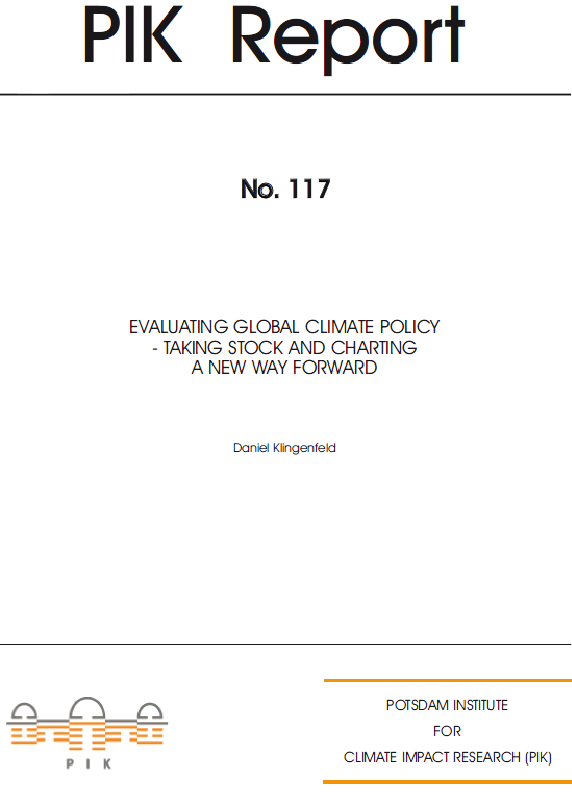
"Science has made a number of proposals on global burden and opportunity sharing. The most prominent examples include contraction and convergence (Meyer, 2000),If contraction and convergence were chosen as a burden-sharing principle, then converging per-capita emissions allocations over time could easily be expressed in terms of a dynamic climate rent sharing in the framework proposed here without affecting any of the underlying benefits in terms of environmental and cost effectiveness."
PIK Report No. 117 EVALUATING GLOBAL CLIMATE POLICY
TAKING STOCK AND CHARTING A NEW WAY FORWARD
Daniel Klingenfeld05 March 2012 - Naive analysis from Tearfund. The problems identified are with the process & not with C&C.
Contraction and Convergence Tearfund
"The idea of Contraction and Convergence is that all countries converge on the same emissions target expressed in carbon per capita by 2030 � developed countries reduce, while developing countries can continue to grow. Many commentators have rejected Contraction and Convergence in recent years, as the changing science makes it unlikely that it can be environmentally adequate. This, coupled with the larger than expected growth from developing countries, makes it difficult to perceive a scenario where emissions could converge in a way that does not exceed safe temperature rises."
The idea that the 'problems' declared here do not apply perhaps in even greater measure to the other proposals they identify is absurd. This is particularly true of the 'Greenhouse Development Rights' which Tearfund and OXFAM et al favour. This, with the full rigour of a healing frenzy, 'scientifically demands negative-emissions-entitlements for the US and its allies permanently after 2029' i.e. within 16 years of now [!]. [This extreme and inflammatory idea was made even more so by Nicholas Stern [to camera] in Poznan.
While charities like 'Islamic Relief' are exemplary for practicing moderation and restraint with their pay policies, it is not lost on anyone that 'charities' like OXFAM pay the first odd �100,000 of their charitably raised income, not on 'the poor', but on the salaries of their CEOs. While they line their pockets promoting extreme and divisive ideas they are promoting ideas that encourage rather than resolve conflict. In turn, this guarantees the income that comes from further failure.They also fabricate and promote absurdly inaccurate comment about C&C as part of this strategy - rebutted here by Tangent Films Director Mike Hutchinson.
05 March 2012 - "If Music be the Food of Love", touch-and-then-play on this . . . 1st Law of Theoretical Physics
Pythagoras� law of stringularity as a universal constant, is easily demonstrated audio-visually here
Click nodes - 'blue' for chromatic-scale and 'gold' for harmonic series - 'on' and 'off' in 'series/parallel' to make 'melody/'harmony'.Pythagoras� �law� is revealed in a string at constant tension and length, in the cello G-String shown for example. The image has Hz values based on G'o'=100 Hz, which is equivalent to a Cello G-String. Here, Herz values have been slowed visually by a factor of 100, so the Herz doubling for the octave and trebling for the fifth [etc] can more easily be �seen� as well as 'heard' [as 'doublings', treblings' etc].
The audio-visual file for this is here Mouse-touch [one click �on�, second click �off�] the gold-coloured buttons in the image to both hear and see how the �harmonics� of the whole string or the �overtone series� emerges �harmoniously� from the �fundamental� G. The blue-coloured buttons for �chromatic� notes are in between but not �harmonics�.
05 March 2012 - Climate & Health Council - "C&C - Science, Logic, Inclusive, Global."
Contraction and convergence (C&C) is a practical suggestion to reduce global carbon emissions over the time scale required to prevent catastrophic climate change.C&C is based on the principle that all human beings are equal and therefore have the same rights to emit carbon emissions. A per capita, per annum, allowance of one tonne of carbon emissions (carbon footprint allowance) is calculated by dividing the maximum global carbon emissions equally between the population of the world. Â
The maximum global carbon emissions is the upmost amount of carbon that humans can emit before feedback loops increase global warming further and catastrophic climate change results.
Those who emit less than one tonne of carbon per annum may sell the rights to emit to people who emit over one tonne. Many people, particularly those living in developed countries, can make drastic reductions in their emissions in order to live within their carbon allowance.
Many health professionals are already calculating their carbon emissions and making steps towards living a “one tonne lifestyle”. Various carbon calculators are available online â�� see the ACT page of this website for more details. To network with others who are working to reduce their carbon footprint, an online forum is also available.
Frequently Asked Questions
A) Â How does it . . . .
Climate and Health Council05 March 2012 - "C&C - from income-based to equal per-capita-based distribution." Climate Spectator
There are several proposals on the rights and responsibilities of developed and developing countries in sharing the responsibility of mitigation: One possibility is to acknowledge current levels of greenhouse gas emissions (or a proportion of them) as rights as implied by the Kyoto Protocol. Secondly, the contraction and convergence argument proposes a transition from the current income-based distribution of emissions to an equal per capita distribution. Thirdly, it is possible to allocate emission rights according to the countries’ historical responsibility for greenhouse gas emissions.
Accommodating Chinas's Emissions - Climate Spectator05 March 2012 - Hackney Citizen "C&C brings social and environmental issues into a single framework."
Wilkinson and Pickett say: “Rather than believing that consumerism is an unavoidable expression of human nature which will inevitably prevent us from responding adequately to global warming, we need to recognise that it is a reflection of the social environment created by great inequality and which can be countered by reducing inequality.”Potentially, this leaves us in a virtuous circle, where increased equality leads to lower carbon emissions, and lower carbon emissions reduces the threat of events such as extreme weather which affect the poorest hardest.
On an international level the same dilemma applies. In response, nations are starting to follow the contraction and convergence model, whereby a sustainable average level of carbon emissions is met by large reductions in wealthier, more historically responsible countries, and an increase in development and so carbon emissions by poorer countries.
Could this be applied locally? A host of tricky ethical issues â�� particularly the personalisation of relative carbon consumption â�� say no. Still, I like the way contraction and convergence clearly brings environmental and social issues together into a single framework. And in reducing personal carbon emissions and allowing others to increase theirs (to an extent), we’d be directly linking a complex chain of environmental impacts into social equality, and perhaps also understanding more directly the value of the carbon we use.
Hackney Citizen
04 March 2012 - Goldman School of Public Policy Uni California Berkeley: "C&C most appealing."
Contraction and Convergence
Let us begin with a fair share concept that is one of the most appealing as a matter of practicality, simplicity and transparency: the 'contraction and convergence' (C&C) standard described in GCI (2005). Contraction is the process of reducing collective emissions to meet a concentration goal, e.g., 550ppm. Convergence is the process of redistributing those emissions among countries to eventually attain equal per-capita emissions. Many of the fair share methods rely to some extent on the norm of equal per-capita shares, particularly in the long-run when unequal economic circumstances across jurisdictions might be reduced and all countries developed.
Under the basic approach, one must pick a year by which all countries will agree to converge on an equal per-capita allocation. One must also choose a base (starting) year, and a global emissions target in the year of convergence. All countries’ emissions allowances then change linearly over time from their current levels to an equal per-capita share of the chosen target in the year of convergence. While for most countries this will be a gradual decline in emissions, a number of less developed countries with current per capita emissions below the target for convergence would be allowed an emissions budget that gradually rises. Some authors, including GCI, recommend using the population shares as of the base year to avoid encouraging population growth; others recommend against that, reasoning that this incentive is small compared with all the other incentives involved and that such action effectively punishes future inhabitants of countries whose current growth rates are high.
For purposes of our exercise, we set the base year at 2012 (when California’s new regulatory system goes into effect) and the year of convergence at 2050 (the target year for attaining California’s long-run goal of emissions at 20% of the 1990 level). We specify the global emissions target in 2050 at 53.11 GtCO2e, a level calculated from IPCC data on Scenario B1, which involves stabilization near 550 ppm.44 We used 2000 population levels: 6.122 billion for the world (from the same IPCC Scenario B1 Image) and 33.87 million for California from the U.S. Census, yielding a population share just under 0.6% for California.
We used the IPCC Scenario B1 Image figures for the GHGs included in the calculation of California’s emission goals (CO2, CH4, N20, CFCs, PFCs, and SF6), converting by using the global warming potentials from the IPCC Second Assessment Report (as specified in the Kyoto Protocol) into CO2e. These figures are commonly expressed in metric gigatons (Gt) and megatons (Mt), where 1 gigaton equals 1000 megatons and 1 megaton is one million metric tons (1Mt = 1mmt).
Under these assumptions, California’s emissions allowance in 2050 would be 293.8 MtCO2e. However, the Governor’s 2050 target is 20% of 1990’s 426.6 MtCO2e, for a considerably lower value of 85.3 MtCO2e. In other words, California’s actual 2050 target is a very ambitious target compared to this standard. The C&C standard would only require California to cut back to 69% of its 1990 level, whereas the adopted goal is 20% of the 1990 level. The C&C goal may seem modest only because California starts from a relatively â��cleanâ�� position for a developed jurisdiction. In 2020, allowable emissions under C&C with the above assumptions lie along a line segment between 2012’s emissions (estimated at 537 MtCO2e) and the 2050 value, for a 2020 target of 441.9 MtCO2e. The AB32 target of 426.6 MtCO2e is again lower, albeit only slightly.
Under the assumptions above, C&C yields a total CA emissions allowance of 15.8 GtCO2e from 2012-2050. This is substantially above the 10.5-12.4 GtCO2e range from our three illustrative compliance paths. Put differently, any of the three shapes would more than satisfy environmental equity if California’s responsibility from a global perspective were judged by the C&C standard with 2050 as the date of convergence.
Of course there is nothing magical about 2050; one can imagine the date of convergence being either earlier or later and that would change the fair share calculations. We are reluctant to consider later dates because we think it critical that emissions globally are under control by this time. We do consider earlier dates, recognizing that they may be impractical (in terms of actual global accomplishment) unless new evidence propels the world to act more quickly than suggested by the most recent IPCC assessment. Moving the date of convergence forward to 2030 tightens California’s emissions allowance to 13.4 GtCO2e, still higher than any of our three illustrative paths. In the extreme case of convergence in 2012 or earlier (effectively meaning a uniform per capita standard around the globe from the outset of the program), California’s cumulative emissions allowed from 2012-2050 would be 11.0 Gts, slightly lower than the allowance produced by a linear pathway.45 We think this last calculation simply shows the aggressiveness of the California standards, as we think the likelihood of global political consensus and action around this norm is quite low.
January 2010
Intertemporal Regulatory Tasks and Responsibilities for Greenhouse Gas Reductions
By Jeffrey A. Deason and Lee S. Friedman*
Goldman School of Public Policy - University of California at Berkeley04 March 2012 - Transition Town High Wycombe "Global policy is likely to resemble C&C."
Global policy is likely to resemble the Contraction and Convergence (“C&C”) Framework from the Global Commons Institute (GCI). It applies a principle of equity for all, ie, we all have the same right to produce CO2. So we can plot lines for our nations current per-capita footprint to the sustainable equity footprint at some future point and that will represent the rate at which we HAVE to cut emissions. We would have to cut CO2 emissions by 90% by 2030. (Alternatively, to meet the 400ppm deadline in 2016, we have to aim to cut GHG emissions by 60% within ten years.) As a country our Government has committed us to cut CO2 emissions 12.5% below 1990 levels before 2012 (under the Kyoto Protocol) and by 60% by 2050. The figures are only different because of the level of risk our leaders POLITICALLY are willing to face. However the choice is clear. We have to make enormous cuts and quickly. There is nothing to stop Local Councils adopting a Target-Based Contraction Framework based upon any of these figures.
Transition Town High Wycombe
See here for more transition entries.
04 March 2012 - "The Qualities of Climate Leaders" Stephen Keim Australia on Keeling, Hansen & Meyer
The Qualities of Leaders - Stephen Keim, Perth Australia
On David Keeling, Jim Hansen and Aubrey MeyerCharles David Keeling died at his Montana home of a heart attack on 20 June 2005. In a speech marking Dave Keeling�s passing and honouring his scientific work, the Director of his Institute compared Keeling�s measurements of background levels of carbon dioxide in the atmosphere to Tycho Brahe�s measurement of the planets and Albert Michelson�s measurements of the speed of light.
It was Dave Keeling�s love of the outdoors and the environment that led him to the field in which he made his great scientific contribution. As a post doctoral student at the California Institute of Technology in the mid-1950s, Dave was committed to his work as a chemist but he spent as much time as he could find travelling mountains and woodland rivers. He chose research projects that would keep him in direct contact with wild nature. Measuring the level of carbon dioxide in the open air was a pretty good decision in that regard.Previous attempts at measuring CO2 concentrations in the atmosphere had produced widely fluctuating readings such that Carl-Gustav Rossby, a leading commentator, had described the task as �almost hopeless�.
In tackling the task, Dave Keeling had to create his own tools. No instrument available to purchase had the necessary accuracy to make the kind of fine measurement that was necessary. Months of hard work and ingenuity, therefore, went into solving that initial problem.4 While still based at Caltech, Keeling used his newly made instrument to measure levels of carbon dioxide in pristine locations around California including at Big Sur, an area that is both mountainous and coastal. He began to get the same reading from a number of locations and on different days. Having achieved a degree of stability in his measurements, when fluctuations occurred, he was able to track down the source of the interfering concentrations. He was scrupulous and tireless in this pursuit. At last, he knew that measuring the background level of carbon dioxide in the atmosphere was possible. But this was only the beginning.Jim Hansen and the attempts to silence him are discussed in Mark Bowen�s book about him as follows: -
�One sweltering June afternoon in 1988, an understated Iowan named Jim Hansen turned global warming into an international issue with one sentence. He told a group of reporters in a hearing room, just after testifying to a Senate committee, it�s time to stop waffling � and say that the greenhouse effect is here and affecting our climate now.�
Jim Hansen�s approach to life is reflected in his approach to science. It is about the relationship between the truth, the evidence and what we would like the evidence to be. He attributes his approach to a quote from the famous, Nobel Prize winning physicist, Richard Feynman, as follows: -
�The only way to have real success in science � is to describe the evidence very carefully without regard to the way you feel it should be. If you have a theory, you must try to explain what�s good about it and what�s bad about it equally. In science you learn a kind of standard integrity and honesty�.
Jim Hansen commenced employment as a post doc at NASA�s Goddard Institute for Space Studies (�GISS�) in New York in January 1967.8 He is still there and has been the director of GISS since 1981. His early work at GISS involved using the light scattering effects of particles in the atmosphere to identify aspects of the atmosphere of Venus.9 This equipped Jim to work on the heating of earth�s atmosphere by sunlight as part of GISS�s work in developing a computerised weather model.10
Aubrey Meyer is a former concert viola player. He was born in Bingley, Yorkshire in 1947 but, from the age of five, he grew up in Cape Town, South Africa. Until 1988, he was a successful composer and player with the Scottish Theatre Ballet, the Sadlers Wells Royal Ballet and the London Philharmonic Orchestra. It was in researching the story of Chico Mendez and his assassination in the Amazon rainforest that Aubrey Meyer came upon the issues raised by climate change.
The issues raised by the Mendez story “diverted him from music to the UK Green Party”. Here he co-founded the Global Commons Institute (“the GCI”) and started to develop a program based on the premise Equity and Survival. It is this emphasis on the simple proposition that equity is at the core of any solution to climate change which makes Aubrey Meyer stand out.
In 1996, Meyer and GCI came up with the idea of Contraction and Convergence as the method by which the world must equitably reduce its greenhouse emissions. The idea is explained in a review of the book of the same name by Mayer Hillman.23 Hillman describes the concept in the following terms:“It requires the reduction to be completed within a timetable determined by scientific evidence whilst at the same time programming the reduction towards an end-state of equal per capita emissions. He argues convincingly that this is the only way of avoiding ecological catastrophe.’
~~~~~~~~~~~~~~~
My point in choosing Aubrey Meyer is that climate change leadership will require a very high moral component. Much of what has been said, pre-Copenhagen, has been designed to disguise and hide the tough moral decisions that the future holds. Talk about technology transfer from the developed countries is just a way of avoiding the issue. The demands by countries like India and China not to be frozen out of a western standard of living only makes sense if those countries are also prepared to say how much of a western life style is enough for them. The individual carbon ration, in whatever form it is delivered, is the only way in which climate change can be faced on an equitable basis.
Game theory explains why equity is very important to solving climate change. Solving the problem is a game where any one player can wreck the game for others. If China will not play, the rest of us will go under the waters with China. It is only when everyone is satisfied that the rules of the game are fair that the game can effectively be played. It is only when leaders approach the question on the basis of equity that climate change will have any hope of being controlled.
Some of the qualities we will need from our leaders are shown by the three people whose work I have briefly described. Each of Dave Keeling, Jim Hansen and Aubrey Meyer has shown great persistence.
Jim Hansen, I think, has shown enormous courage as well as persistence. He has been and will continue to be vilified for speaking out and talking to the public in the way that he has. Each of the three has shown great creativity. We will need our leaders to come up with ideas at each stage of the difficult process of combating climate change.
Aubrey Meyer has shown a particular form of leadership: the ability to see through the dilemma to the moral answer. He has understood a particular moral truth, namely, that when everybody is being asked to change their way of life, the easy shortcuts are no longer available to anybody.
As I mentioned at the beginning, my discussion is not premised on the assumption that we will only be looking for these qualities in our formal leaders, particularly, those at the political level. As this discussion has perhaps shown, climate change is too important to be left to politicians. Each of us will need to be prepared to show the same qualities of leadership if progress in combating the future is to be made.
Leadership for Climate Change Times Three
Notes for a paper presented to the Resources Management Law Association Conference, Wellington,
04 March 2012 - "C&C so eminently fair its endorsed by the British Chartered Insurance Institute." Royal Society
In Europe, the need to reduce greenhouse gas emissions is now widely accepted. The European Parliament, along with Africa, China and India, all accept the concept of �contraction and convergence� (C&C) (Meyer 2000) which is consistent with the basis of the UN Charter that everyone in the world should have equal rights. It is also consistent with the principles of �utilitarianism� as propounded by Jeremy Bentham, the founder of University College London. The basis of Utilitarianism is �the greatest happiness for the greatest number�. C&C starts with the premise that everyone should have equal rights to emit
carbon pollution. The concept is so eminently fair that it has been endorsed by the Quakers and the Church of England. It has also been recommended by the British Chartered Insurance Institute report on climate change (Dlugolecki et al. 2001).
However, if everyone had an equal allowance on a per capita basis to stabilize emissions to a safe level, this would involve limiting carbon emissions to 0.3 tonnes per person per year�about the amount emitted per passenger on a New York to London return flight (Hillman & Fawcett 2004). Currently, per capita carbon emissions average 20 tonnes in the USA, 10 tonnes in Britain and 1 tonne in India.
What can cities do to increase resilience? David Crichton
04 March 2012 - "Managing catastrophic climate risk - 6 step plan" Ian Dunlop in Brave New Climate
Managing catastrophic climate risk � the six step planGuest Post by Ian T. Dunlop. Ian was formerly a senior oil, gas and coal industry executive. He chaired the Australian Coal Association in 1987-88, chaired the AGO Experts Group on Emissions Trading in 1999-2000 and was CEO of the Australian Institute of Company Directors from 1997-2001. He is a CPD fellow and is currently researching policy responses to climate change. He is deputy convener of the Australian Association for the Study of Peak Oil.
Fourth is the need for genuine global leadership. Current responses reflect the dominance of managerialism â�� an emphasis on optimising the conventional political and corporate paradigms by incremental change, rather than adopt the fundamentally different normative paradigm needed to contend with the potential for catastrophic failure. In practical terms, leadership means committing today to rapid emission reductions, irrespective of “prisoners dilemma” considerations, and actively promoting concrete proposals to involve the developing world.
For example via the Contraction and Convergence concepts mooted in the Garnaut Draft Report, but well in advance of the UNFCCC 2009 Copenhagen meetings. The conditional approaches recommended by both business, government and the Garnaut “Targets & Trajectories” Report almost inevitably becoming self-fulfilling barriers to progress globally. A nexus-breaker is urgently needed, and Australia is ideally placed to provide it, with the potential for considerable national benefit.
Brave New Climate
04 March 2012 - KEY MESSAGE to UNFCCC "Negotiating Equitable Access to Global Common Atmosphere"
Accelerated Convergence
KEY MESSAGE to UNFCCC on negotiating Equitable Access to Global Commons Atmosphere
Regarding Decisions at COP-17 for ‘increased ambition’ equals 'accelerated convergence'. Negotiating UNFCCC-compliance globally, *Accelerating the rate of Convergence relative to the rate of Contraction* provides *the Main International Equity Lever.*“C&C has the virtue of simplicity. Equal per capita emissions is a natural focal point. Contestable computations based on economic variables do not need to enter the allocation formula.”
Review of Climate Change Economics to the Australian Government by Ross Garnaut - 2008
“Since the principle of ‘contraction and convergence’ was first proposed by the Global Commons Institute in 2000, it has been widely embraced by some industrialised countries. Under contraction and convergence, each country will start out with emission entitlements equal to its current real emissions levels, and then, over time, converge to equal its per capita entitlements, while the overall global budget contracts to accommodate the emissions reduction objective. The convergence principle should be applied immediately rather than later as the ‘converged point’ in the future. ‘Real emissions’ is a different concept to ‘emissions entitlement’. A country’s high/low per capita real emissions cannot justify its high/low emission entitlements. In the process of convergence, the rights and interests of country B are really infringed by country A. In the National Emissions Account-based solution, the concept of convergence can still be incorporated, but it now merely means ‘convergence of real emissions’ rather than ‘convergence of emission entitlements’. Each country’s gaps between its emission entitlements and real emissions need to be balanced by the traded emissions quotas.”
Development Research Council to the Chinese Government - 2009
“We believe that it is difficult to imagine a global deal which allows the developed countries to have emissions per capita which are significantly above a sustainable global average.”
UK Government’s ‘Committee to the Climate Change Act’
KEY MESSAGE to UNFCCC on negotiating Equitable Access to Global Commons Atmosphere
04 March 2012 - C&C Principles for Emissions Reductions - Stephen Stretton
In addition to global targets, it may also be useful to consider national targets. In order to translate between global targets and national targets we need to use some principle to translate between the two. The Royal Commission on Environmental Pollution report (Royal Commission on Environmental Pollution 2000) recommended the use of the principles of �Contraction and Convergence� developed by Aubrey Meyer of the Global Commons Institute. By assuming a date where all global emissions converge, the model assumes that the whole world converges to a single per-capita level of emissions. Under these assumptions it is also possible to derive a global emissions target. Since the RCEP report, C&C has become the de-facto standard for translating between a global and a national targets.
Principles For Emissions Reductions
Stephen Stretton
04 March 2012 - "Development economics & misrepresenting C&C doesn't trump environment reality." CIRED
Climate policies in a second-best world - A case study on India
Sadly, development cconomics doesn't trump environment reality or justify distortion of C&C.
The [misguided] aim of this article is to analyze the potential for synergies between climate policies and development in a case study on India focusing on the power sector sub-optimalities. To do so, we use Imaclim-R, a dynamic recursive energyâ��economy model that represents a second best world with market imperfections and short-run adjustments constraints along a long-term growth path. The analysis suggests (i) global carbon pricing induces prohibitive macroeconomic costs for the Indian economy, even in the case of significant financial transfers associated with a global cap-and-trade system and a ‘Contraction and Convergence in 2100’ allocation scheme and (ii) the most cost efficient climate policies are not uniform carbon pricing only. The implementation of domestic policies suited to the national context, for instance targeting sub-optimalities in the power sector for India, allows reducing significantly the macroeconomic costs induced by international mitigation policies.
Sandrine Mathy et C�Šline Guivarch ; Energy Policy ; 38(3) ; Mars 2010
03 March 2012 - Green Party India "C&C Survival and Equity are inextricably linked."
The economists are at the point where they may possibly incorporate our economic suggestions just like they have incorporated out contraction and convergence model in their equity thinking since 1989. That all the equity models will be stuck for just as long as the utility models is obvious: there is no solution other than making all humans sequester more GHGs than they personally emit, and for that each human being has to be given the SOCIAL AND ECONOMIC WHERWITHAL INCLUDING THE BASIC INCOME GRANT and the GRAM SANBA AND TOWN WARD COMMITTEE CONSENSUS FORA to do their fair share of CARE WORK FOR THE MAINTENANCE OF LIFE. The system creates jobs that save the planet, as we know. As we have been saying all along: equity and survival are inextricably linked.
Climate Himalaya
Green Party of India
03 March 2012 - Christian Ecology Link play a crucial role in Cof E. CEL's next conference is 10 March 2012
Christian Ecology Link [CEL] have been strong supporters of C&C and play a crucial role in the Church of England.
CEL is holding a Conference on the 10th of March at which Jonathon Porrit is a key-note speaker.CEL's influence is vital. For example they helped development of the C&C arguments for achieving climate-justice that appeared CofE's Book "Sharing God's Planet".
03 March 2012 - C&C in Module at the Marine Technology Eductional Consortium at Newcastle University
TCE2 - Module on Renewable Energy: Policy, Politics and EthicsVenue:Â University of Newcastle upon Tyne
Staff:Â Professor I Arbon
Aims:Â The aim of the module is to provide students with an appreciation of the political and ethical context of renewable energy at international, national and local level and for students to be able to critically review Government energy strategies.Â
The module provides students with the 'sustainability' context for renewable energy (whether in the form of electricity, heat or transport), to critically review Government energy policies and strategies and to form a view on whether these are adequate to achieve the extremely ambitious yet legally-binding 2020 renewable energy and GHG emissions commitments.
Module content:Â The module will cover the following topics:
- Why Renewable Energy?: -
Brief history of renewable energy; - UK energy policy to 2003.- Development of UK Energy Policy: -
Review of pre-school assignment; - UK energy policy 2003 to date.- Policies, Politics Ethics: -
Introduction to ‘Politics’; Introduction to ‘Ethics’.- Review of Mallon’s Book: -
Review of Ch.1-3 of course textbook.- Climate Change and Energy - Global population growth; -
Global energy demand; - Greenhouse Gas Emissions; - Contraction and Convergence; - Socolow’s wedges.- Sustainability & The Energy Hierarchy: -
Definitions of Sustainability;
‘Triple Bottom Line’ Diagrams;- Dwindling fossil fuel supplies; - Using the Energy Hierarchy.- NIMBYism and Technical Illiteracy: -
NIMBYism and Planning issues; - Growing problem of ‘technical illiteracy’.- Sustainable Heat: -
The UK’s primary need for heat energy; -
Recovery of wasted heat; - Passive solar principles and the Passivhaus concept.- Sustainable Biofuels: -
Different types of ‘energy crops’; -
Solid, liquid and gaseous biofuels; - Conversion technologies; - ‘Food vs. fuel’ debate; - Gallagher Review;- Sustainable Transport Energy: -
2020 energy and emissions commitments for transport; -
‘The Carbon Challenge’ for transport; - Problems and solutions.Â
- Integrated Energy Policy: -
German Federal Integrated Strategy; - the ‘negawatt’ power station (California).- Energy from Waste: -
Introduction to waste management; -
the Waste Hierarchy; - Intro. To Energy from Waste (EfW); - Waste Incineration Directive (WID).- Waste as Resource: -
Development of the ‘Waste as Resource’ (WaR) concept; - Practical implementation.- EfW and Ethics: -
Review of IMechE Reports on EfW and WaR; - Discussion of ethical and political issues.- Barriers to achieving targets: -
Government and Public Sector; - Abuse of BAT & WID; - Role of EA & SEPA; - ‘public’ misconceptions.- Case Studies: -
Application of ethical principles to different renewable energy technologies.- Sustainability & The Energy Hierarchy: -
Definitions of Sustainability; ‘Triple Bottom Line’ Diagrams;- Dwindling fossil fuel supplies; - Using the Energy Hierarchy.- NIMBYism and Technical Illiteracy: - NIMBYism and Planning issues; - Growing problem of ‘technical illiteracy’.
Marine Technology Eductional Consortium
03 March 2012 - Katie and Amy debate Climate Justice and C&C [a piece of cake?].
In the history of ideas, this is a relatively new one, which is used to highlight how the burdens of climate change are likely to be borne disproportionately by people who are already dealing with poverty and/or powerlessness. Meanwhile, the benefits of the activities that cause climate change are enjoyed disproportionately by the world’s richest and most powerful people, with their resource-intensive lifestyles. But I found that understanding the dictionary definition of the term generates more questions than it answers. It doesn’t provide an immediately straightforward path for dealing with the problem â�� indeed, the closer you look, the messier the situation seems.
Just outcomes
This is a huge topic. Many arguments have been put forward as to what it is that makes an outcome just, or fair. This short discussion won’t do them justice (ahem), but hopefully I’ll give you a taste of what they’re about. One of the obvious types of justice at this level is distributive justice, the idea that an outcome is fair if it allocates costs and benefits in a fair way. But ‘fair’ here could mean a variety of things. Say you have a chocolate cake you’d like to share with 10 of your friends. You might say it’s fairest to give everyone an equally-sized piece of cake â�� an equal allocation of benefits. But what if two of your friends have just been to a bakery and bought themselves cake already? Maybe it would be fairer not to give any chocolate cake to the friends who already have some, because they don’t need any more. That would be another type of distributive justice, on the basis of necessity.
Katie said
Love the cake analogy Amy � really helps to understand the problem of the negotiations. I guess it could then be used to explain contraction and convergence?
Amy replied
Hi Katie - Yes, I think the cake analogy could be used to explain contraction and convergence. With C&C, the ‘cake’ represents the total amount of greenhouse emissions that the designers of the C&C scheme believe it is safe for humanity to create each year (again, there is a value judgement at this point because the decision about levels of safety involves assumptions about how many extra deaths we can tolerate, how many ecosystem disruptions we think will be ok). The idea behind C&C (I think â�� haven’t looked at this for a while) is that eventually, every single person on earth should be entitled to an equal amount of emissions â�� an equal right to pollute. So eventually, everyone ought to have an equally-sized slice of cake. But we can’t create that situation straight away. So you start off by giving everyone a cake slice sized according to what they’ve been used to emitting, historically, but you tell them that at some point, the size of the cake slices will contract, until they reach the size that represents an equal division of the right to pollute the atmosphere. Each year, or decade, or whatever, you change the amount of cake, so the allocation becomes closer to the ideal allocation â�� that is, closer to everyone having exactly the same amount of cake. So C&C is based on an idea of distributive justice that says a situation is fair when everyone has an equal share of the benefits â�� in this case, the benefit of being able to do activities that produce greenhouse gas emissions. It all gets a lot more complicated when you think about the practicalities but that’s as far as the cake analogy goes, I think!
03 March 2012 - India Environment Portal [CSE] and materials relevant to C&C
A selection of publications tagged with C&C at: -
India Environment Portal Managed by CSE and promoted by the National Knowldge Commisssion
including;
GCI brochure for a corporate audience, was published for COP-14 Poznan making the case for
the C&C Framework and the urgent need for this to be the basis of UNFCCC negotiations.
Carbon Countdown03 March 2012 - Monash University; "If negs achieve C&C, growing old in carbon constrained world is possible."
A global carbon target using human life expectancy
Date: - 22 March 2012
Category: - Conferences, Seminars, Lectures
Contact: - Tahl Kestin - tahl.kestin@monash.edu - 03 990 52350
A Monash Sustainability Institute (MSI) Seminar by Paul Read
Monash Sustainability Institute and Faculty of Medicine, Nursing and Health Sciences.
Date & Time: 1-2 pm, Thursday, 22 March 2012
Venue: Lecture Theatre H2.35, Building H, Caulfield Campus
RSVP: None required. All welcome.
Carbon budgets leading up to 2050 paint a grim picture for late adoption of a ‘Contraction and Convergence’ target, even more so if social progress is predicated on linear conceptions of economic growth. In this work, Paul outlines a cross-national study of two competing carbon budgets against life expectancy and uncovers an important ‘Goldilocks’ trend that has remained stable over the past half century, and will likely have implications for human health leading up to 2050 and beyond. If international negotiations can achieve a fair Contraction and Convergence target within enough time, there is every likelihood people can grow old, and perhaps even older, in a carbon-constrained world.
Paul Read is a research psychologist, public health lecturer and Fellow at the Monash Sustainability Institute, where his work focuses on human needs and their sustainability across countries and time. He has worked with Harvard, the United Nations and World Health Organization.
02 March 2012 - "Writing about C&C for a potentially diverse readership has been difficult."
This book from 1999 was written 12 years ago. It was written in blood after a decade of campaigning for C&C at the UN, by when I had become homeless. It has now been cited more times that can be counted. But how often it has actually been read is perhaps another story."I�ve never been anything other than a musician. How I ended up devising a global policy concept at UN climate negotiations for the last ten years is still a bit of a mystery to me. But a clue is that both writing and playing music are largely about wholeness and the principled distribution of 'effort' or practice. Responding to the climate challenge seems much like writing or playing music, where balance on the axes of reason and feeling, time and space, can only come from internal consistency. If practice is unprincipled there is no coordination and there is discord. When it is principled, there is balance, harmony and union. Perhaps all life aspires to the condition of music.
While I hope this Briefing will appeal to the hearts and minds of a wide range of people, writing about C&C for a potentially diverse readership has been difficult. This is because, although we are all in the same boat in relation to climate change, we live in and see very different parts of it. Try addressing an audience made up of the anxious, the agnostic, sybarites and over-worked mothers. Then there's academia, 'policy makers' and bureaucracy. How do you persuade them, and especially the economists among them, about anything, let alone the logic of global equity in climate policy or letting go of guesswork? With honourable exceptions, those in a position to develop a response to the threat have chosen to remain captive to the very forces that now threaten us. Rather than seeking to calm the global climate, they have sought to calm us instead with mere economic management dogma. And while some of these have preened and quibbled, islands are threatened by rising seas and more and more people die from droughts, floods and other extreme events."
C&C is now the most widely cited argument in the debate. It is arguably the most widely supported.
02 March 2012 - Yvo De Boer at Chatham House reviewed on his 'confused C&C answer'
An event was held at the Chatham House Tuesday 28th February 2012 and it was called: -
"An International Climate Treaty: Is it Worth Fighting for?"
The speaker was Yvo de Boer - Special Global Advisor on Climate Change and Sustainability, KPMG;
Executive Secretary, United Nations Framework Convention on Climate Change (2006-2010)
The Chair was Michael Jacobs - Visiting Professor, Grantham Research Institute on Climate Change and the EnvironmentSo what is wrong with de Boer's answer to Mayer Hillman?
Answers on Yvo De Boers page~~~~~~~~~~~~~~~~~~~~~~~~~~~~~~~~~
Chatham House published the Q&A transcript to the web straight afterwards
Question from Dr Mayer Hillman after the speech:"What concerns me most about your lecture is the fact that you didn't project, in my view, sufficiently, the gravity of the situation. You used the word 'important' on several occasions, that it was important to achieve an international climate treaty. It's not important, it's essential. You know that. Why didn't you use that word?
Beyond that, you also said in your introductory remarks that you are unaware of anything that approaches towards a global solution. You are I'm sure aware of the Global Commons Institute's framework proposal on contraction and convergence. It seems to me that that should be the point of departure on the understanding that we now know that the atmosphere has a finite capacity to absorb further burning of fossil fuels. That seems to me should be the subject on which we focus. When we then divide that by the world population, we arrive fairly logically, morally, practically at an equal share across the world population because as we contract so we converge towards equal per capita shares."
Answer from Yvo de Boer:
"Well I think for me to say in all honesty that an international legally binding treaty is essential; I would want to understand better what exactly it means. I think part of the problem at the moment is that people are using those terms very loosely. I would agree with you absolutely that we need an international agreement that measures up to the environmental challenge we are faced with. I think in terms of measuring up to that challenge, we need to be realistic.
I know about contraction and convergence; I think that the first time I asked an American negotiator what do you think of contraction and convergence - I think it must have been in 1996-7 - his reaction was well we don't contract or converge on anything else in life so why should we do it on climate change. I fully agree with you on the merits of the concept, but I think we need to be pragmatic in terms of how we can build an architecture that gets us to that concept. I think the concept in itself is very difficult to get adopted in a formal sense. Therefore, being a pragmatist, I would much more focus on the architecture that will get us to that result, rather than having a conceptual debate."
So what is wrong with de Boer's answer to Mayer Hillman?
It is a variant on classic 'solution-denial'.So what is wrong with de Boer's answer to Mayer Hillman?
Answers on Yvo De Boers page02 March 2012 - Cartoon "Stop the Fat Cats - C&C the most promising plan that the world can sign up to."
The most promising plan that the world can sign up to in order to reduce CO2 limits is Contraction and Convergence. It is appealing because it is simple and fair: under the plan every person on the earth has the right to emit an equal quantity of carbon dioxide. This sidelines the discussion about whether the US or China is the worst sinner, since in these terms the US loses out every time. No wonder that the proposal - nor anything similar - was not on the table at Copenhagen.
'Contraction' and 'convergence' are not attractive words and it is hard to imagine people marching the streets shouting 'What do we want?' 'Contraction and convergence', 'When do we want it?' 'Now!'. But what the plan neatly does is to link the need to limit economic activity to the need to share its proceeds fairly. Part of the reason governments are addicted to growth is that it allows them to sideline issues about distribution. Now that the world has run up against planetary limits, the link between the greed of a few and the need of the many is going to be harder to avoid.
But surely the same applies in our own country. The origin of the UK's economic collapse was clearly in the debt-ridden financial system and the government bailout, but for many green-minded economists, a shrinking economy could be a step towards living more in balance with what the earth can provide. Our proposals would require a reduction in consumption levels from those of the debt-fuelled binge of recent years.
The other side of our argument is that the smaller quantity of stuff would have to be shared fairly, so we cannot have sustainability without equity and we should not have a contraction of our national economy without a convergence in our levels of wealth. This is a proposal we could make in our own workplaces: if jobs are threatened and pay cuts loom, we should propose that the shortage of cash is addressed by reducing the wage differentials.
Recent evidence has shown clearly that inequality is the root cause of many of the social evils of 21st century life. It is also a driver of environmental destruction. The recession gives us the chance to argue for a better, fairer sharing of the earth's resources. Contraction and convergence is just as relevant domestically as it is globally.
We've got the contraction - what about the convergence?
02 March 2012 - "The Same Boat" Witty and wicked cartoon and another article from GAIAN Economics
At the global scale, we call for a Contraction and Convergence - reducing energy consumption to a level that the planet can survive, and sharing this equally between all the world's people. At a national level I would suggest a similar approach to tackling the debt. If there must be public-sector pay restraint, then the lowest paid should still see increases, with the cuts coming to the best paid. This would address the deficit while simultaneously reversing the inequality that is so pernicious to social health. For the private sector, a maximum wage differential and considerably more progressive tax system could effect a similar convergence of incomes.
Just as we argue for the global contraction and convergence as a way of enabling our economy to fit within planetary limits, so we could consider the need to reduce the need to reduce government spending as part of a policy of a managed reduction in economy activity. As argued by the degrowth movement, this help us to 'put the economy in its place'. Over the next decade we could take what Marshall Sahlins eloquently calls the 'Zen road to affluence', valuing our selves, each other and the beautiful world we share, rather than burning oil and cash to provide ourselves with more stuff.
Blood, Sweat and Tears?
GAIAN Economics02 March 2012 - "Contraction and Convergence" SDGs for Rio+20 Ahshok Khosla Dev Alt IUCN IRP Club of Rome
No More Meaningless Goals! Negative Lessons from MDGs:
- Absolutes, NOT Percentages
- More Ambitious and Bold
- For both North and South
- Define Metrics
Contraction and Convergence
Sustainable Development Goals for Rio+20
Ashok Khosla, Development Alternatives, IUCN, IRP & Club of Rome02 March 2012 - "C&C - sharing means more equitable policies" Women's Rio+20 Position Statement.
Sustainable and equitable economies must be based on ethical values and global responsibility
- Values for respect for nature, spirituality, culture, harmony, solidarity, community, caring and sharing
- Value of the global common goods
- Sharing worldwide whilst aiming for individual and societal wellbeing within the context of ‘buen vivir16’ (good living)
- Sharing means a more equitable distribution: eradicating poverty and changing and reducing excessive consumption patterns, in two direction, contraction and convergence policies. The need for eliminating not only not only extreme poverty, but also extreme wealth, in order to remain within the caring capacity of the planet
- Due value to and responsibility for common goods as an ongoing ethical, social and legal challenge for the local, national and international communities in charge of guarding these commons
Women’s Global Rio+20 Compilation Position Statement
UN Conference on Sustainable Development02 March 2012 - "Time is ripe to establish C&C" Global Economic Symposium
June 3rd, 2011Â
- As to the finance system governance should aim at higher levels of bank capital and liquidity and at taking precautionary measures to prevent risks without endangering sustainable growth. As to national budgets the task is to reduce the increasing levels of public debt.
- Concerning planetary boundaries the time is ripe for identifying scientifically endorsed resource and emission caps, and for establishing reduction targets associated with these caps, �Contraction and convergence� strategies. There is also a strong case for getting prices right in order to properly account for energy and material flows.
- As to global poverty governance needs to reinforce the MDGs and Rio Process and deliver tangible results.
GES statement [above] and GES Advisory Board [below]
Academia:Â
Akerlof, George A. Nobel Laureate; Professor of Economics, University of California, Berkeley
Blanchard, Olivier Chief Economist, IMF
Ernst, Richard Nobel Laureate; Swiss Federal Institute of Technology, Zurich
Feldstein, Martin Professor of Economics, Harvard University
Freeman, Richard Professor of Economics, Harvard University
Guidotti, Pablo Professor at the School of Government and Member of the Board of Directors, Universidad Torcuato Di Tella
Heckman, James Nobel Laureate; Professor of Economics, University of Chicago
Krueger, Anne O. Professor of International Economics, SAIS, Johns Hopkins University; Senior Fellow, Stanford Center for International Development
Lazear, Edward Professor of Human Resources Management and Economics, Graduate School of Business, Stanford University
Lindbeck, Assar Professor of International Economics, Stockholm University
McFadden, Daniel L. Nobel Laureate; Professor of Economics, University of California, Berkeley
Na�m, Mois�Šs Editor-in-Chief, Foreign Policy Magazine
Portes, Richard Professor of Economics, London Business School
Rajan, Raghuram G. Professor of Finance, University of Chicago
Rogoff, Kenneth Professor of Economics, Harvard University
Simonsen Leal, Carlos Ivan President, Getulio Vargas Foundation
Spence, Michael A. Nobel Laureate; Chairman, Commission on Growth and Development
Victor, David G. Adjunct Senior Fellow for Science and Technology, Council on Foreign Relations, Stanford
Yu, Yongding Director, Institute for World Economics and Politics, Beijing
Politics:Â
Honorary ChairpersonÂ
Schmidt, Helmut Former Chancellor, Federal Republic of Germany
Members:Â
Ahluwalia, Montek Singh Deputy Chairman, Planning Commission, India
Almunia, Joaquin European Commissioner for Economic and Monetary Affairs, European Commission
Al Qasimi, Sheikha Lubna Minister of Foreign Trade, UAE
Arthur, Sir Michael Ambassador to Germany, Embassy of Great Britain
Ba �§ , Erdem Governor, Central Bank of the Republic of Turkey
Borg, Anders Minister of Finance, Sweden
Cabral, Antonio Jos�Š Senior Advisor to the President, European Commission
Liikanen, Erkki Governor, Central Bank of Finland
im ek, Mehmet Minister of Finance, Turkey
Torry, Sir Peter Former Ambassador to Germany, Embassy of the United Kingdom
Turhan, Ibrahim Deputy Governor, Central Bank of the Republic of Turkey
Visco, Ignazio Deputy Director General and Member of the Governing Board, Central Bank of Italy
Weber, Axel President, Central Bank of Germany
Yamaguchi, Yukata Former Deputy Governor, Central Bank of Japan
International and Non-Governmental Organizations:Â
Cotis, Jean-Philippe Lead Director General, National Institute for Statistics and Economic Studies
De Geus, Aart Deputy Secretary-General, OECD
El-Baradei, Mohamed Former Director General, IAEA
Pachauri, Rajendra K. Nobel Laureate; Chairman, Intergovernmental Panel on Climate Change;
Director General, The Energy and Resources Institute, New Delhi
Panitchpakdi, Supachai Secretary-General, UNCTAD
Thielen, Gunter Chairman and CEO, Bertelsmann Stiftung
Business:Â
Banerji, Shumeet CEO, Booz & Company
Browne, Lord John Managing Director and Managing Partner (Europe), Riverstone Holdings
Bürkner, Hans-Paul President and CEO, The Boston Consulting Group
Cleary, Sean Chairman, Strategic Concepts (Pty) Ltd
Evans, Richard CEO (retd.), Alcan Inc and Rio Tinto Alcan
Feldmann, John Member of the Board of Executive Directors, BASF
Frenkel, Jacob A. Chairman, Group of Thirty; Chairman, J.P.Morgan Chase International
Frost, David Director General, British Chambers of Commerce
Haley, John J. Chairman of the Board and CEO, Towers Watson
Hatzius, Jan Chief Economist, Goldman Sachs
Mittal, Sunil Bharti Chairman and Group CEO, Bharti Enterprises
Obermann, Ren�Š CEO, Deutsche Telekom
Regling, Klaus CEO, European Financial Stabilization Fund
Schwartz, Rodney CEO, ClearlySo
Walter, Norbert Managing Director, Walter & Daughters Consult
Zemlin, Jim Executive Director, Linux FoundationBack to Endorsements Economists
Back to Endorsements Justice Eco-Debt01 March 2012 - "C&C - the best long-term framework." Andrew Dlugolecki in Environmental Finance
Gerhard Berz (Ph.D. in meteorology and geophysics, University of Cologne) is director of Munich Re�s Geoscience Research Unit, described in Chapter 5. The Unit has played a key role in keeping the world informed of the trend in economic and insurance losses due to extreme events. The Unit is staffed by scientists and represents an unusual commitment of resources within the insurance industry. Dr. Berz and his team have published widely and made public the results of their research (Berz 1988, 1993, 1996, 1999; Berz and Conrad 1994; Berz and Loster 2001). The task that Dr. Berz and his team face is to interpret the loss trends and estimate where we might be in the near future, without sounding alarmist. In doing so they have been able to help people at least imagine where we might be heading. In a presentation at the second meeting of COP 6 in Bonn (July 2001), Dr. Berz and his colleague from Munich Re, Thomas Loster, said:
If the most probable greenhouse predictions come true, the present problems will be magnified dramatically. Changes in many atmospheric processes will significantly increase the frequency and severity of heat waves, droughts, bush fires, hailstorms, floods and maybe also tropical and extra-tropical cyclones as well as storm surges in many parts of the world. . . . It also stands to reason that the particularly destructive tropical cyclones will advance into regions where they have not appeared in the past because of the temperatures prevailing there. Likewise the extra-tropical storms, the so-called winter storms, will penetrate far into the continents more frequently because the lack of snow will reduce the blocking effect of the cold high-pressure system over eastern Europe. (Berz and Loster 2001, 1) From all of this they draw a simple conclusion: �We simply cannot be responsible for leaving future generations on this planet with a climate that is out of balance� (Berz and Loster 2001, 2).
Another important figure in the insurance industry who has worked to bring the evolving scientific knowledge of climate change into the public forum is Dr. Andrew Dlugolecki, retired director of General Insurance Development at CGNU in the United Kingdom. Concern about climate change was first brought home to the U.K. insurance industry by the winter storm of 1987, which, with hurricane-force winds, inflicted �1 billion of insured losses in 24 hours, the first event ever to do so. As one of the few business members of the United Kingdom Climate Change Impacts Review Group (most being from the university or government), he was responsible for the financial sector of the Group�s report, The Potential Effects of climate Change in the United Kingdom, to the government (Parry et al. 1991). He went on to develop the financial sector of the IPCC�s Working Group II on Impacts, Adaptation and Vulnerability (Watson et al. 1996). He brought the issues back to the U.K. financial services sector in reports on The Impacts of Changing Weather Patterns on Property Insurance (Dlugolecki 1994), the Government Review of the Potential Effects of Climate Change in the United Kingdom (Dlugolecki 1996b), and Climate Change and Insurance (Dlugolecki et al. 2001). At COP 6 at the Hague he warned the conference that an exponential rise in natural disaster losses could bankrupt the global economy, and that the aims of the Kyoto Protocol were merely �tactical� (Dlugolecki 2000). He advocates the adoption of �Contraction and Convergence� as the best long-term framework to control climate change, and has underlined the key role that investors can play in the move toward a sustainable energy economy (Mansley and Dlugolecki 2001).
In an earlier report he explained how the insurance system might be seriously damaged by climate change:
The real threat is probably from a cluster-in-time of extreme events which might exhaust the reinsurance protection and channel back the bulk of later events to the primary insurance market. (Dlugolecki 1996b) Dr. Dlugolecki recently retired from CGNU and became a Visiting Fellow in Climate Change and Insurance at the Climatic Research Unit of the University of East Anglia. He is also director of the Carbon Disclosure Project and the Tyndall Research Centre for Climate Change.
Environmental Finance Sonia Labatt Rodney White01 March 2012 - GAIA Foundation "C&C - considered only way to get international agreement."
Presuming every single person on the planet has the same worth, the rights to emit greenhouse gases will be allocated to each country on the basis of the sum of their population - this is 'contraction and convergence' and is considered the only fair way and the only way ever likely to get international agreement. There will be a budget and there will be a world cap - the sum of all the individual caps for each nation. Everyone will have an allocated carbon entitlement and will be able to use it in any way they want - spend it all on that trip to Mauritius or spread it out amongst low carbon products. We will also be able to trade our entitlements so that countries or individuals who don't use theirs will be able to sell them to others.
GAIA Foundation
.
.
.
Follow @aubreygci Tweet News - all months - here

